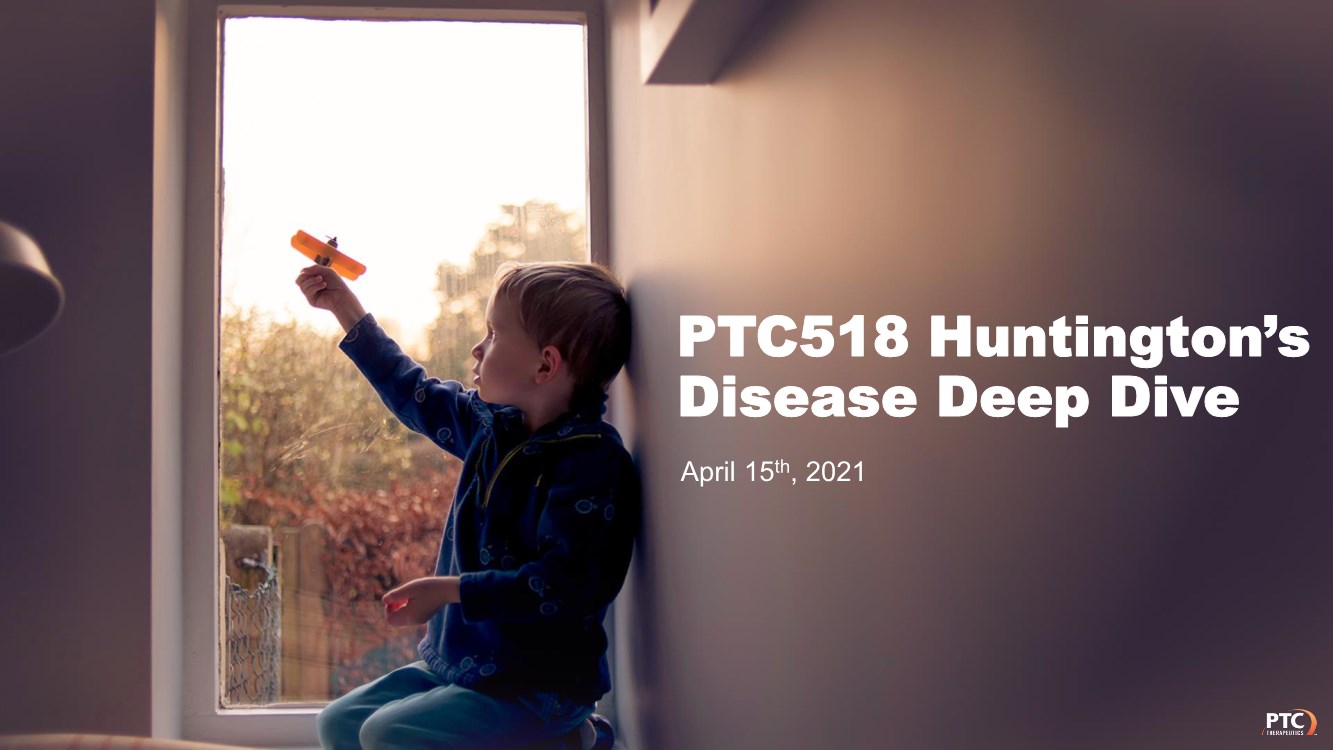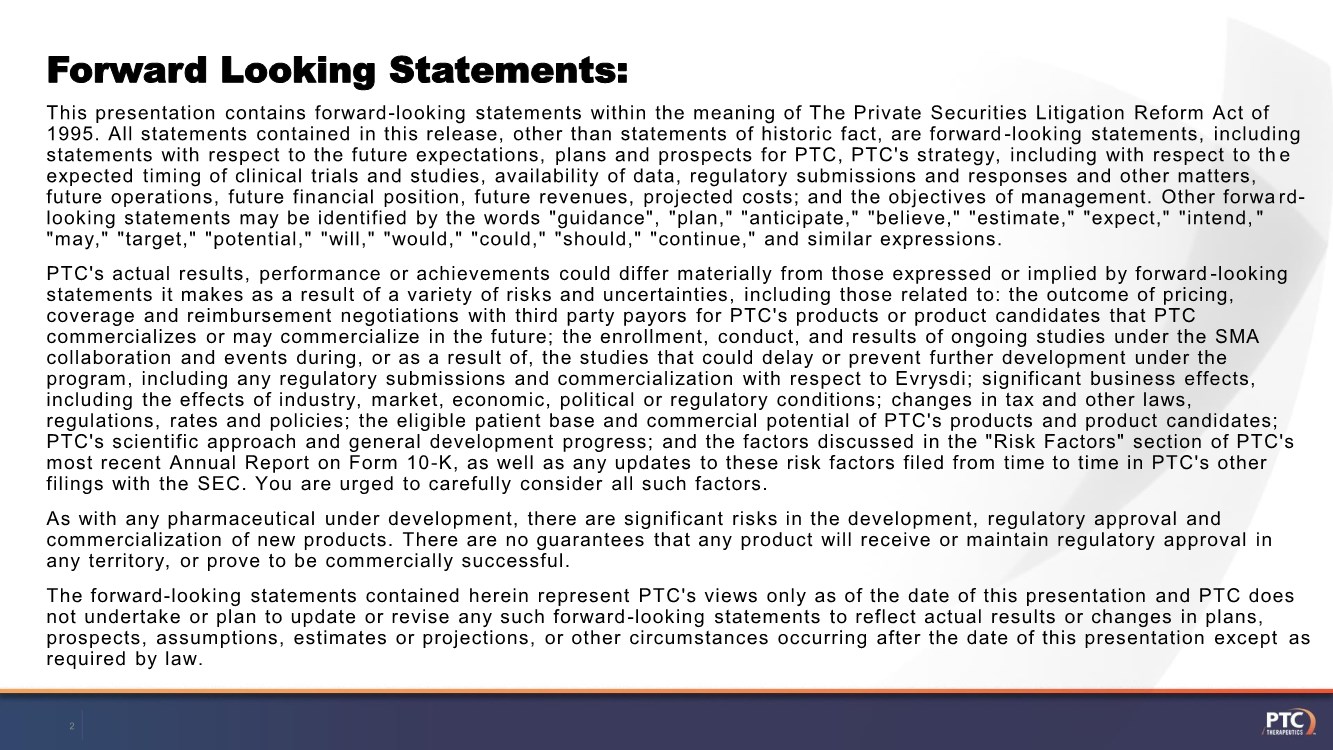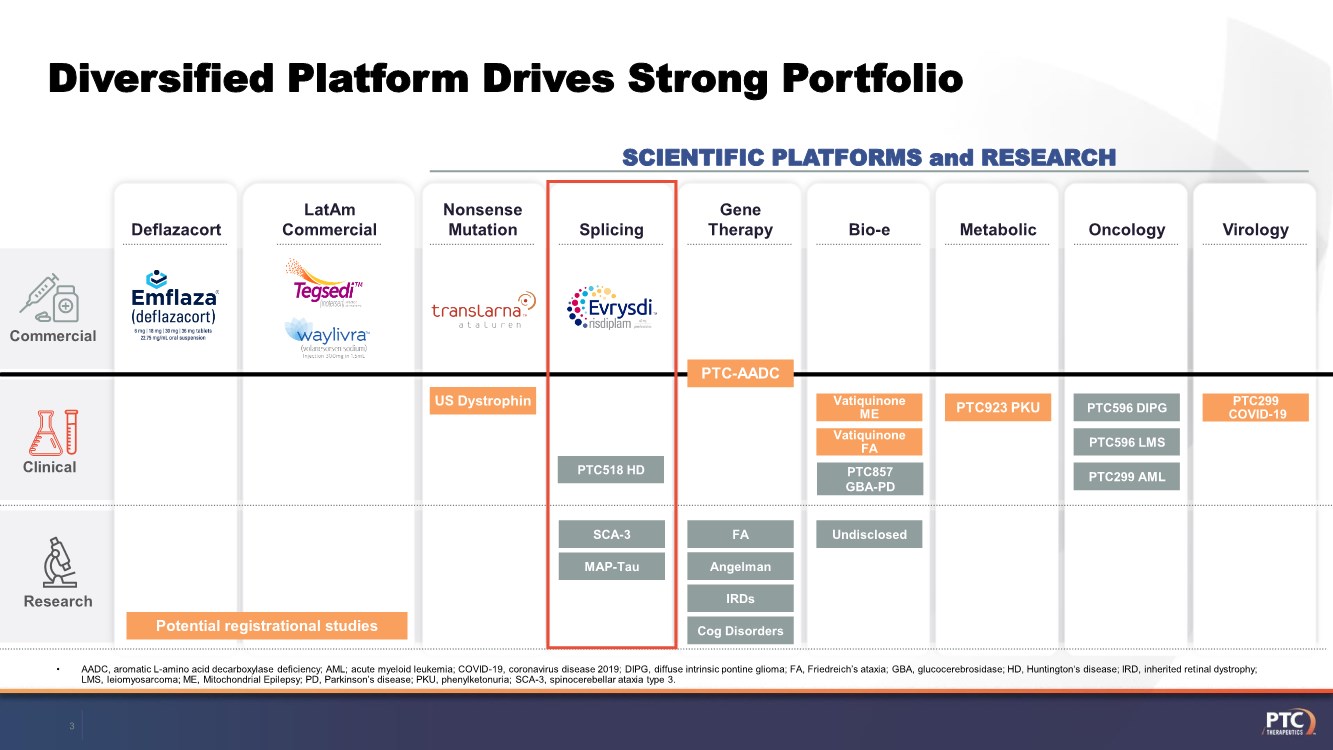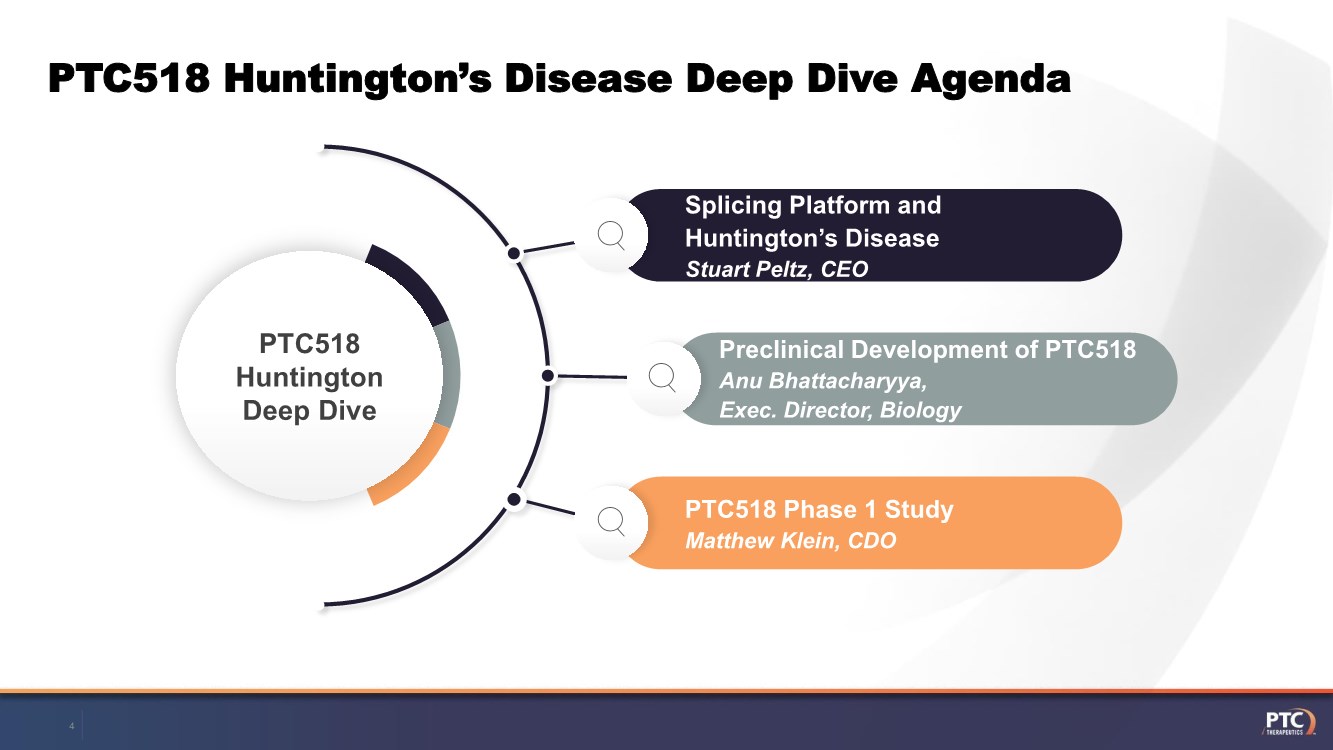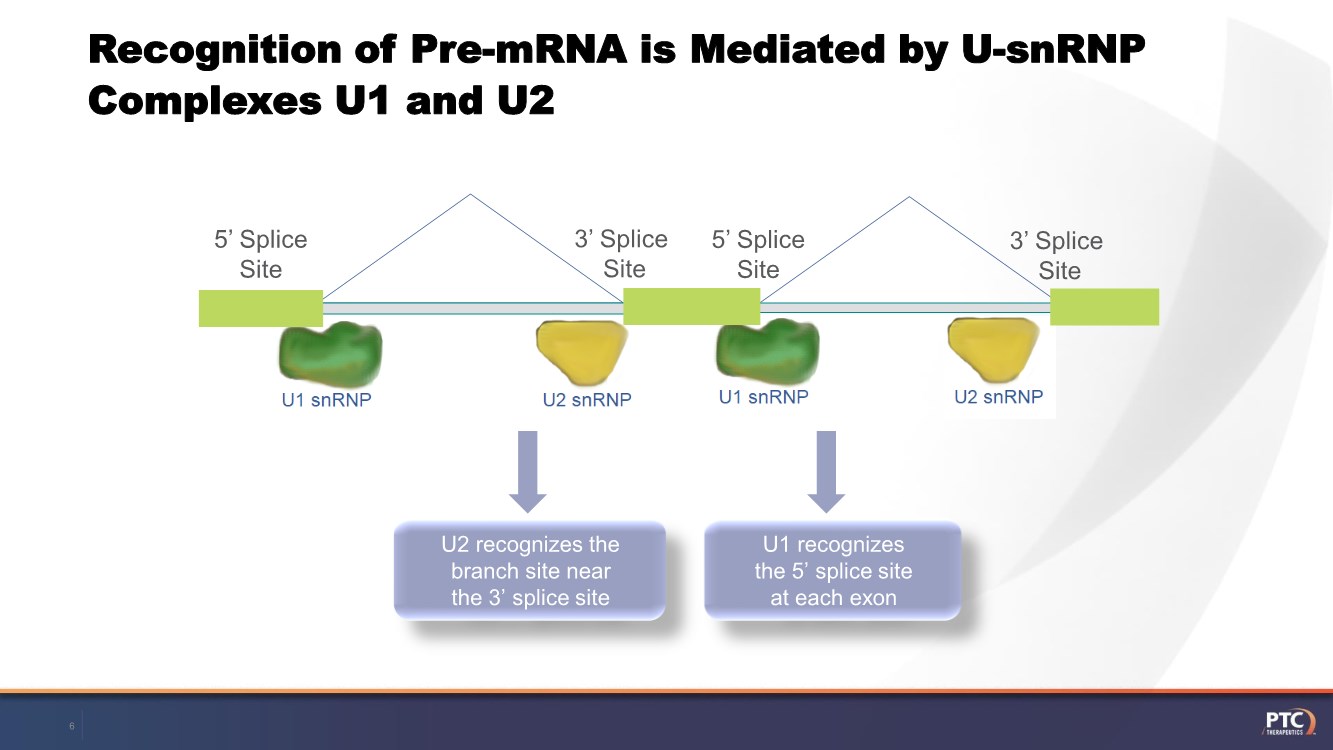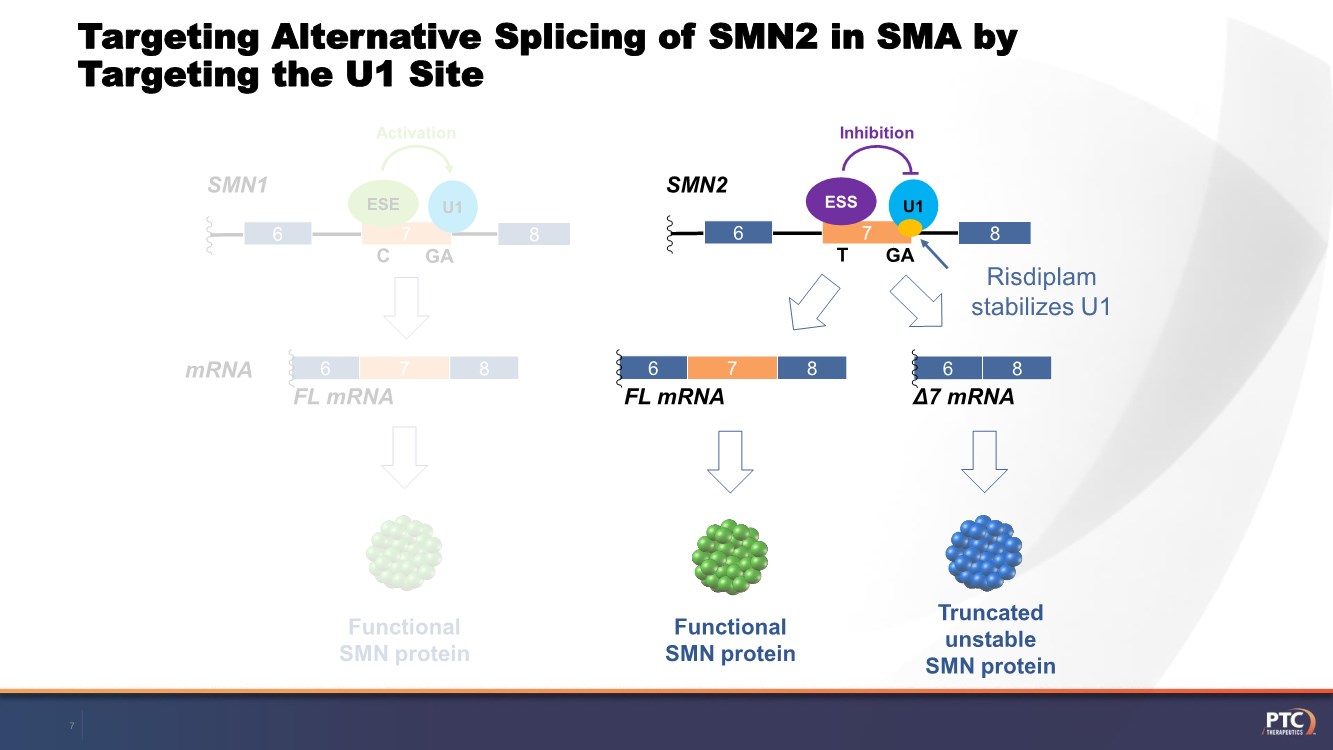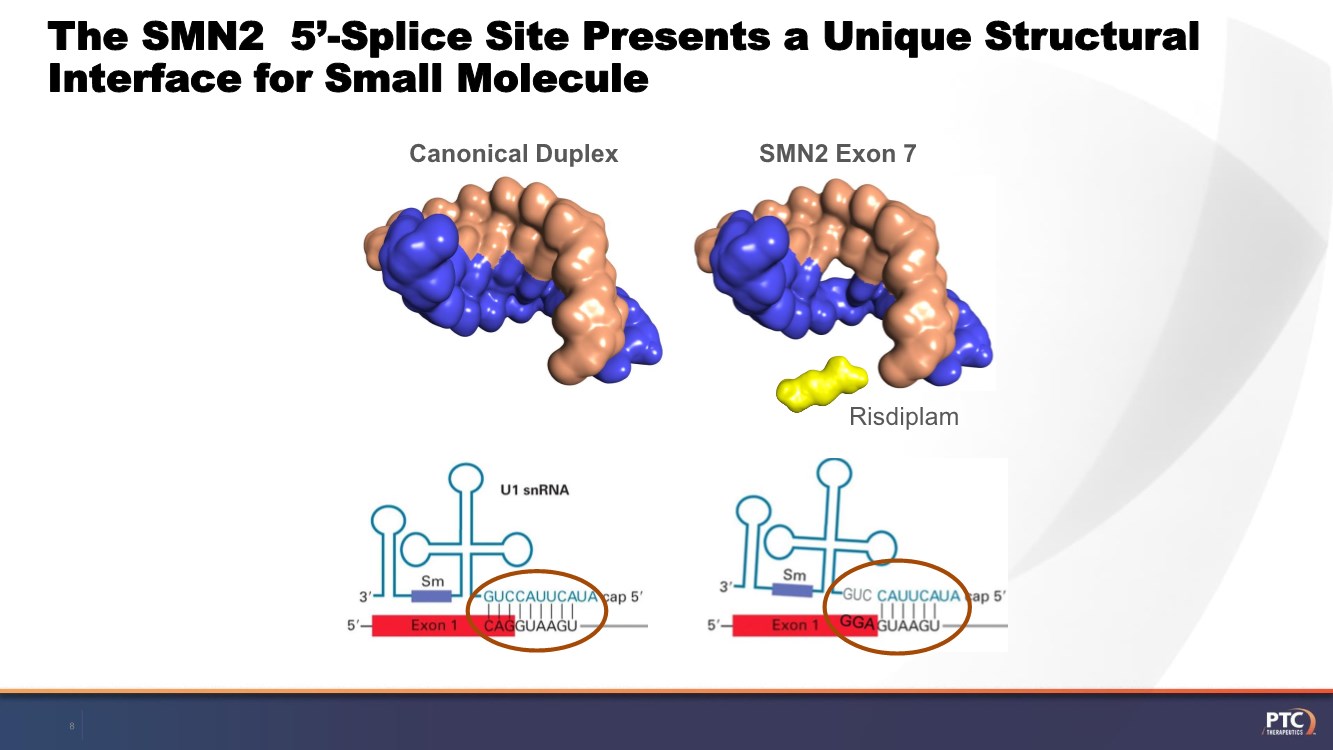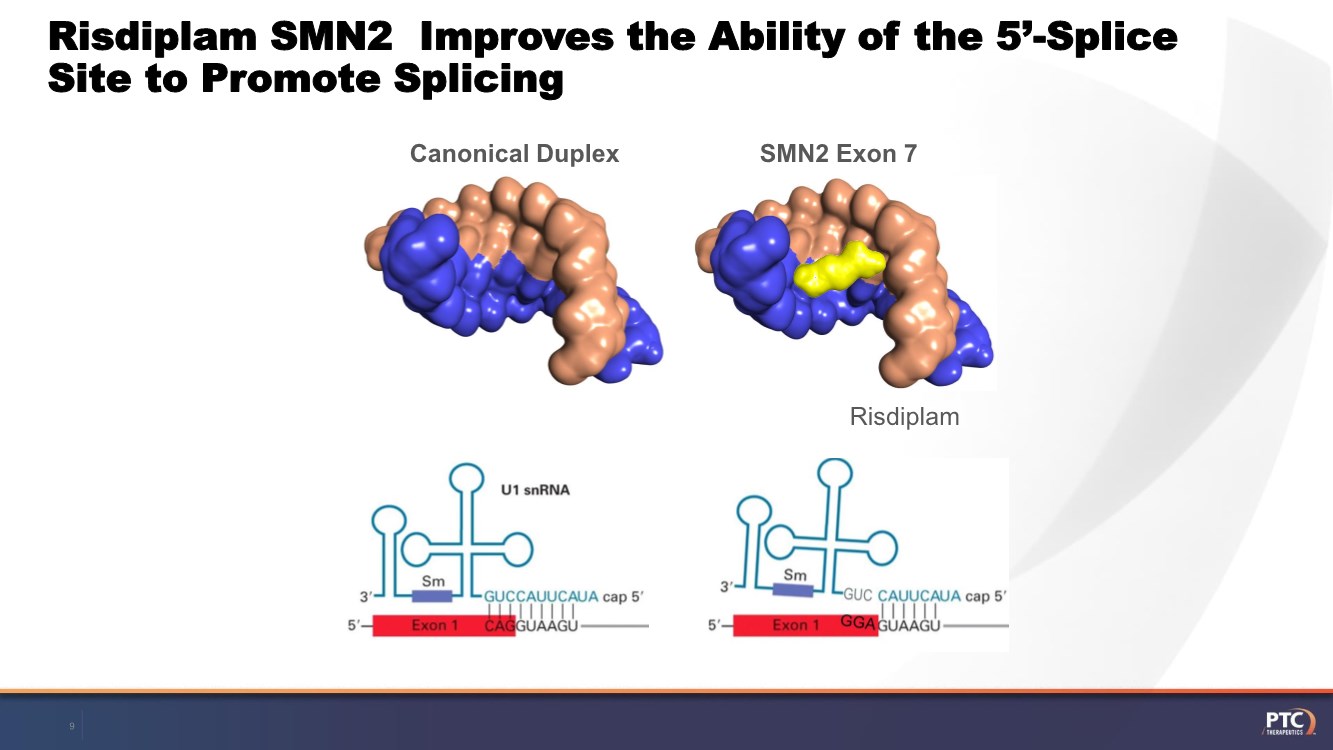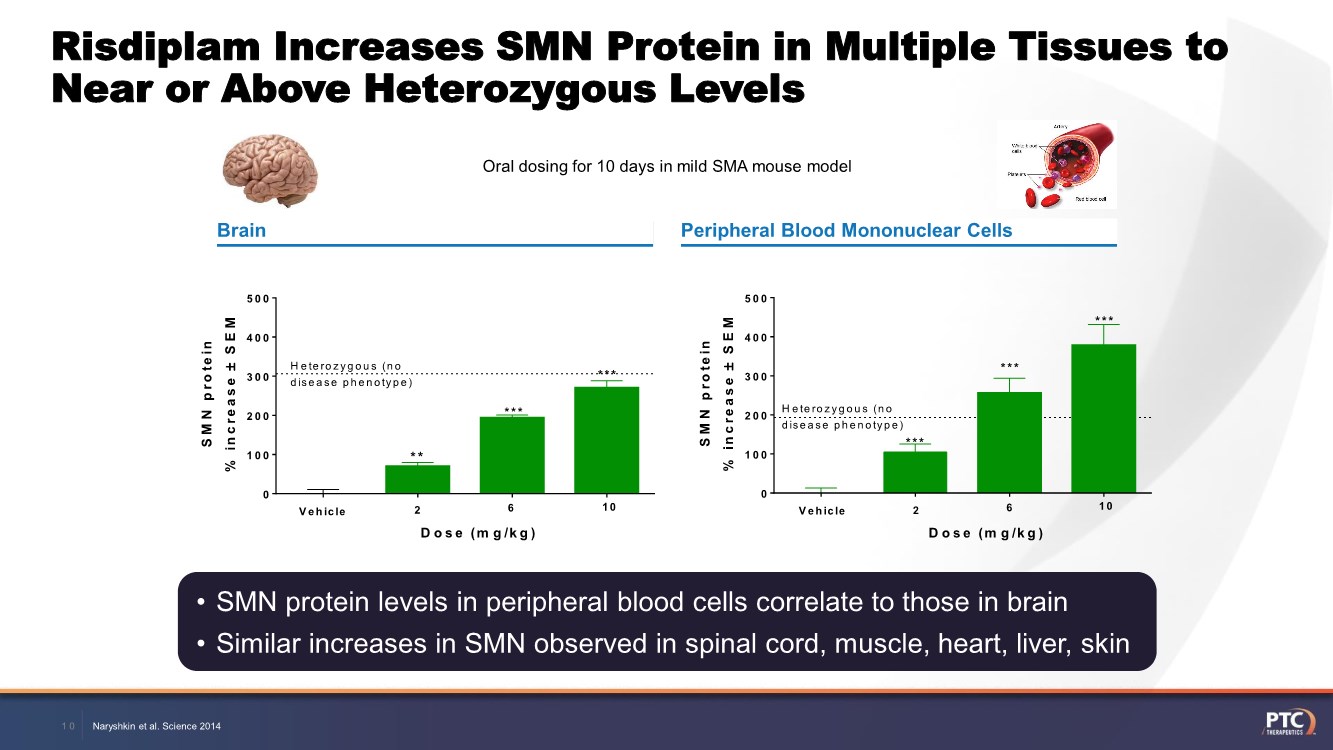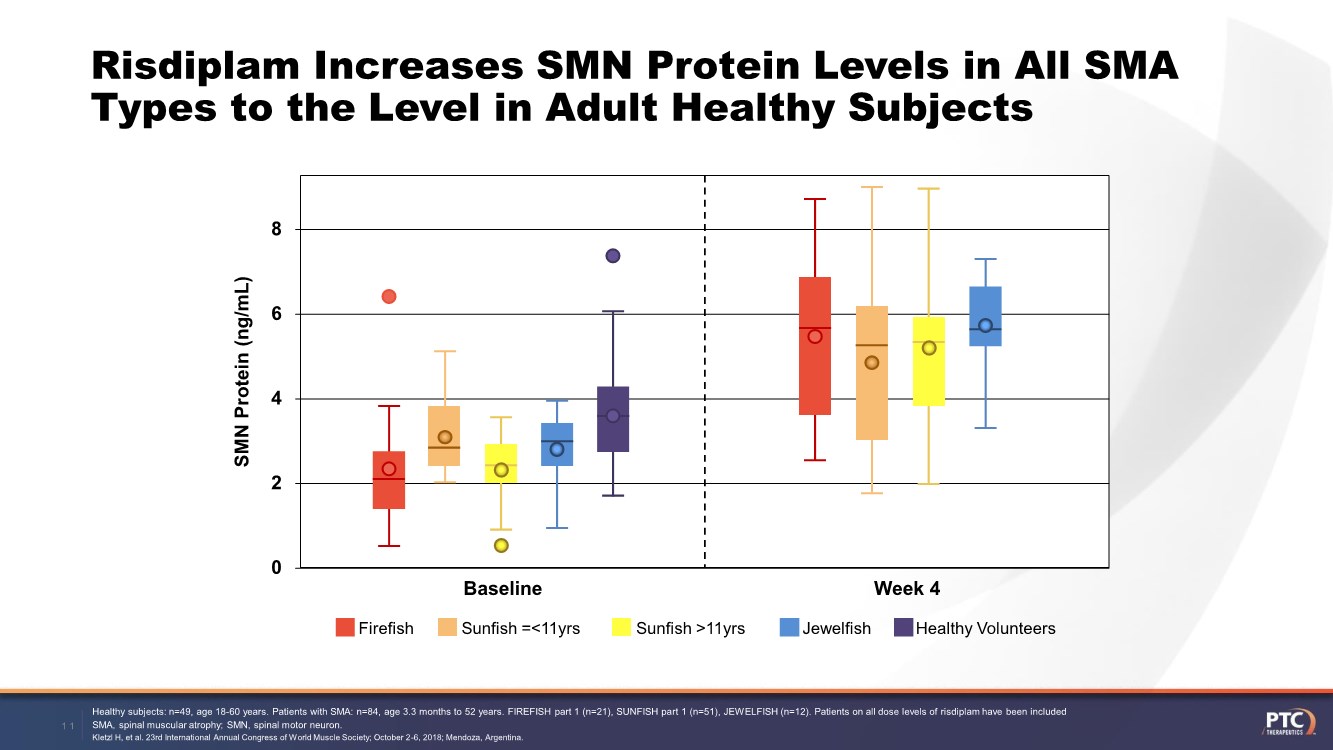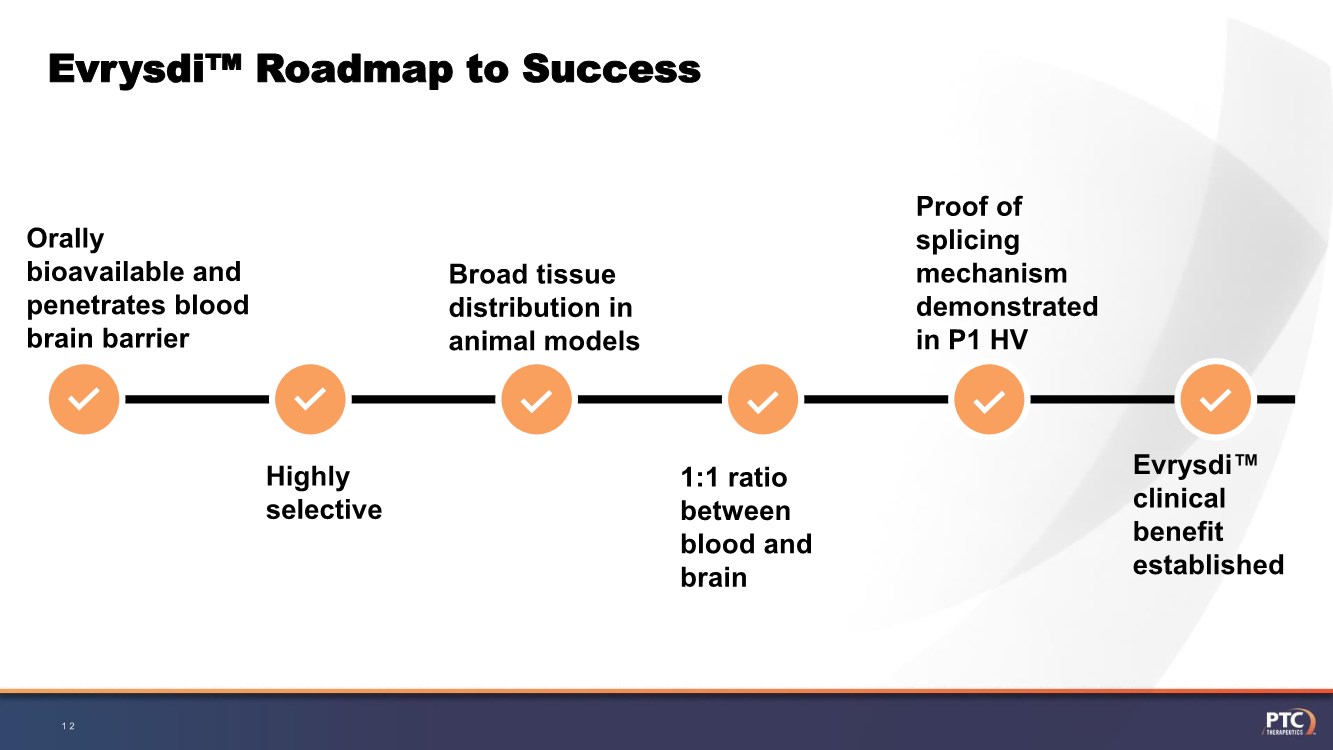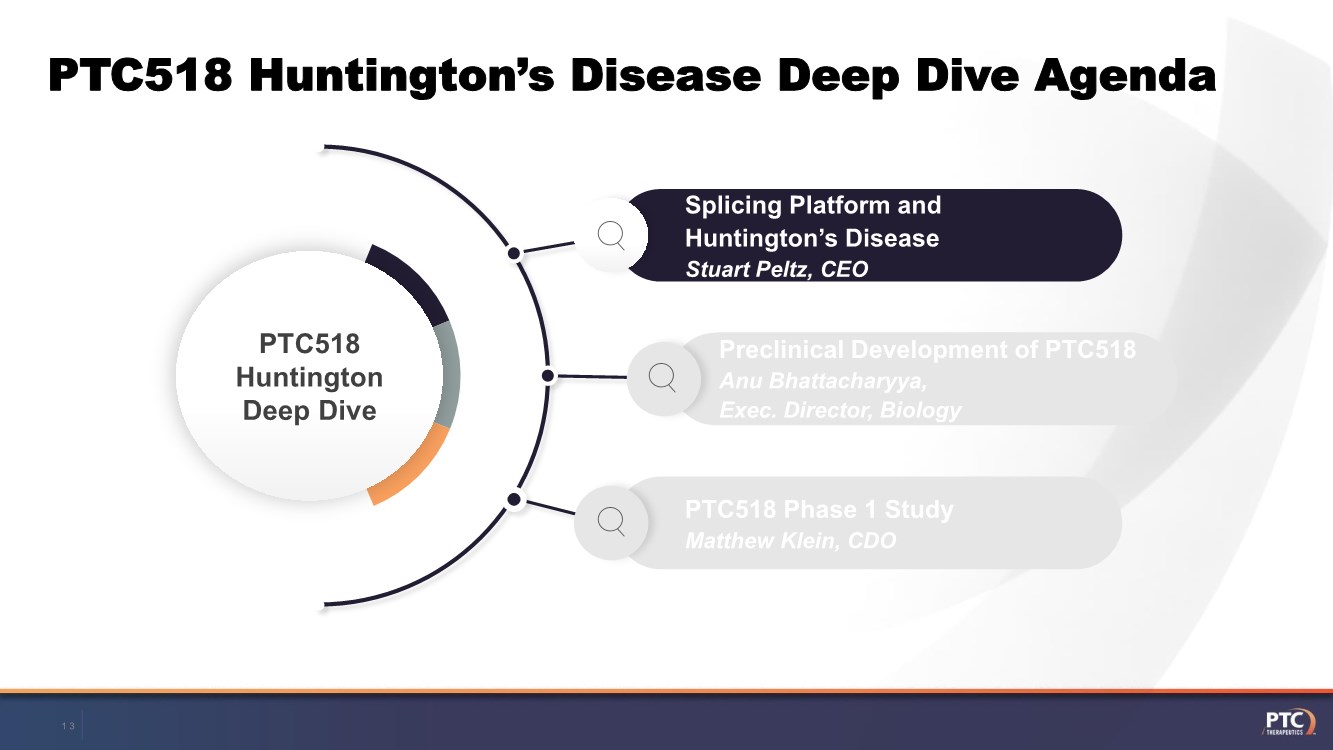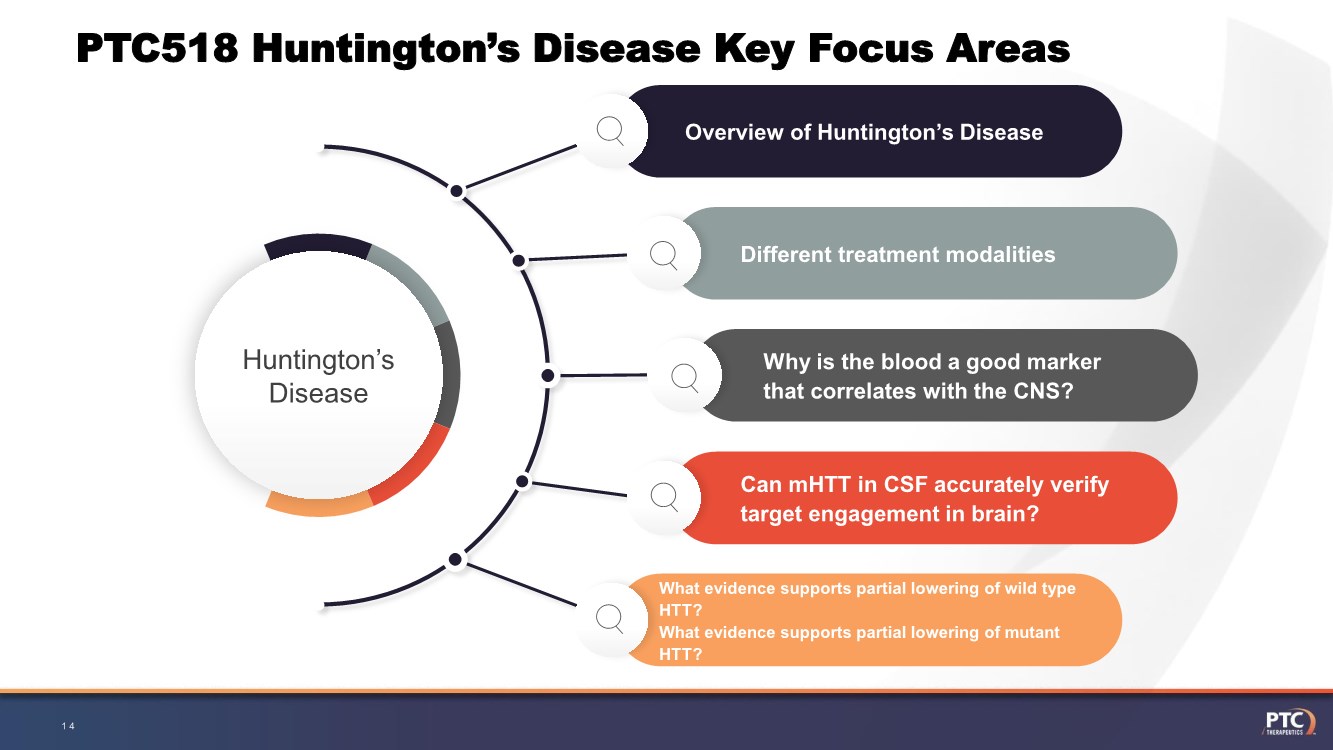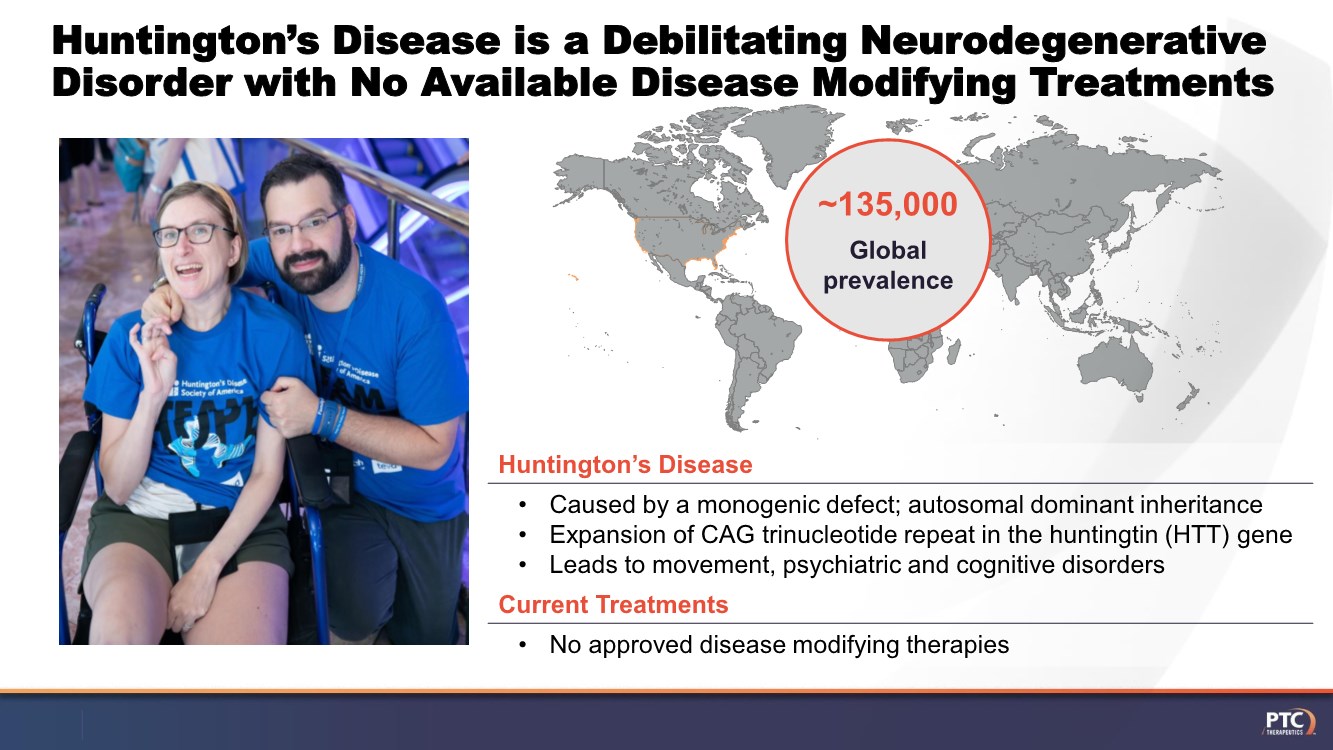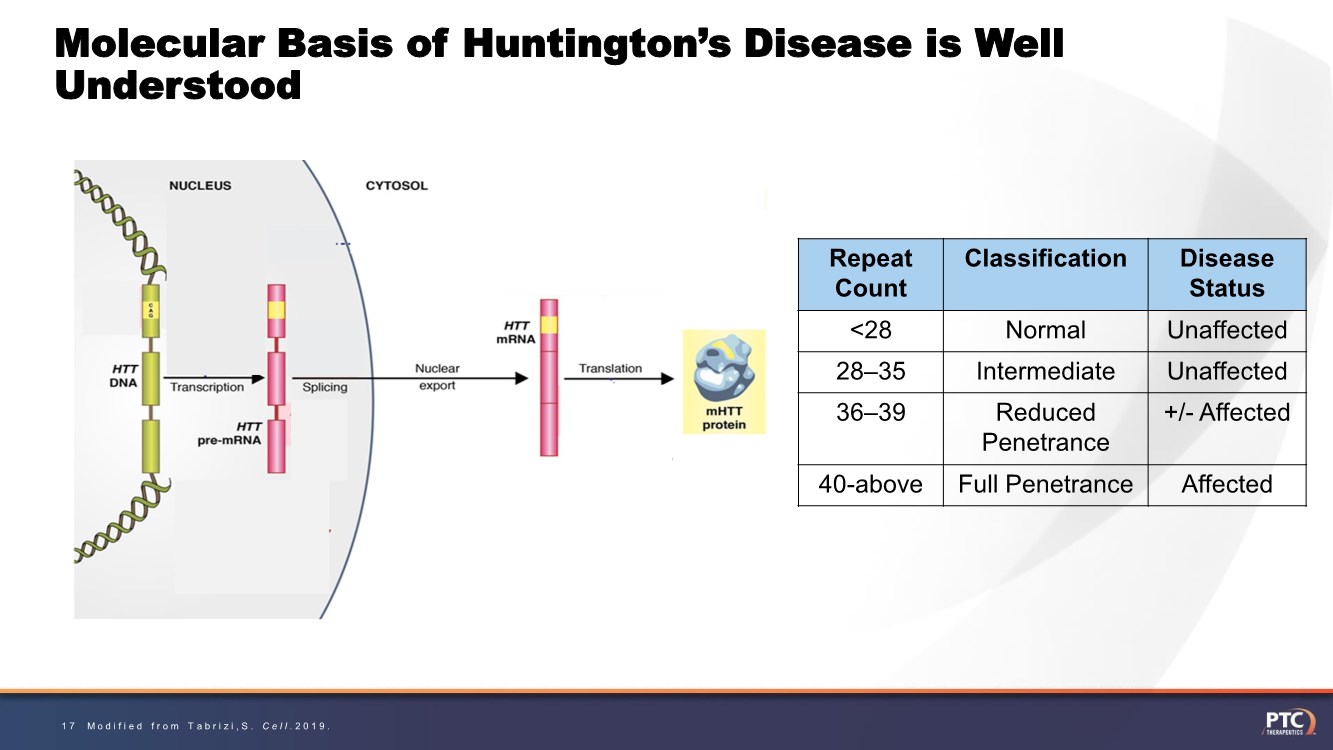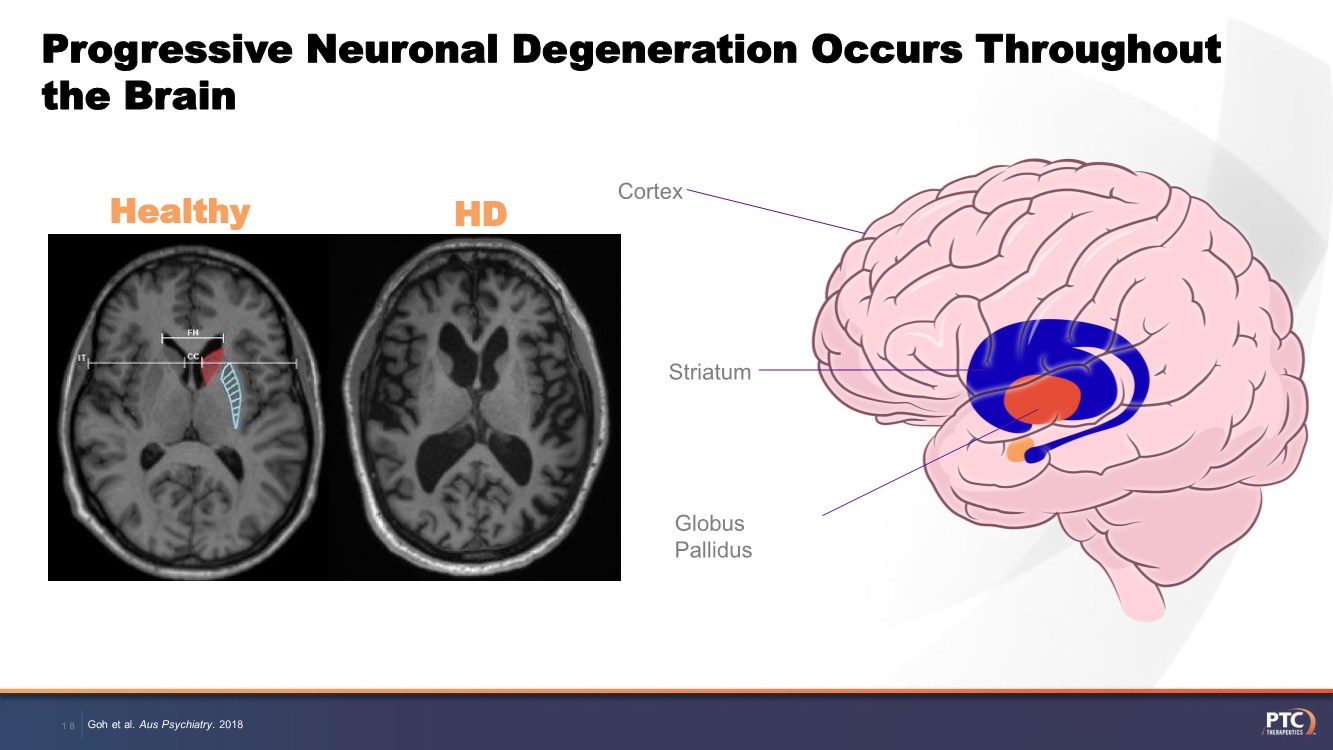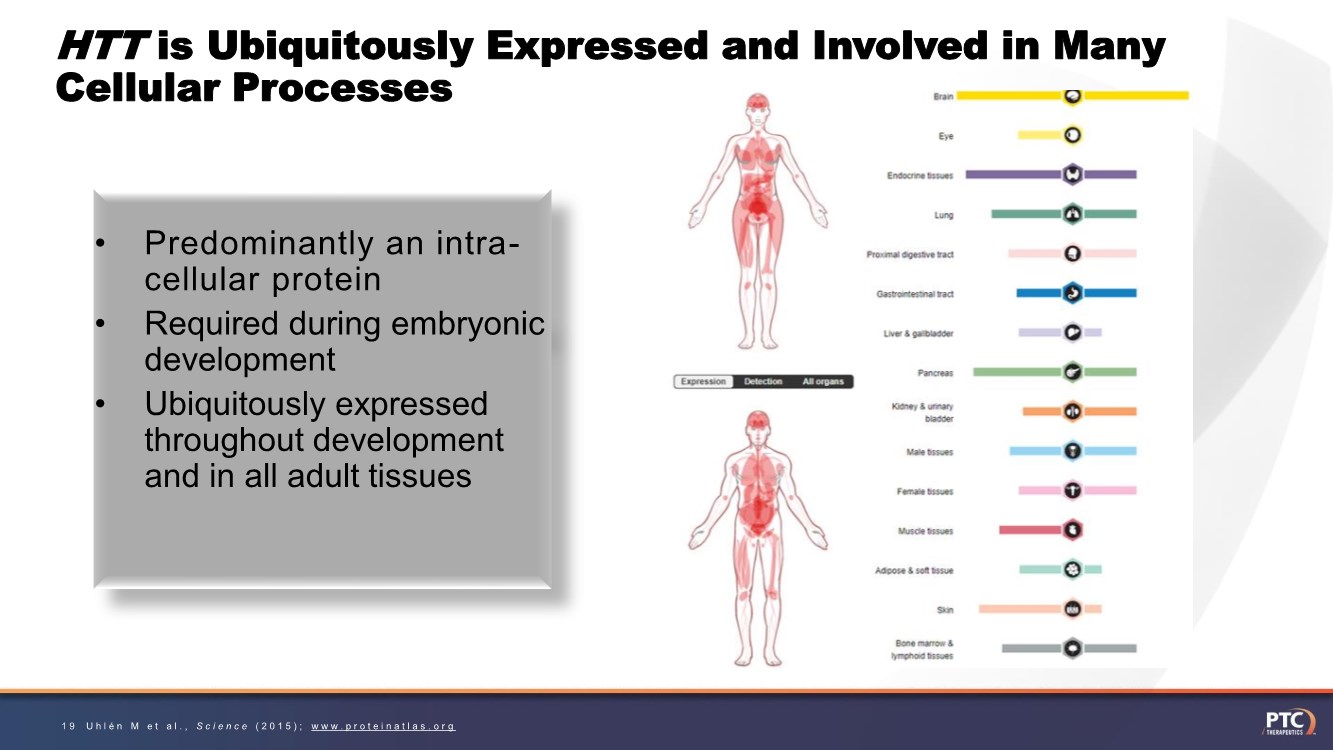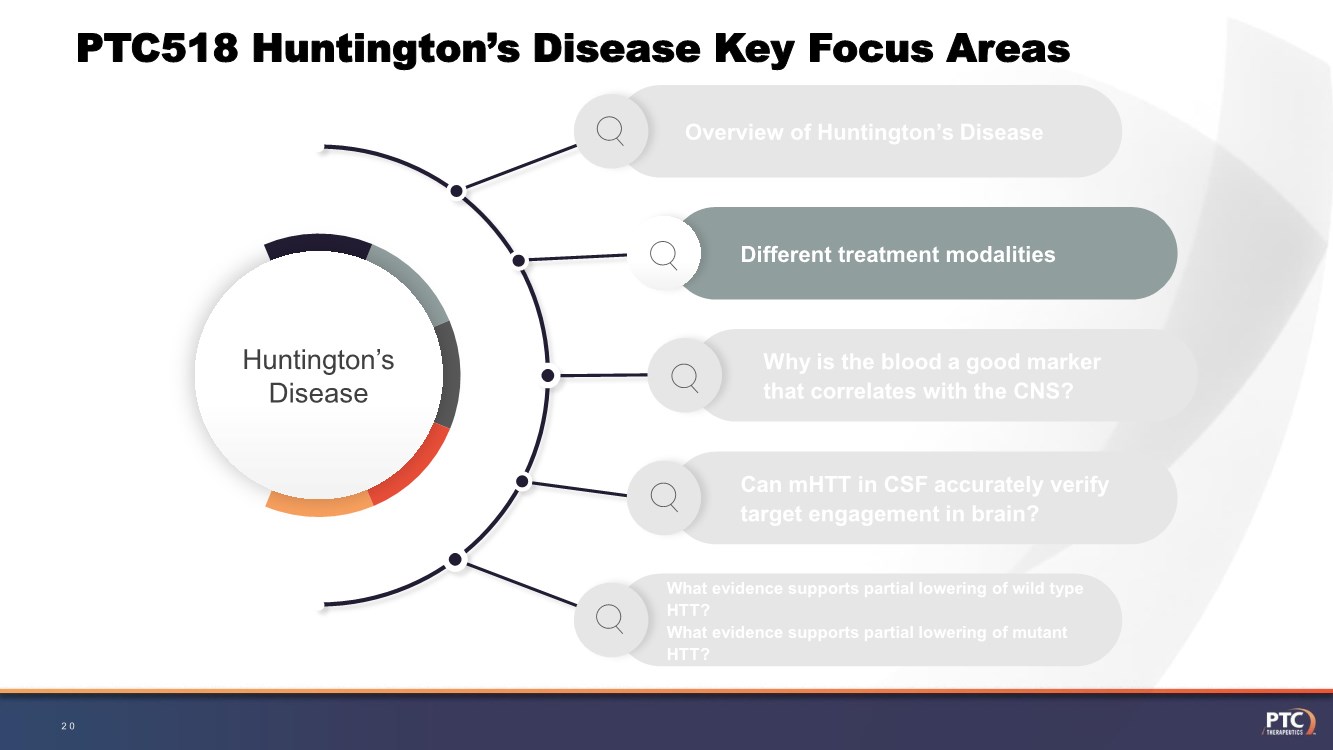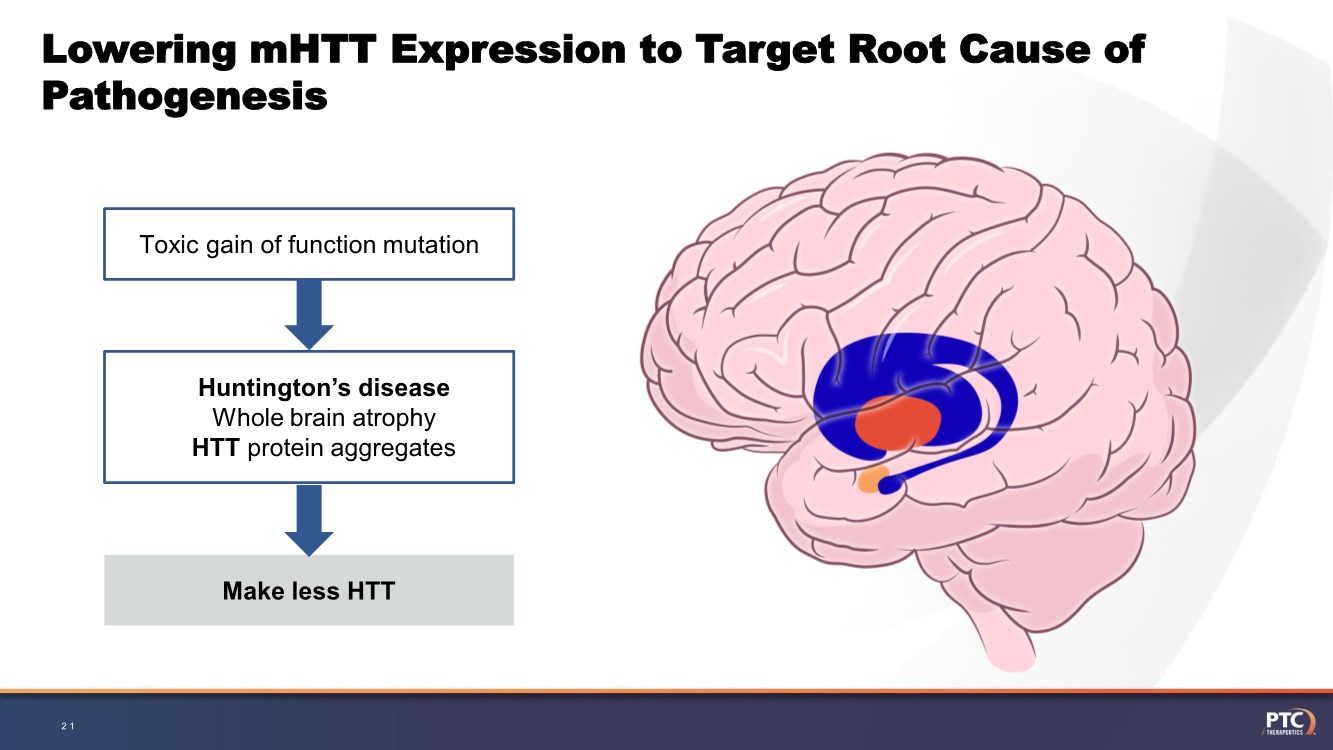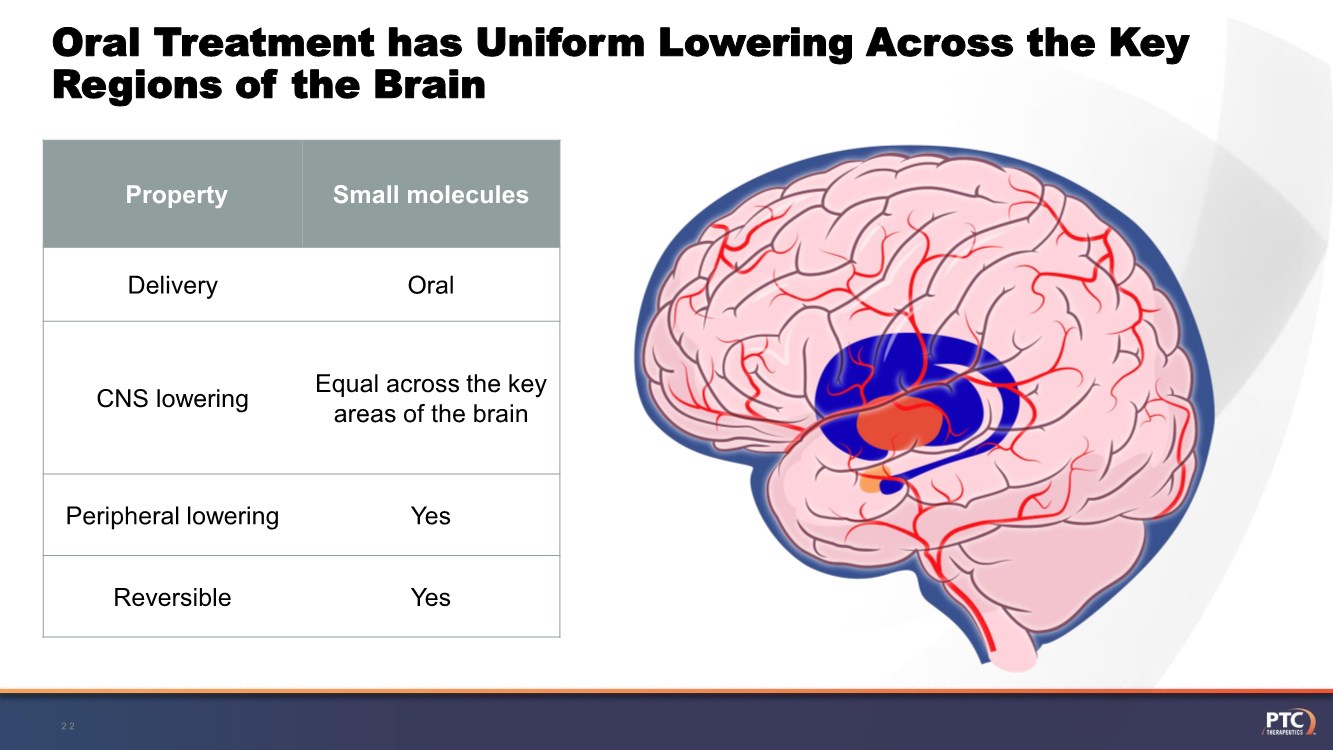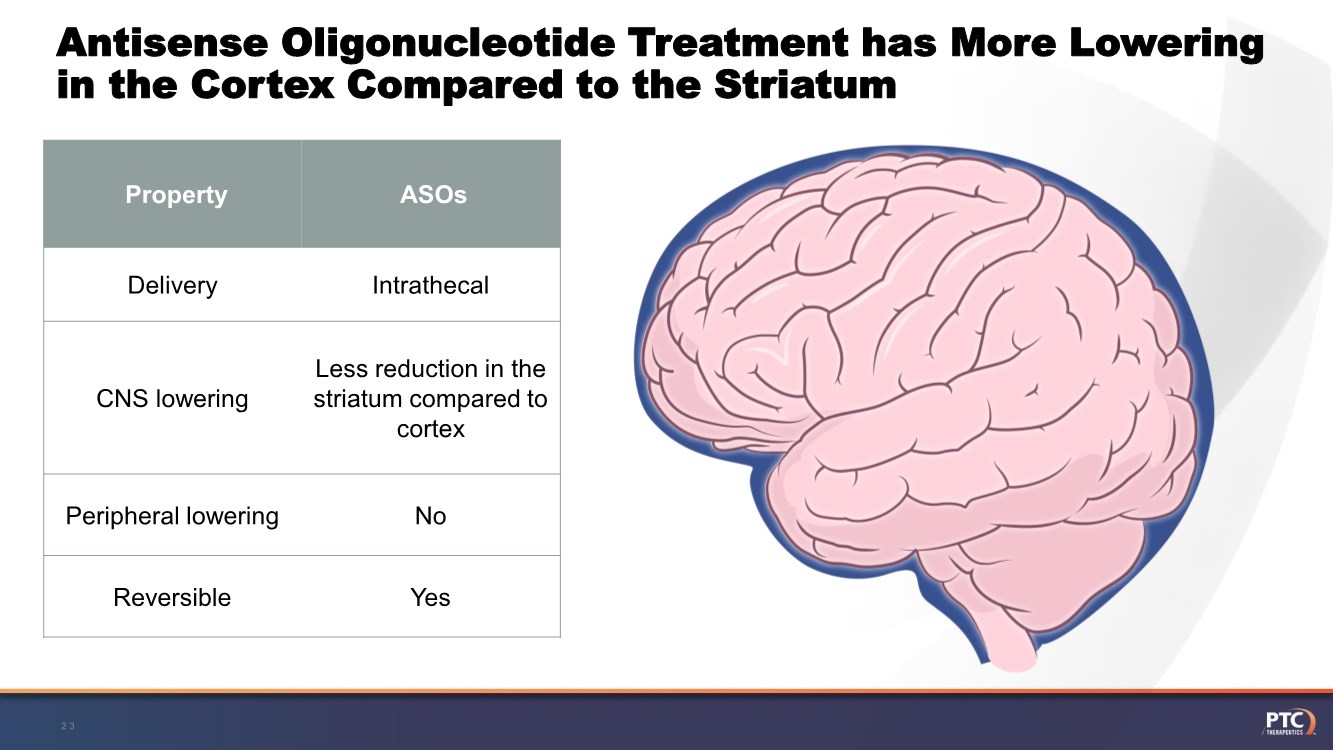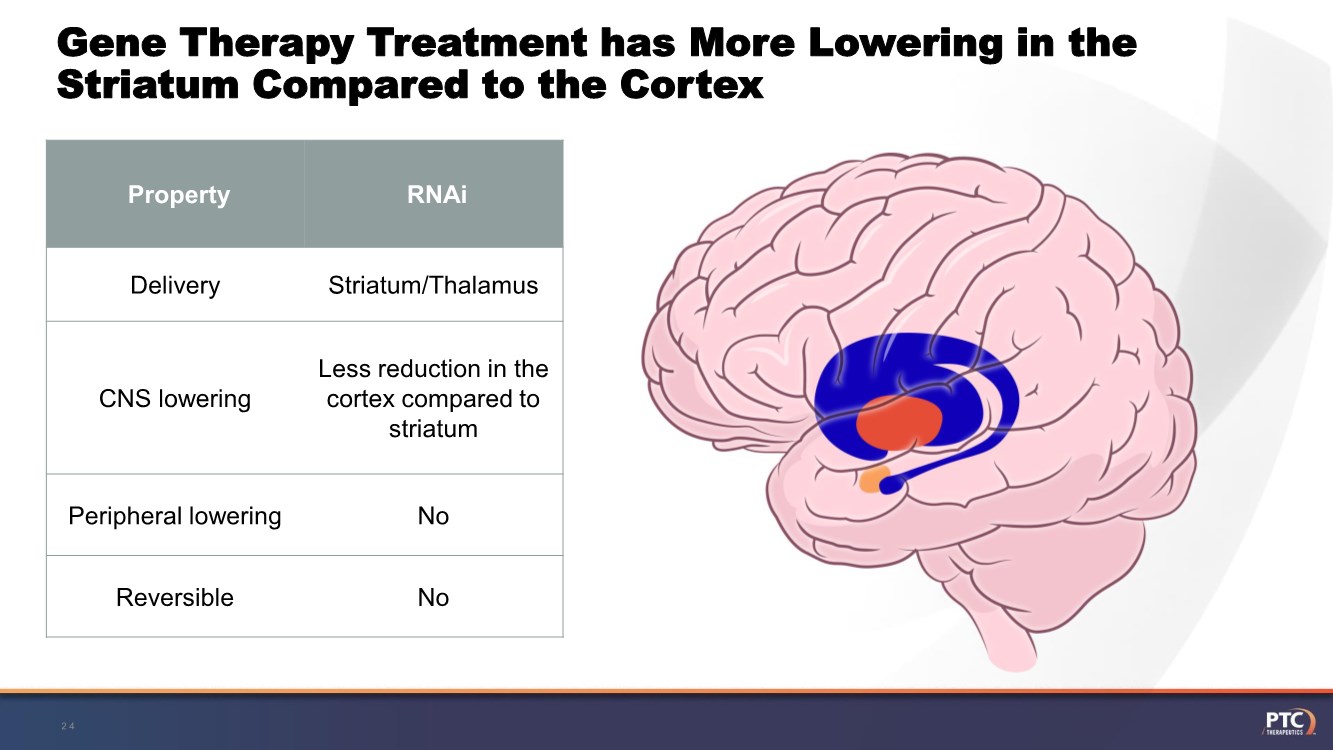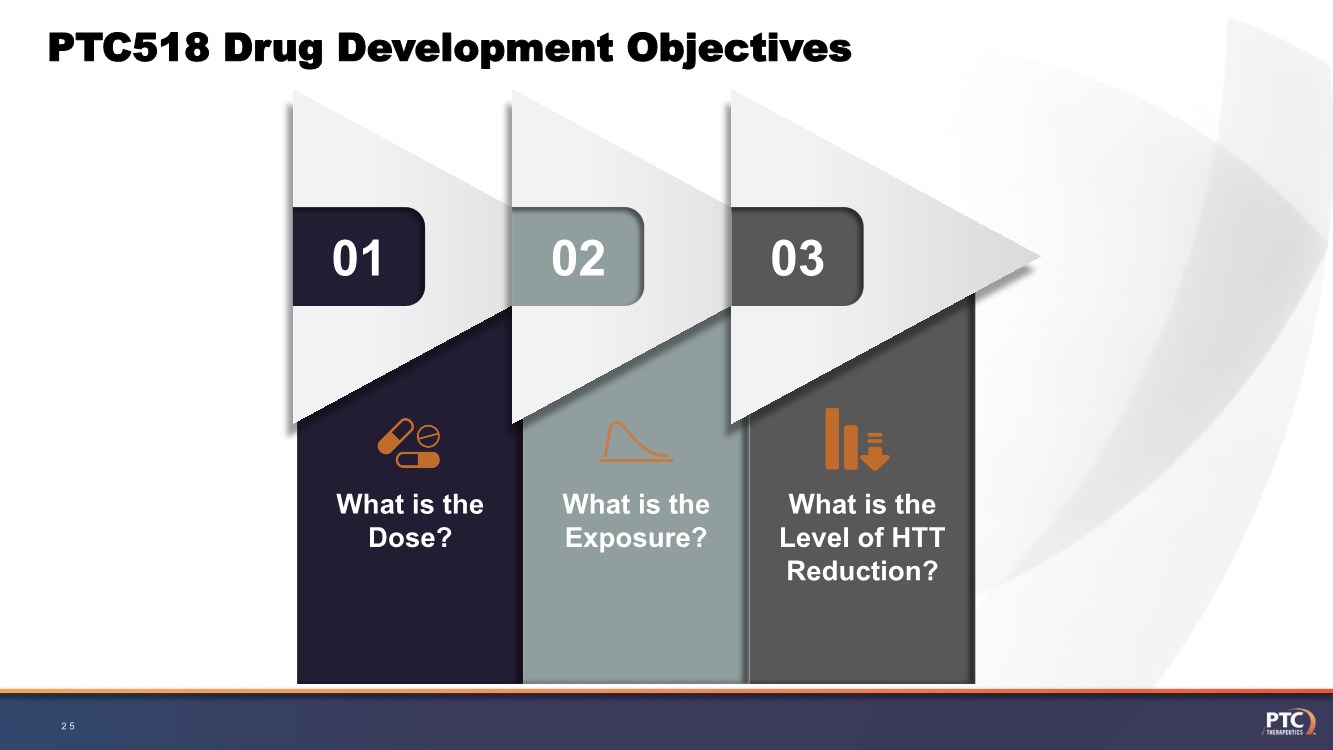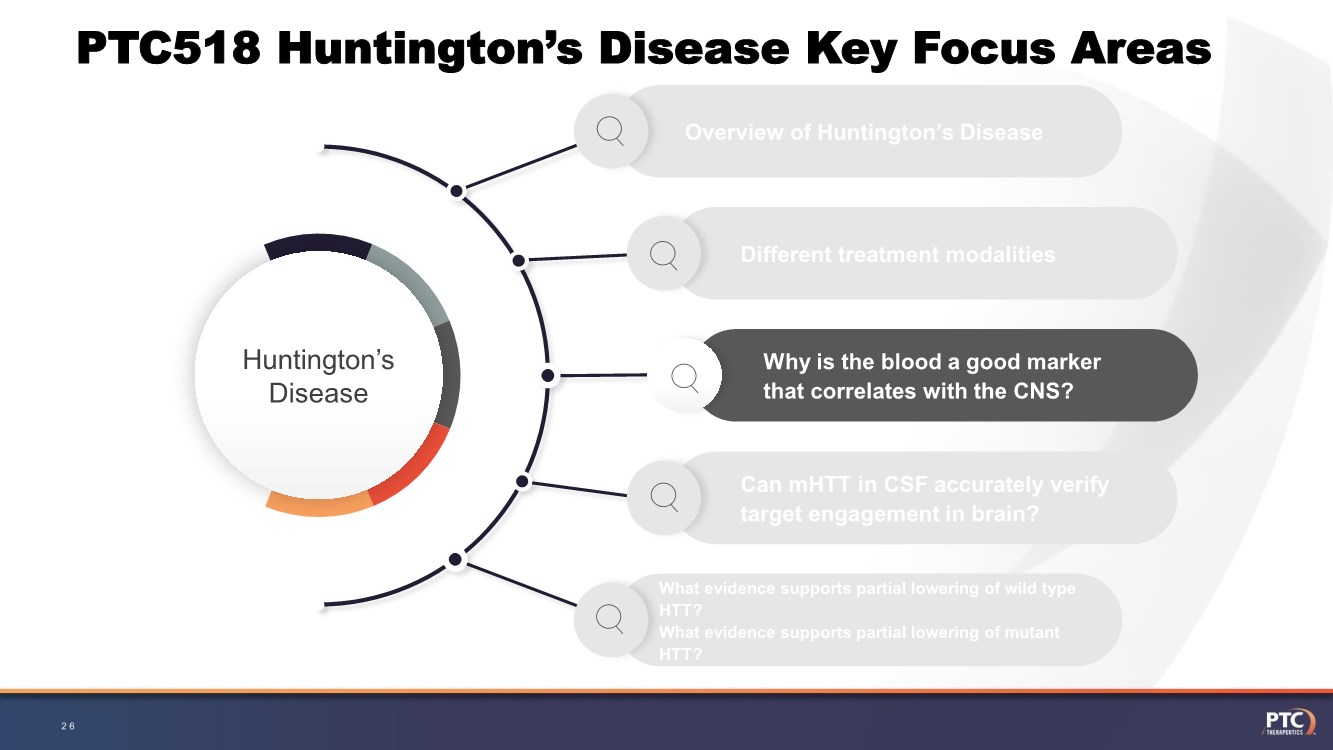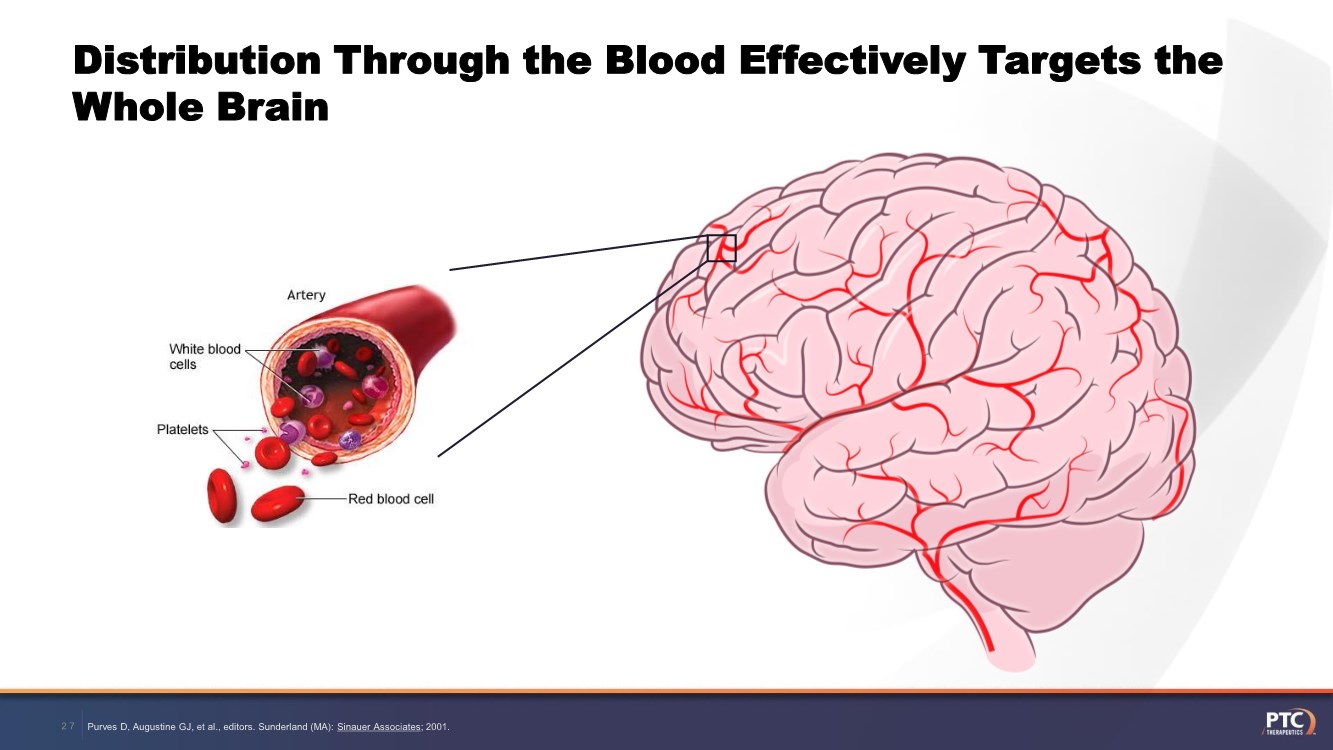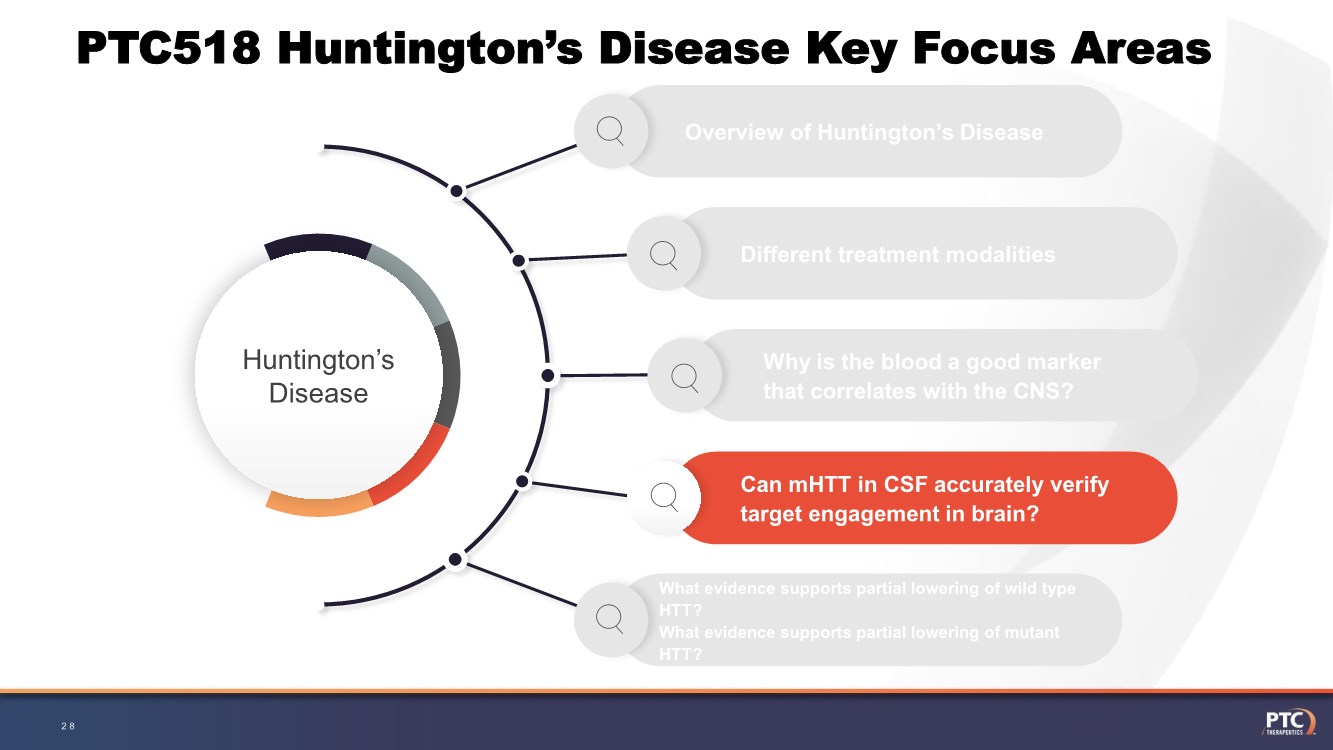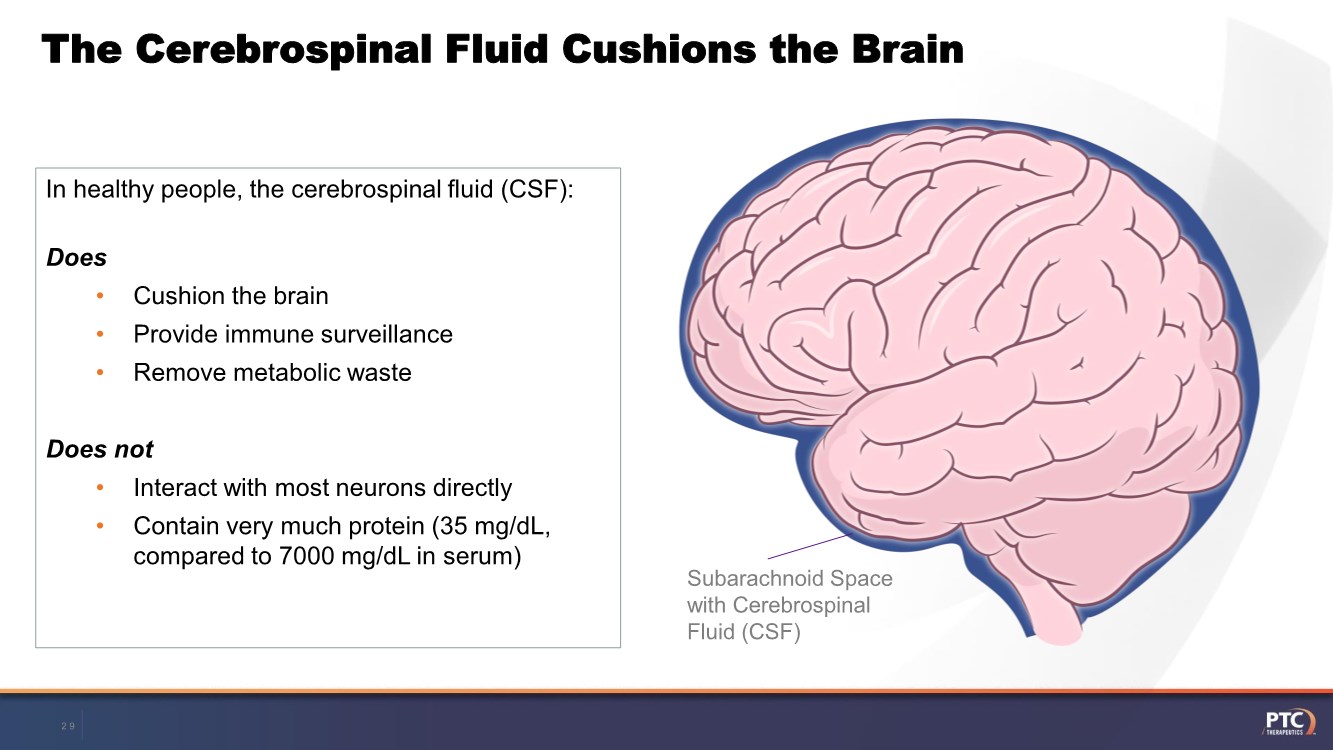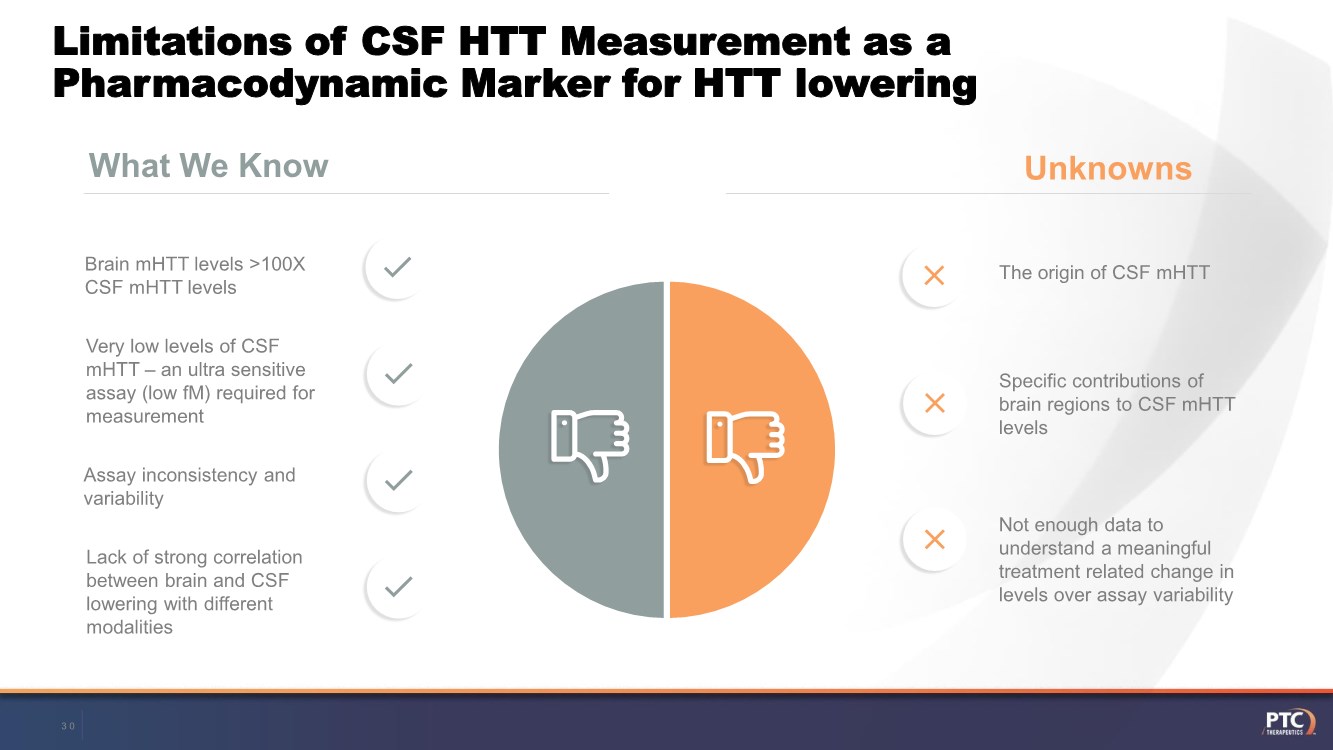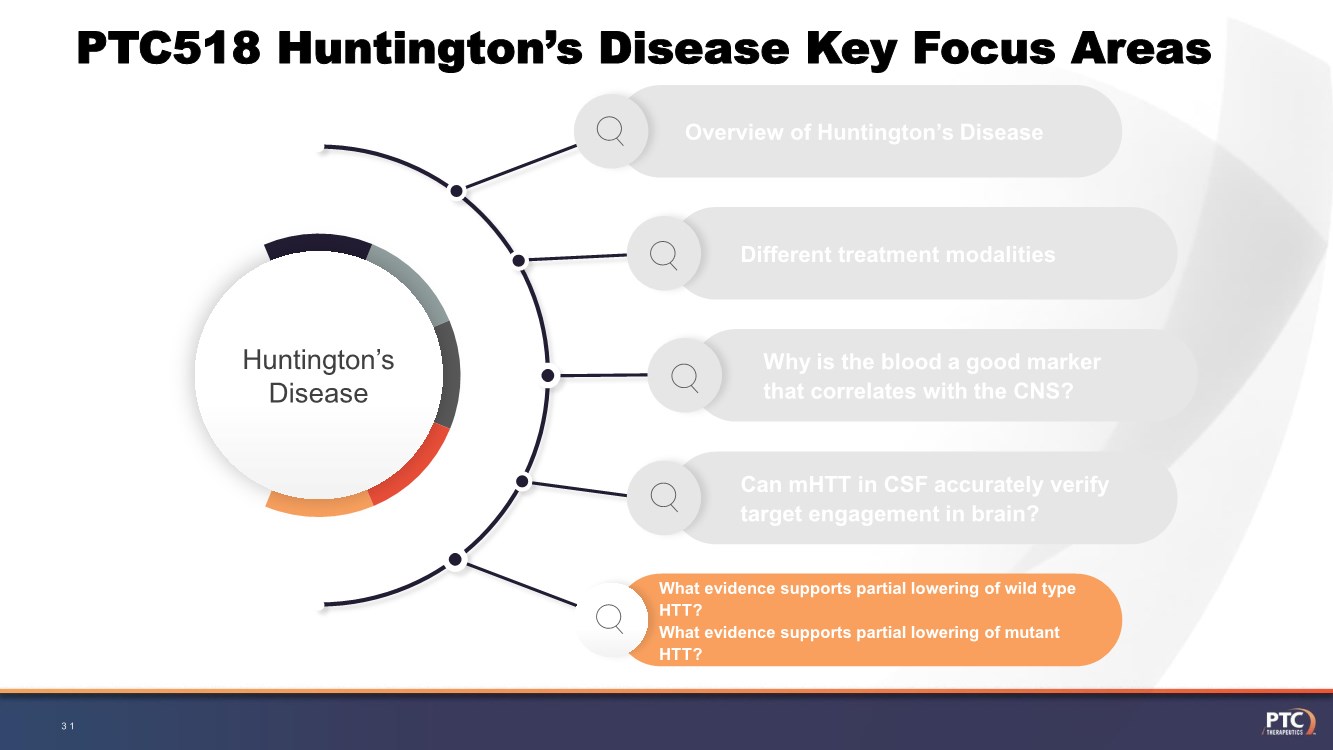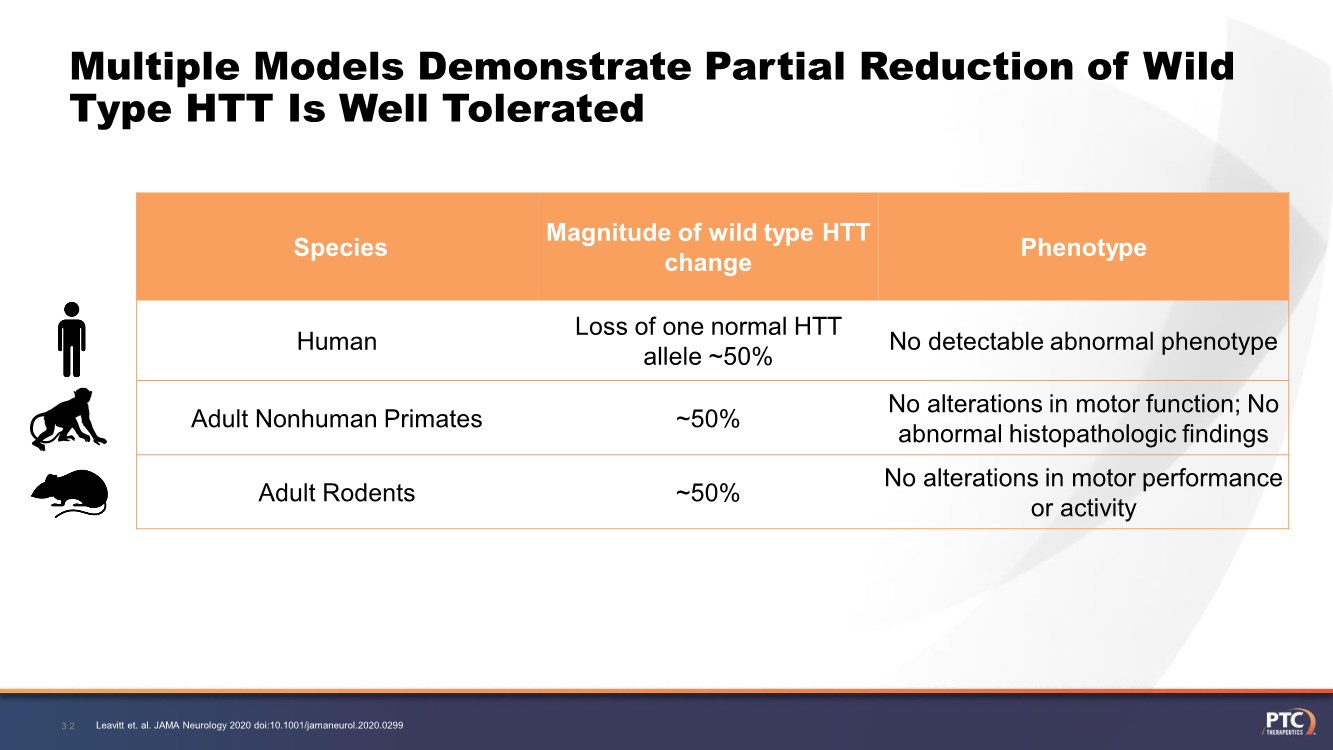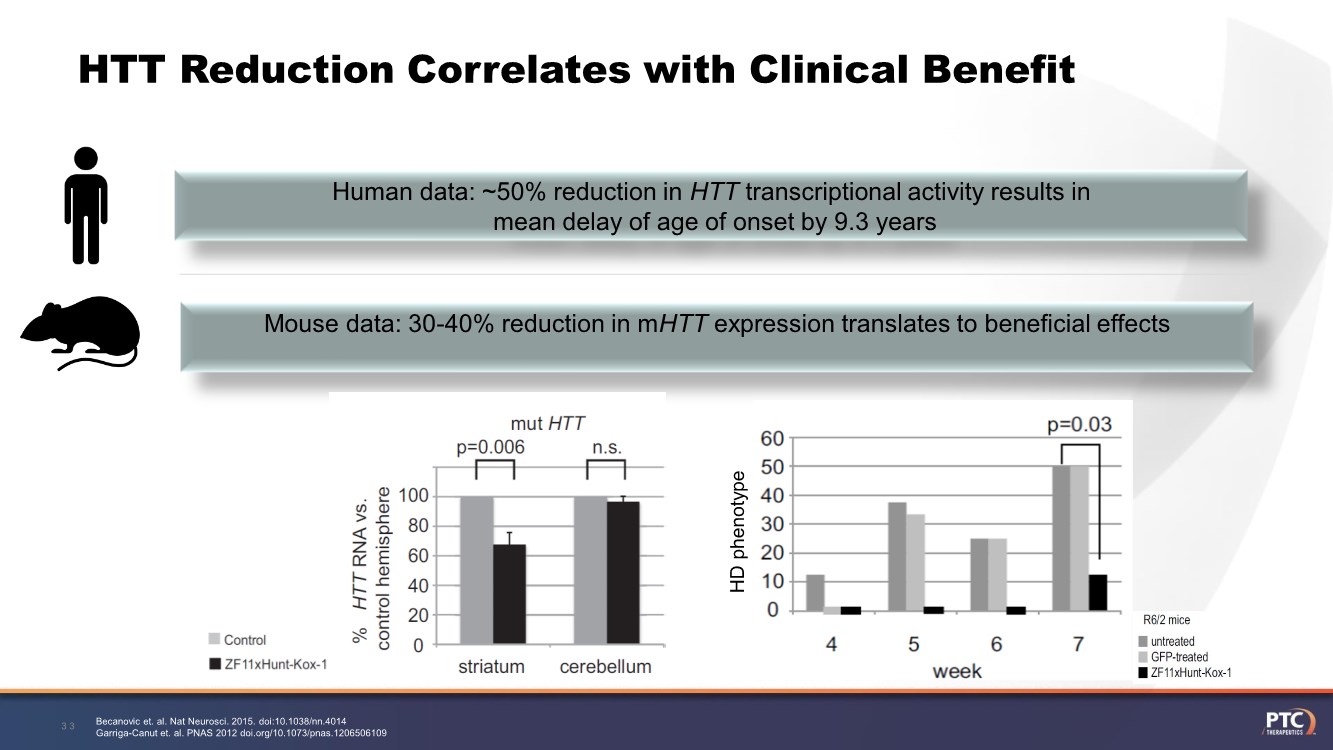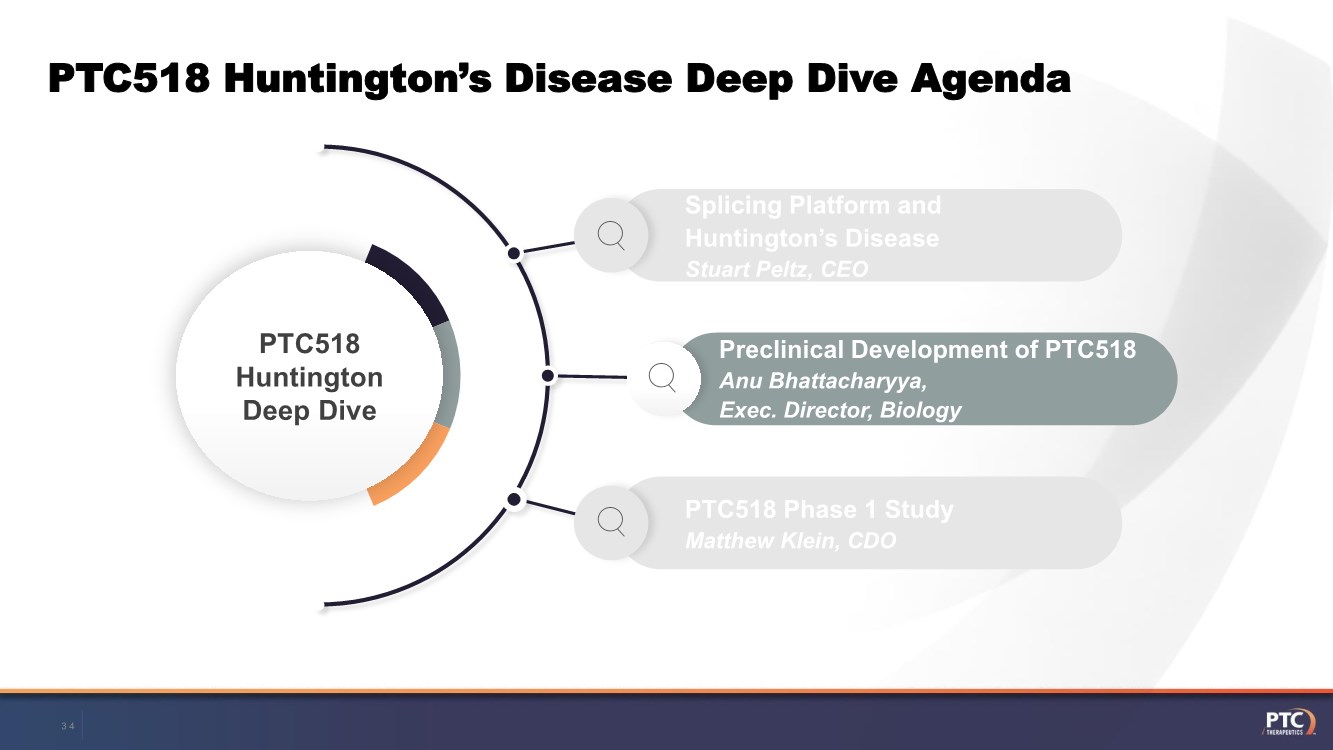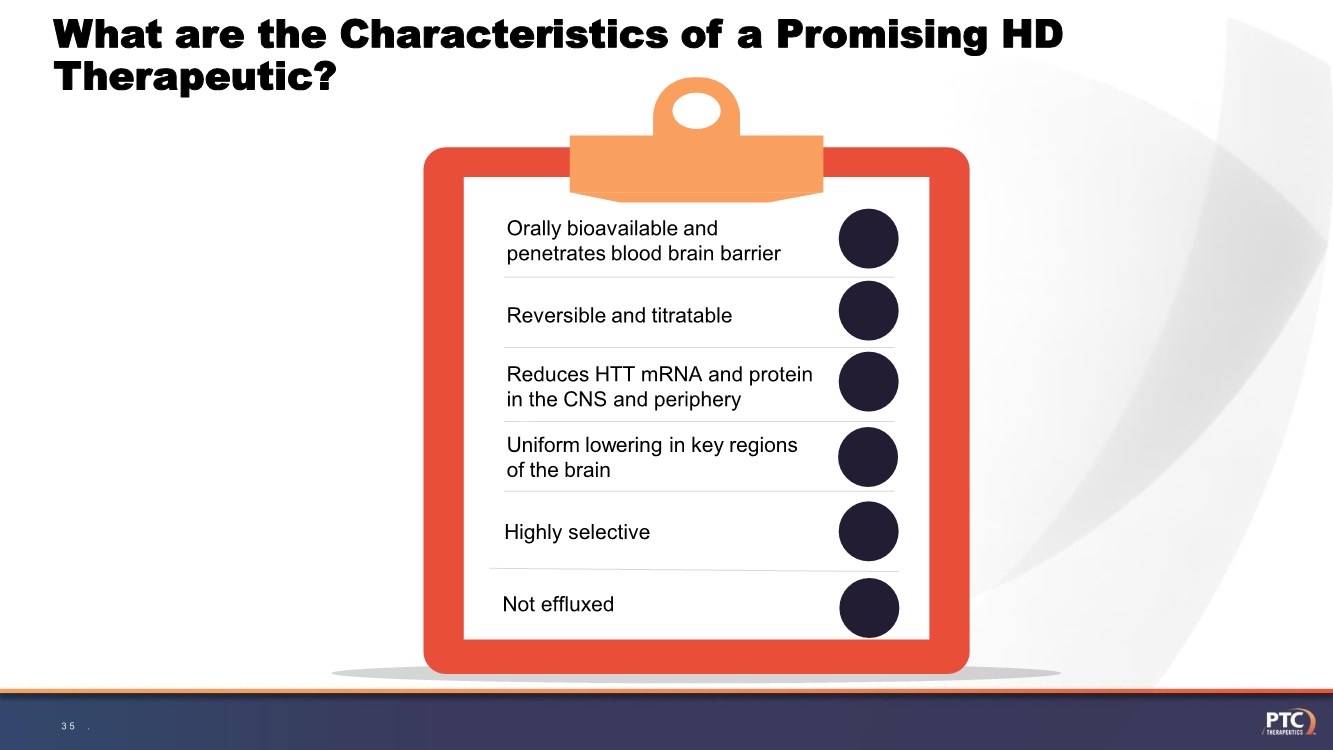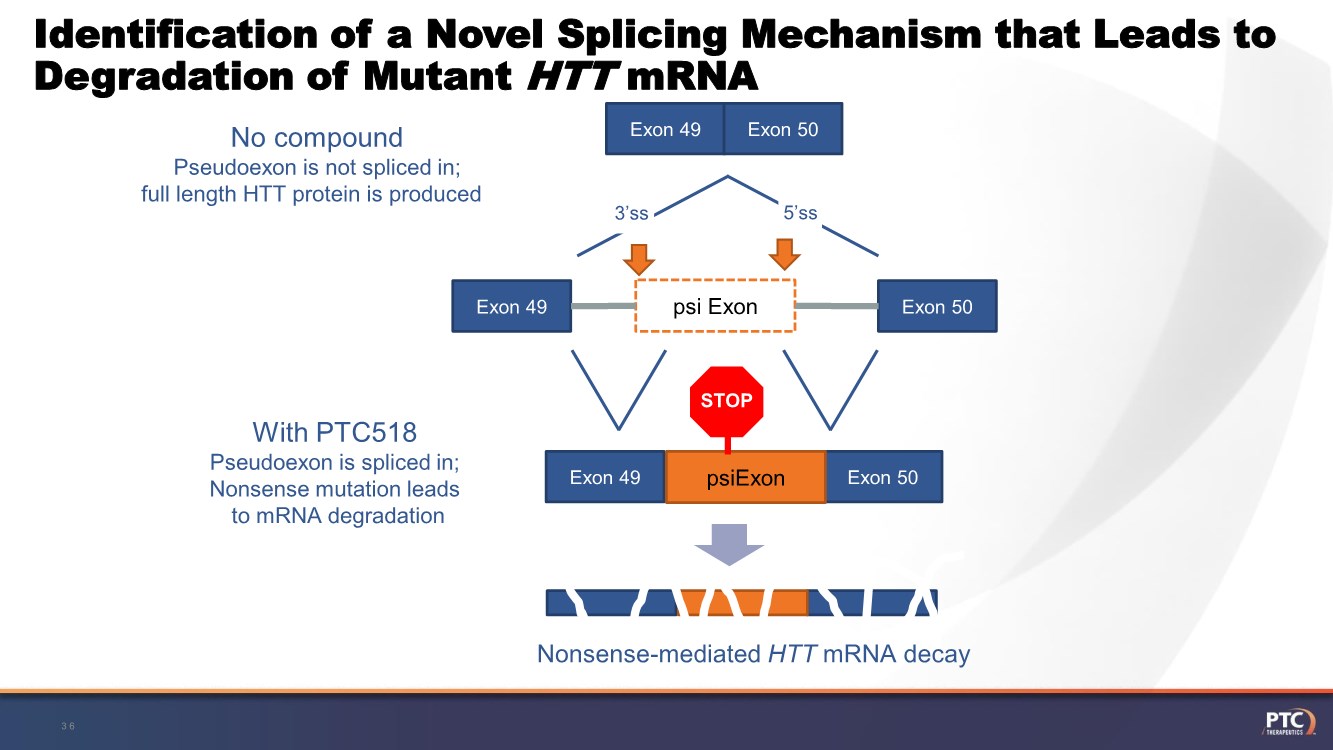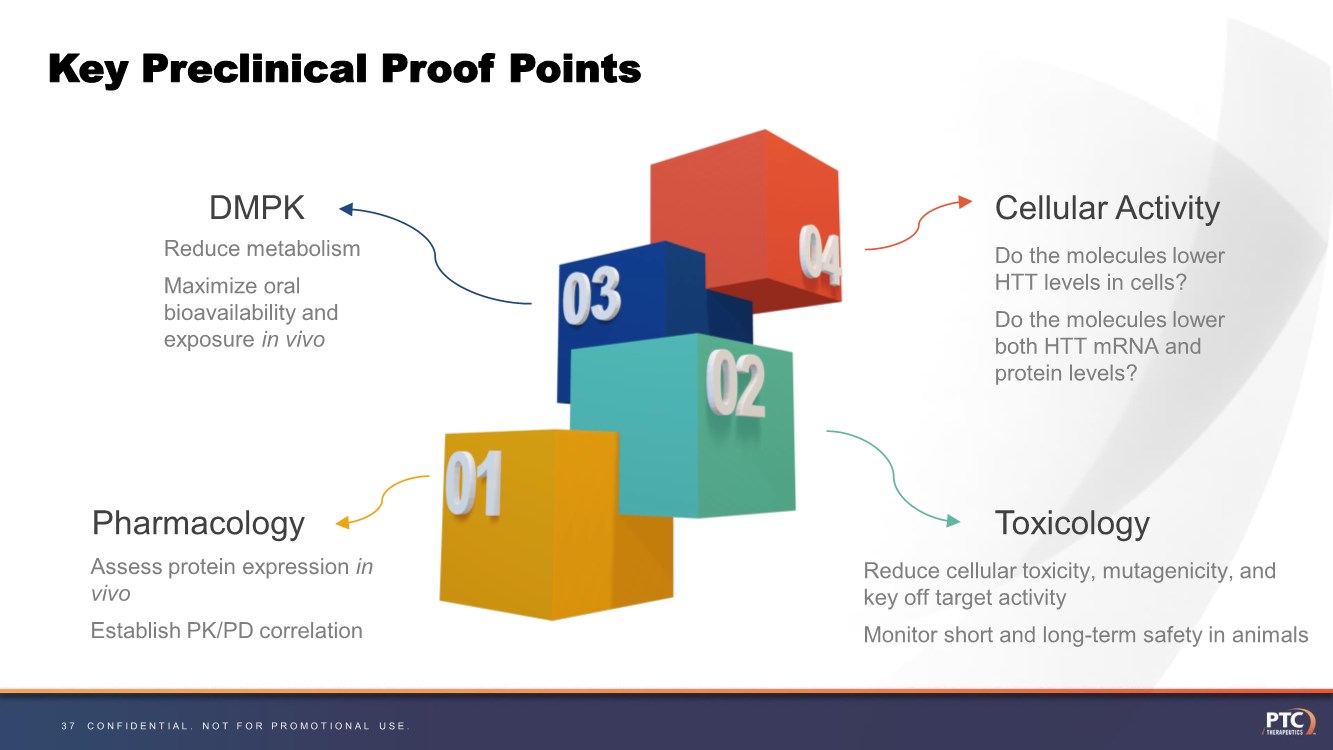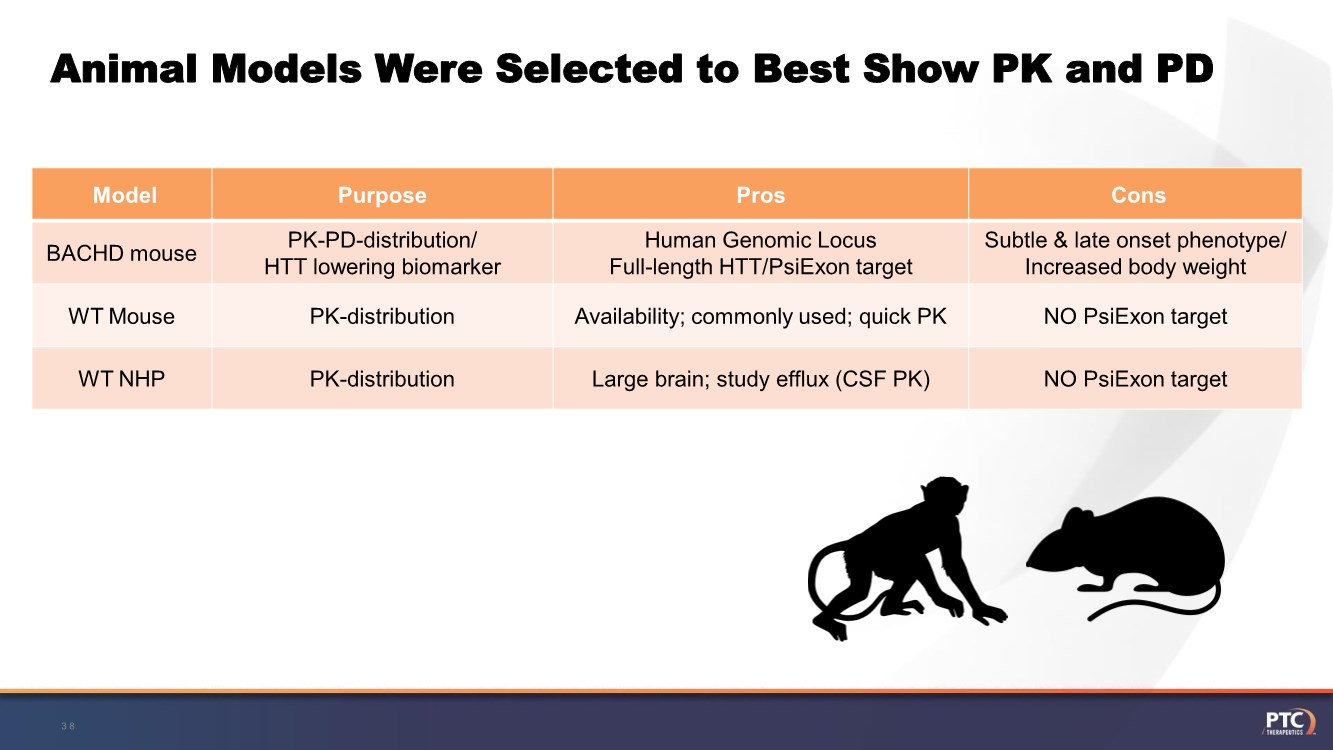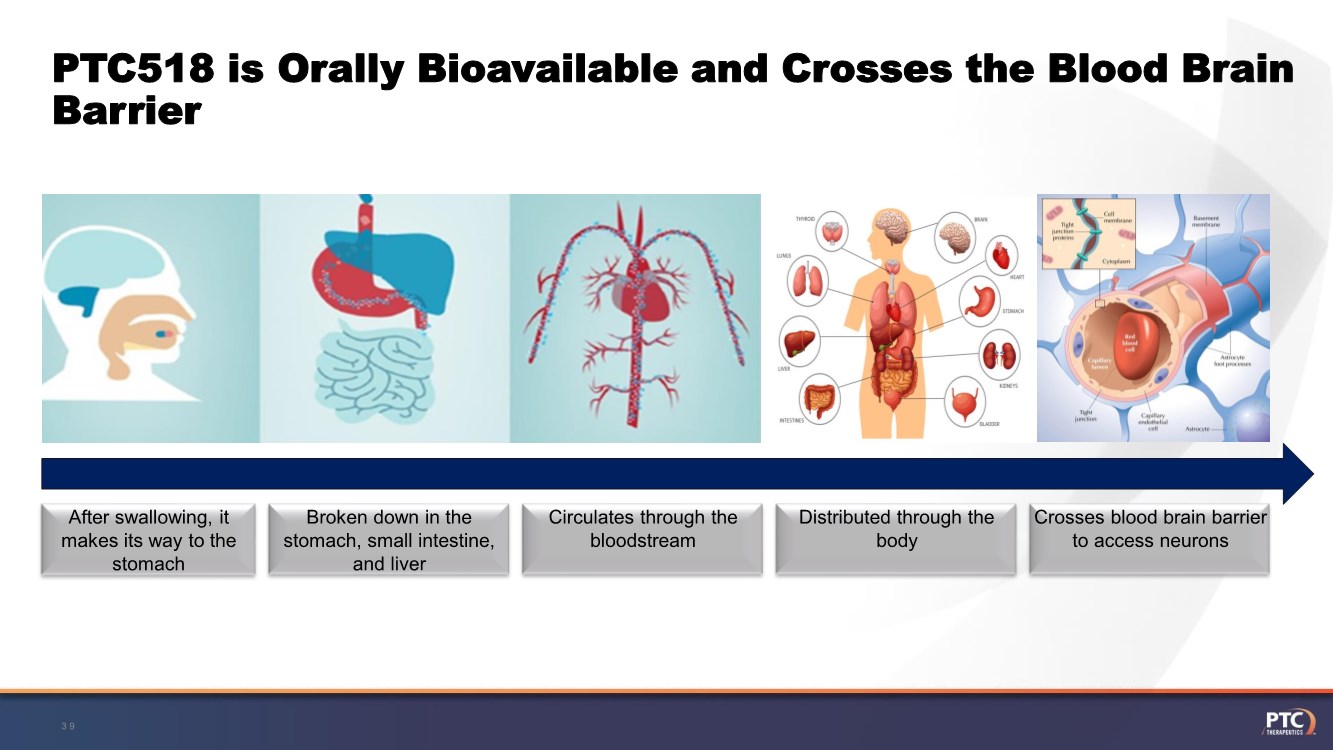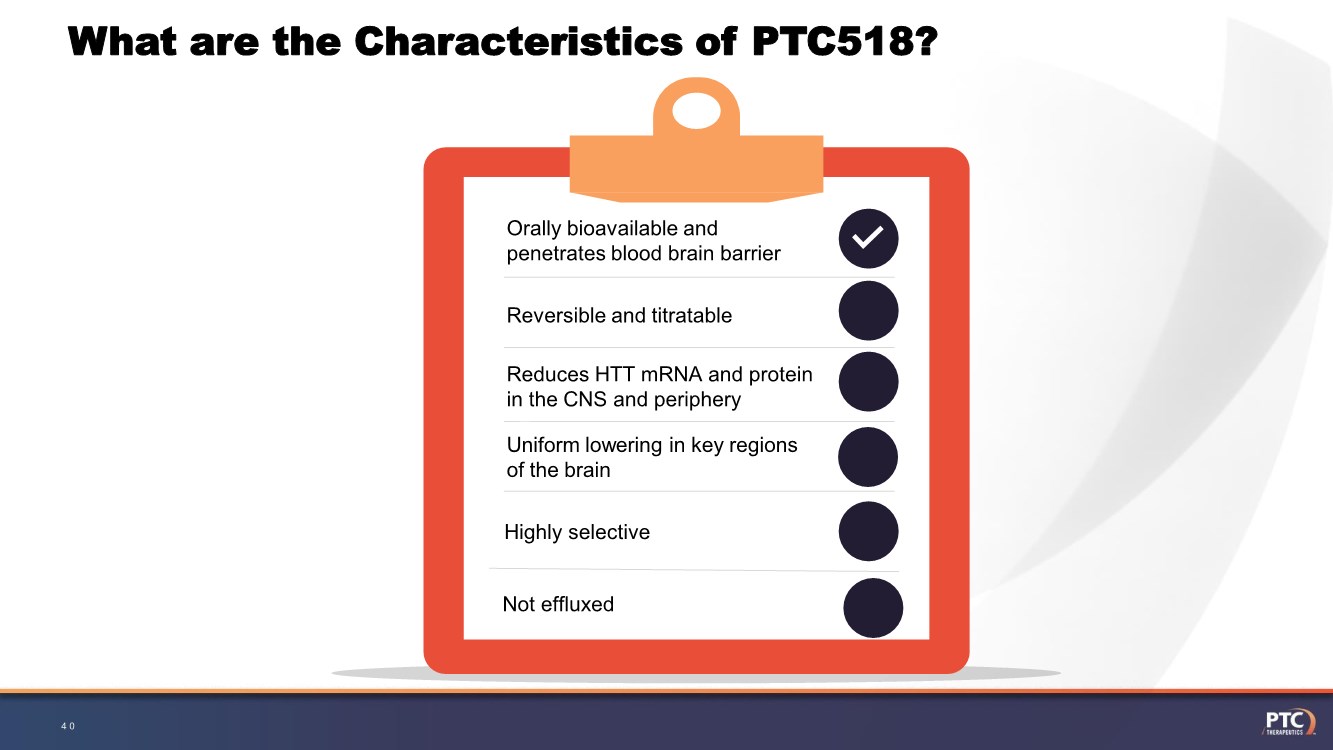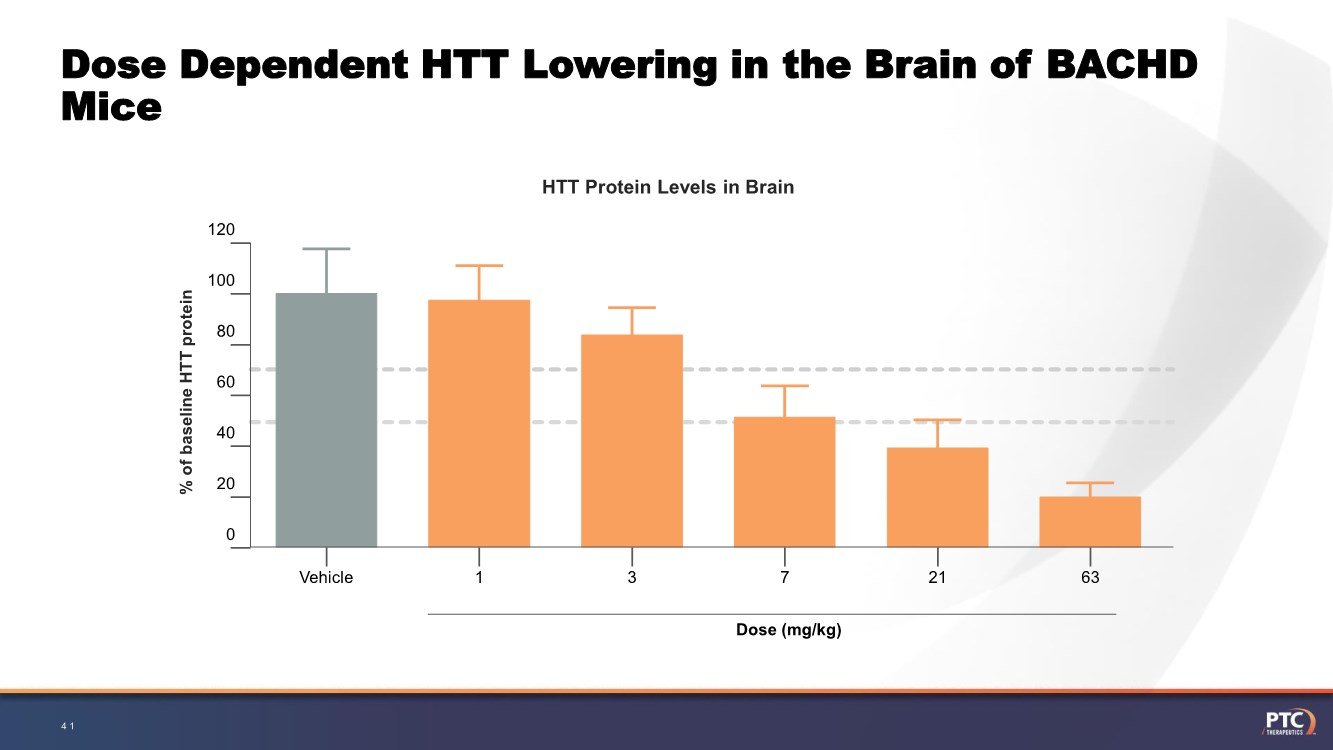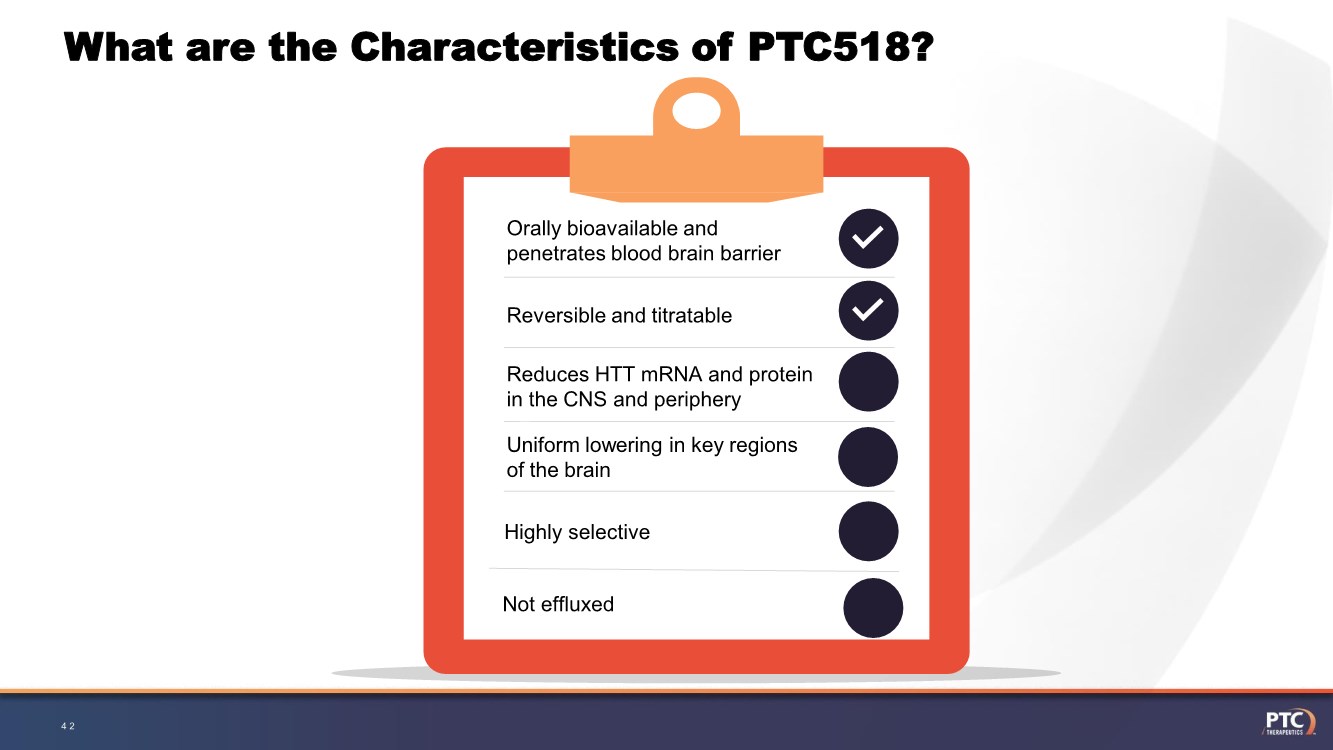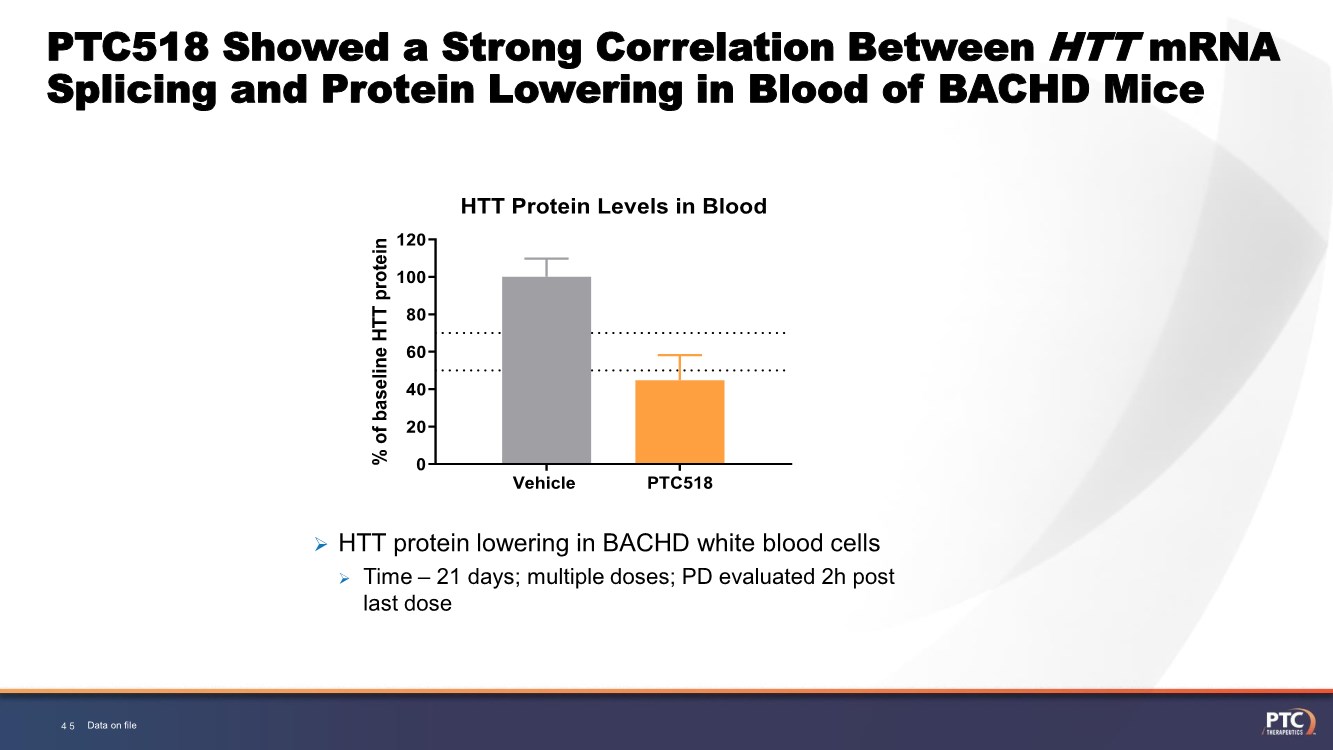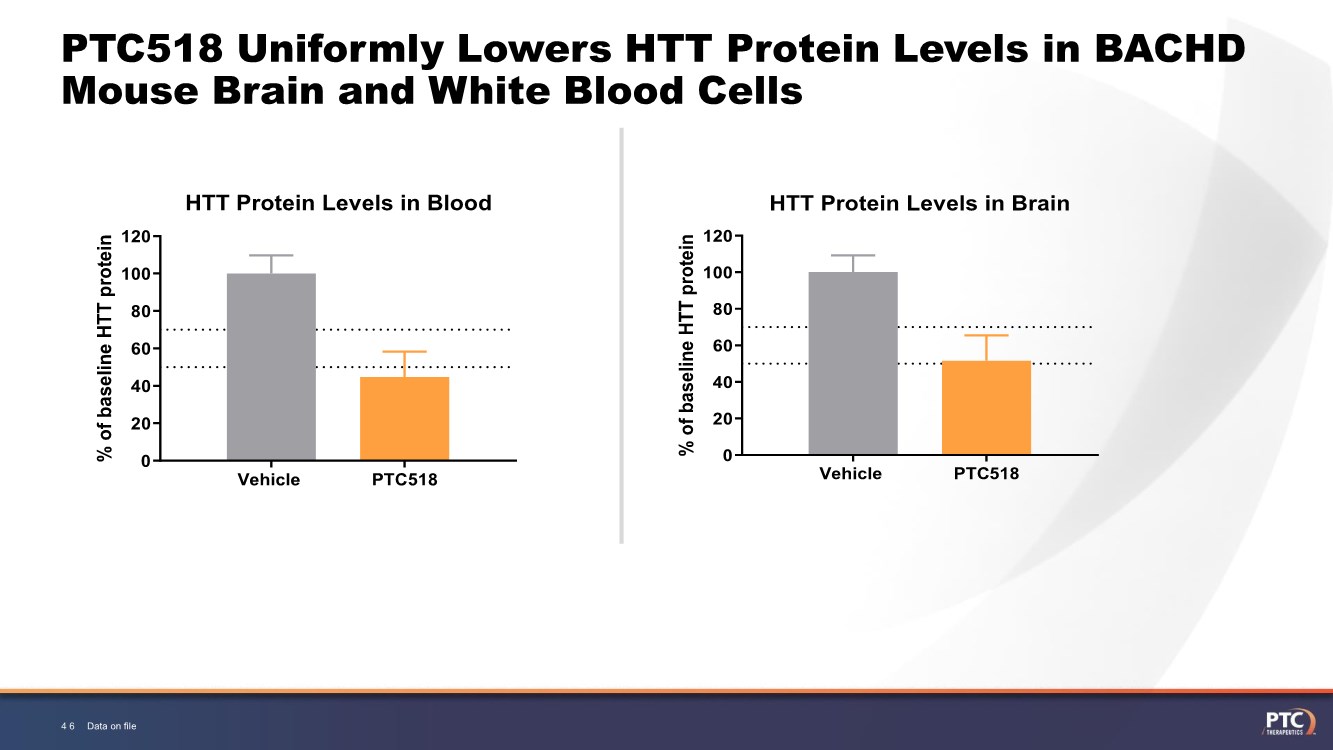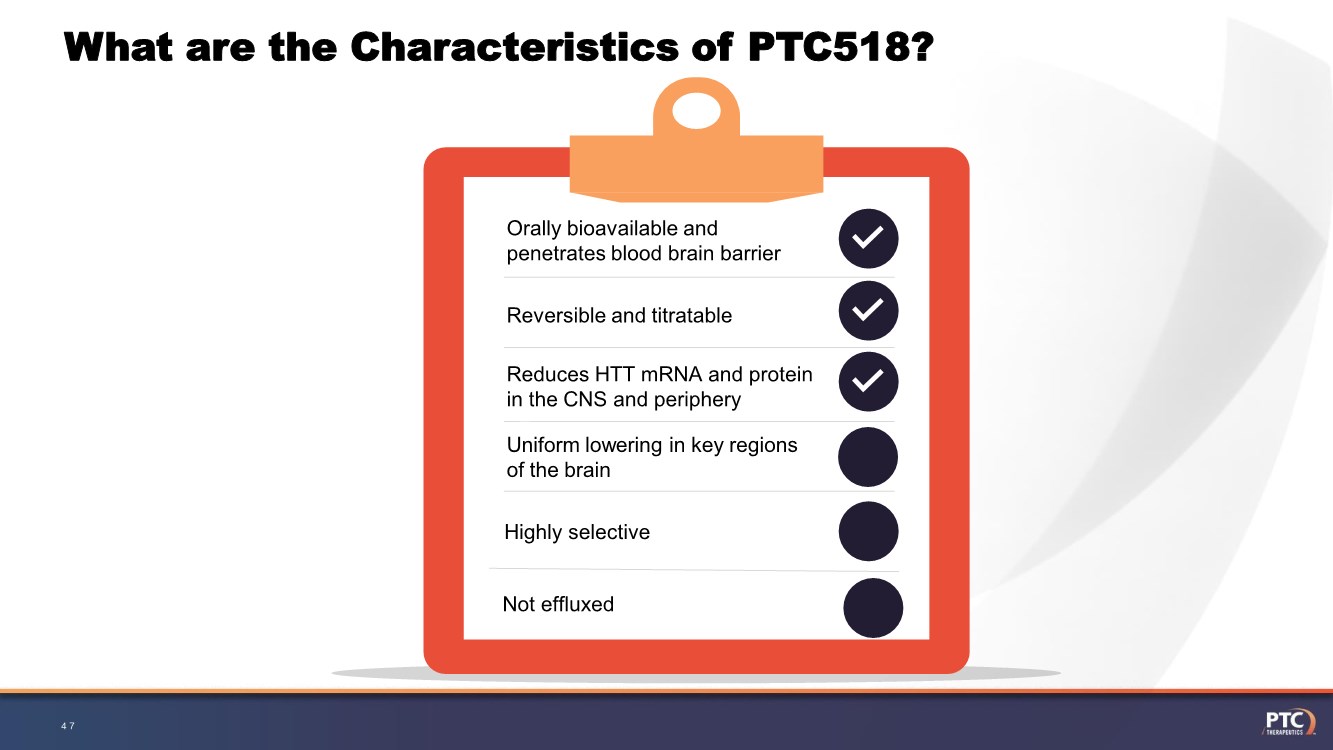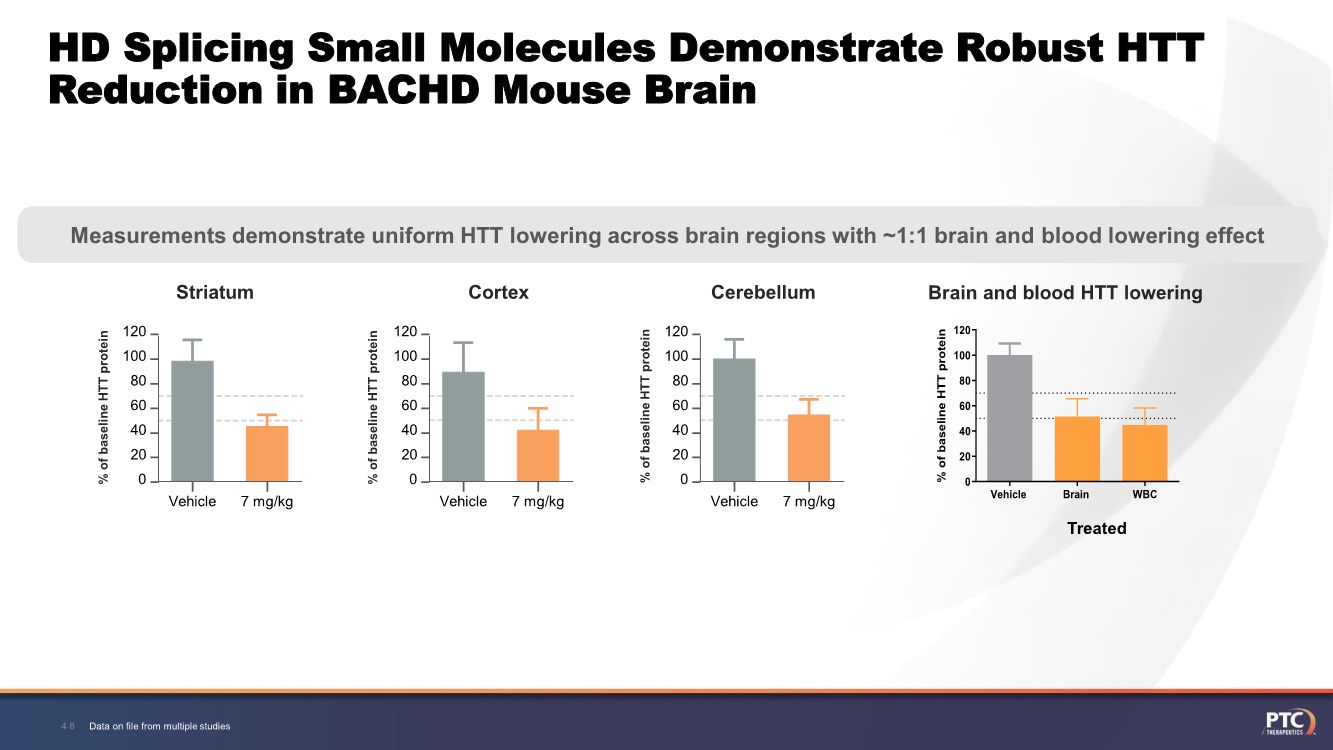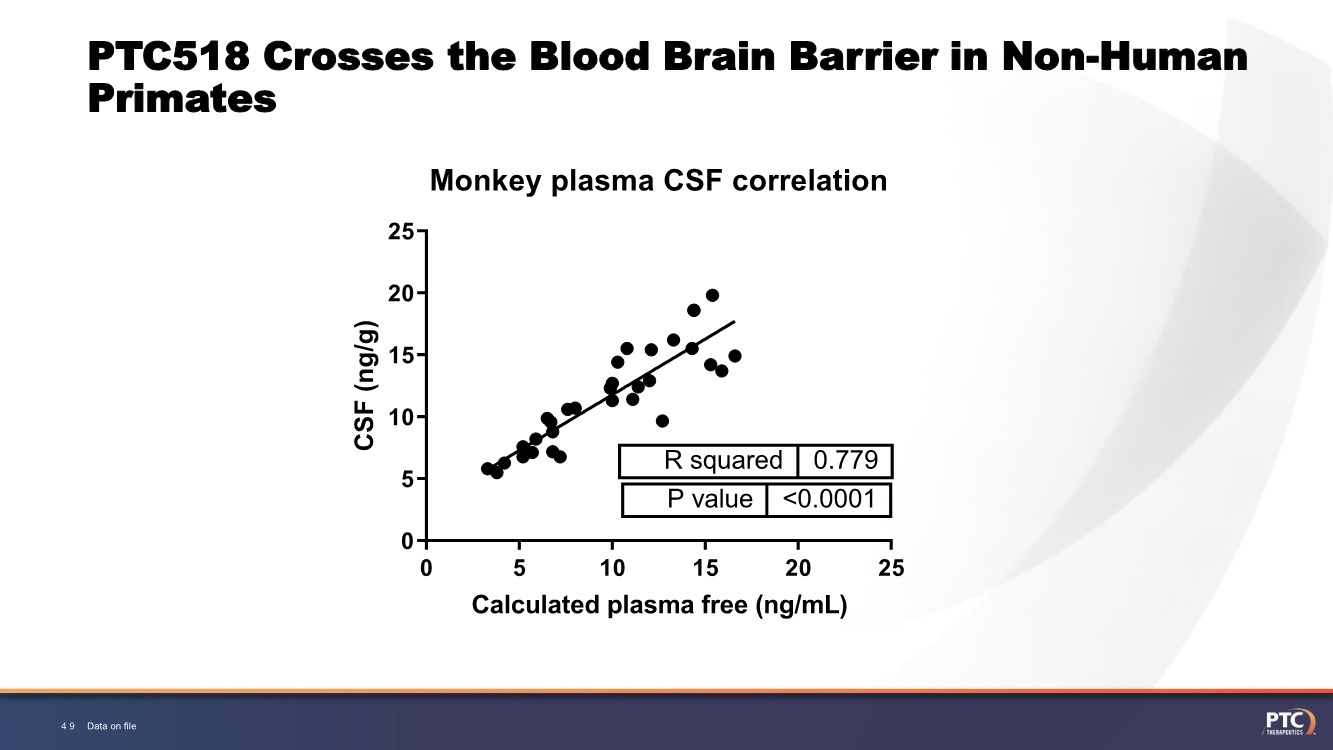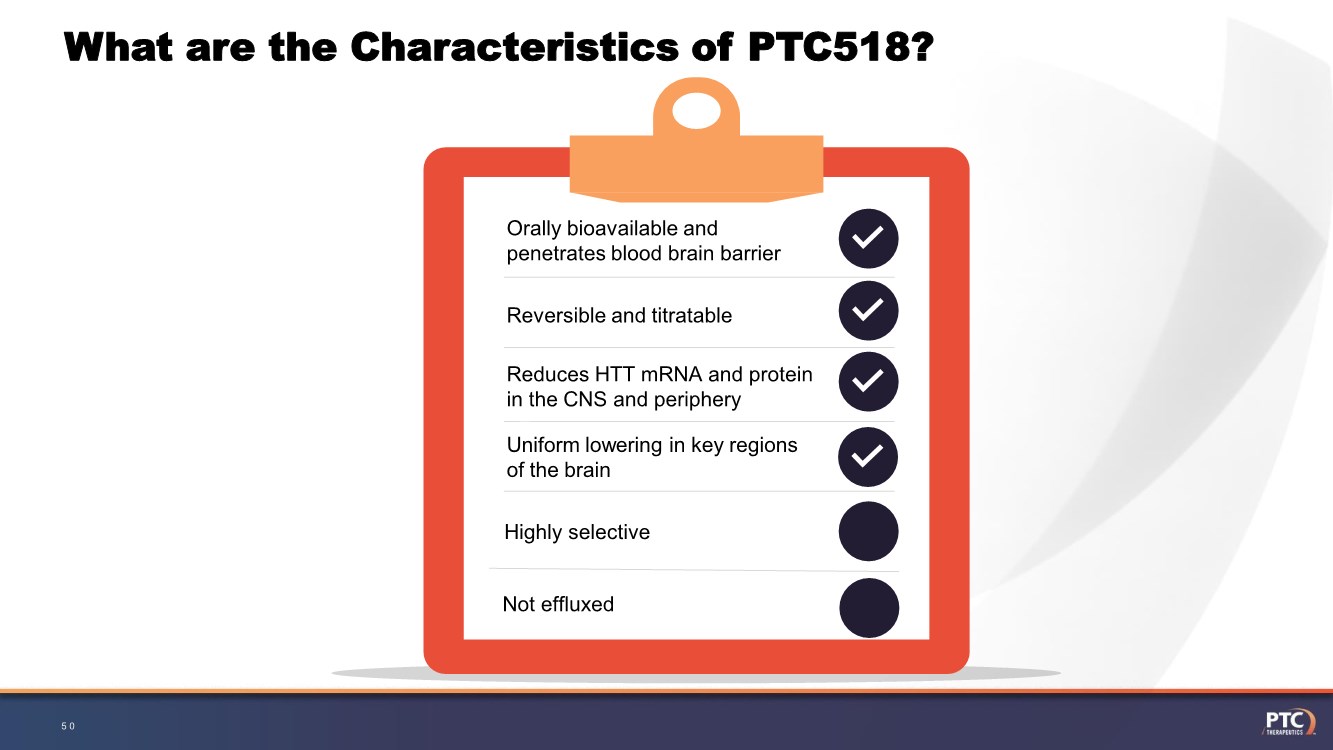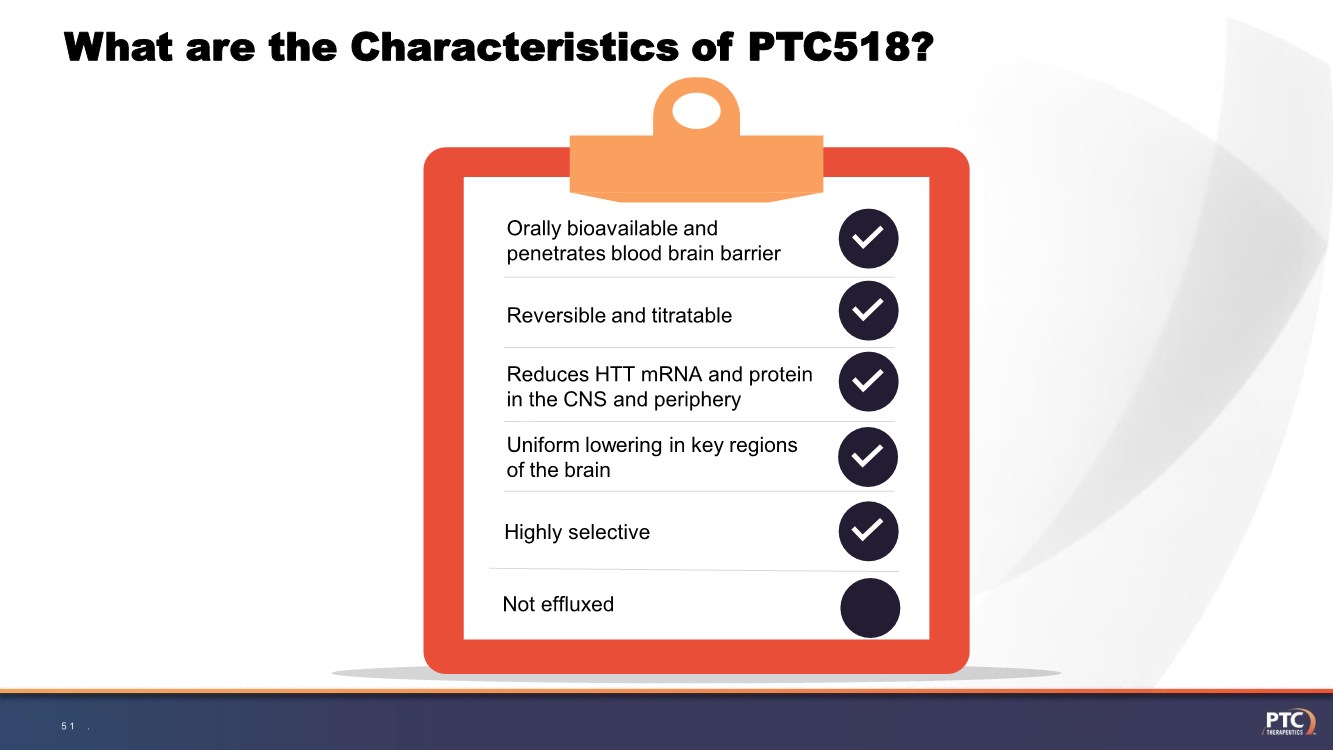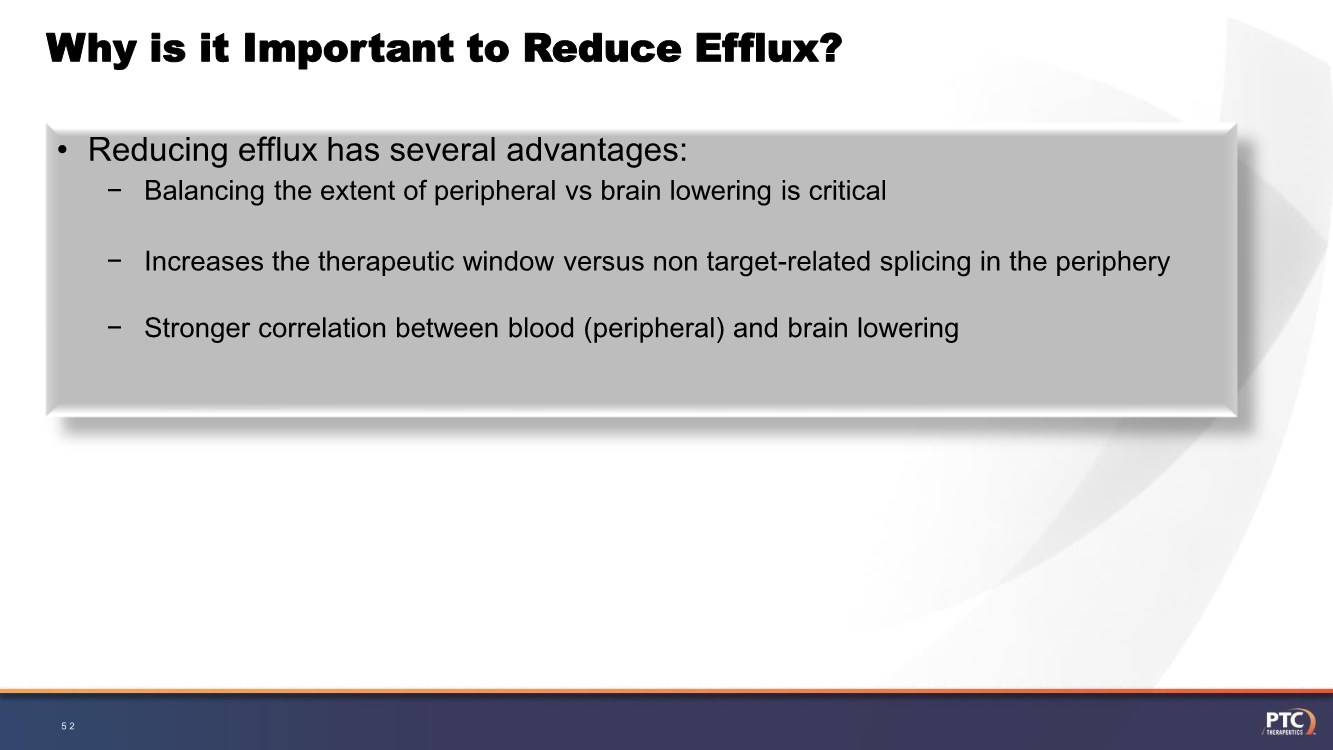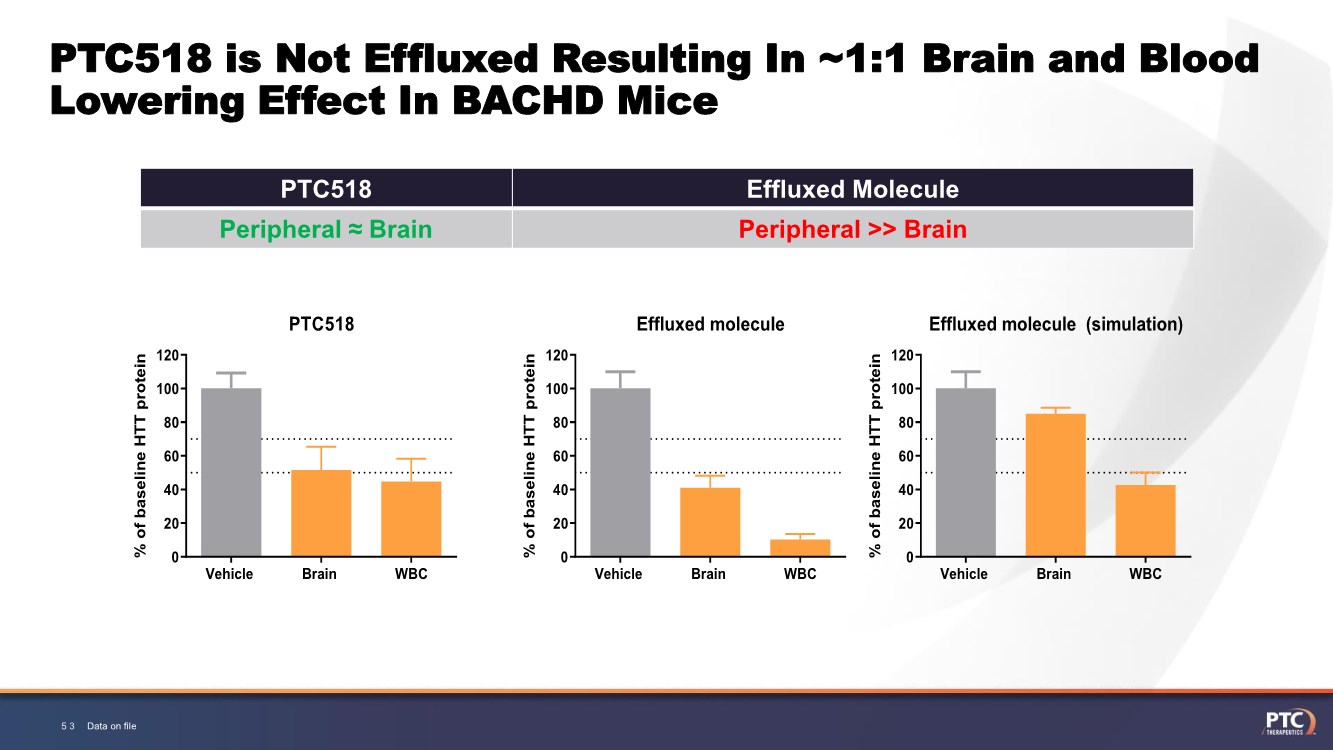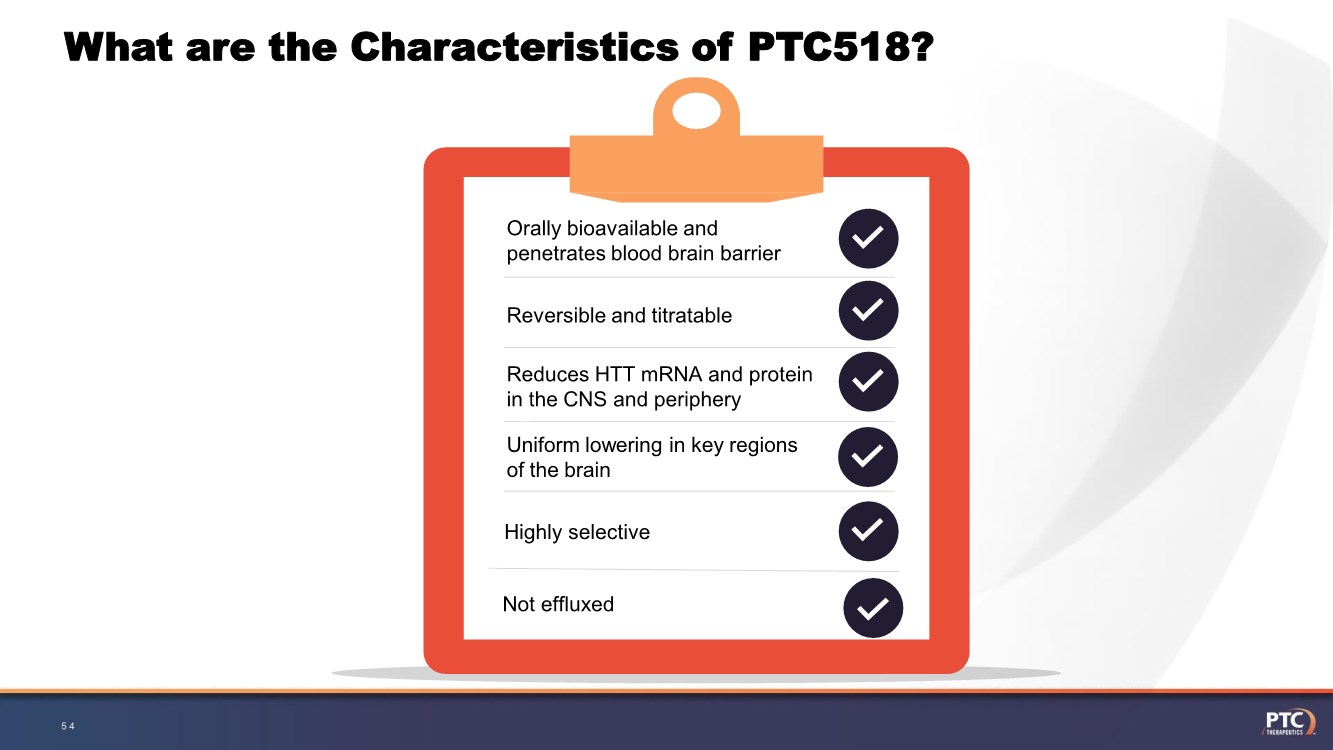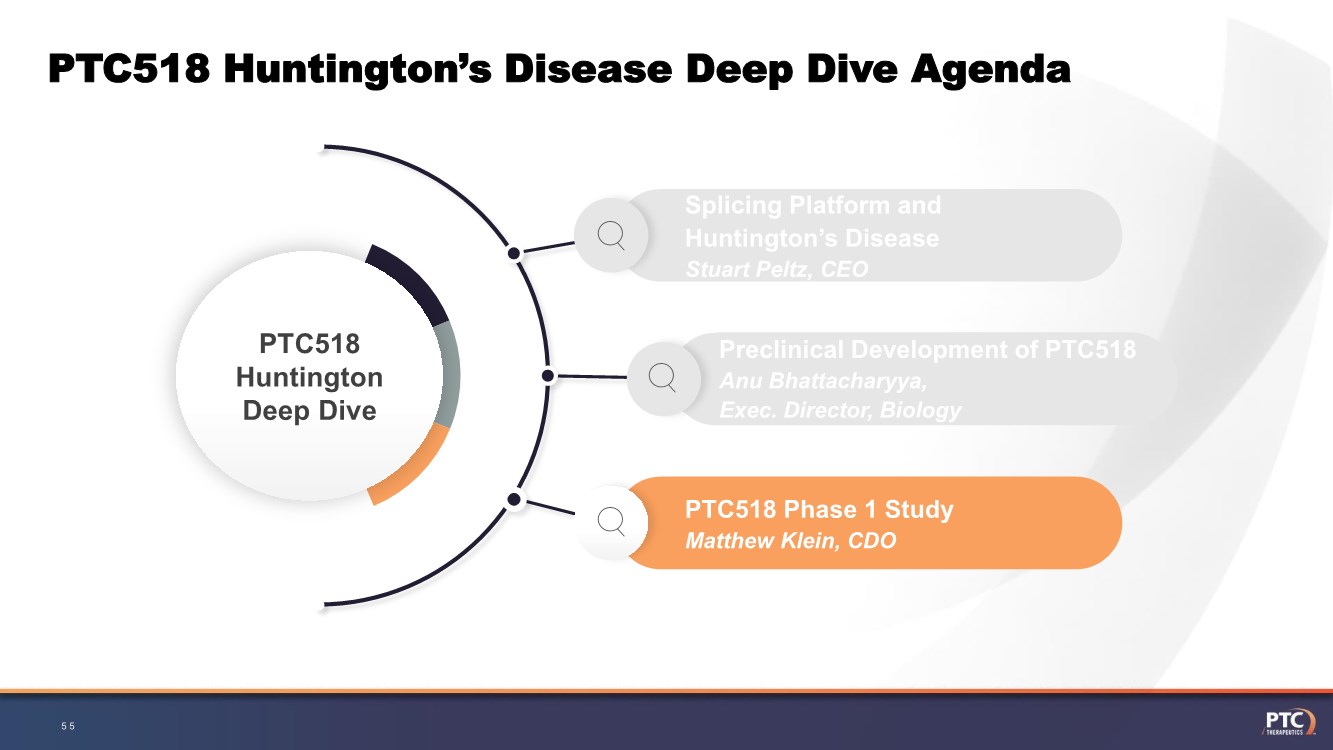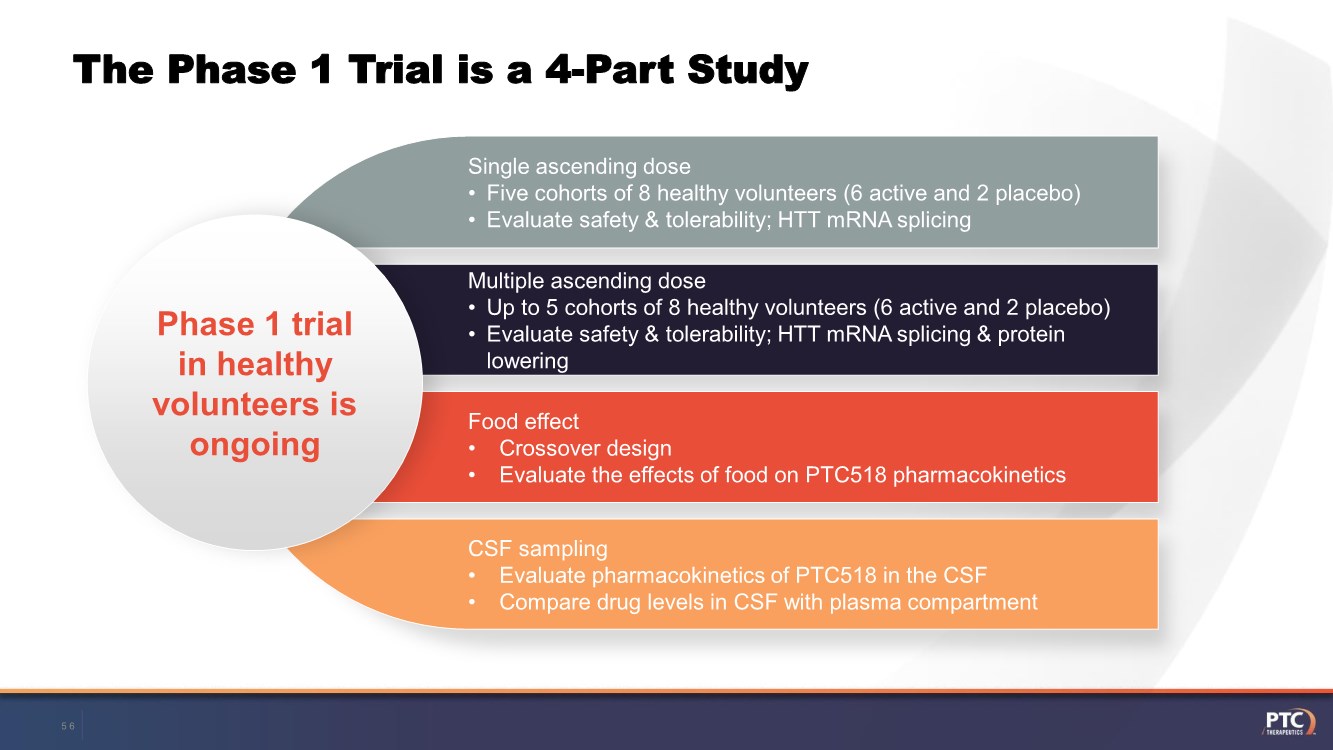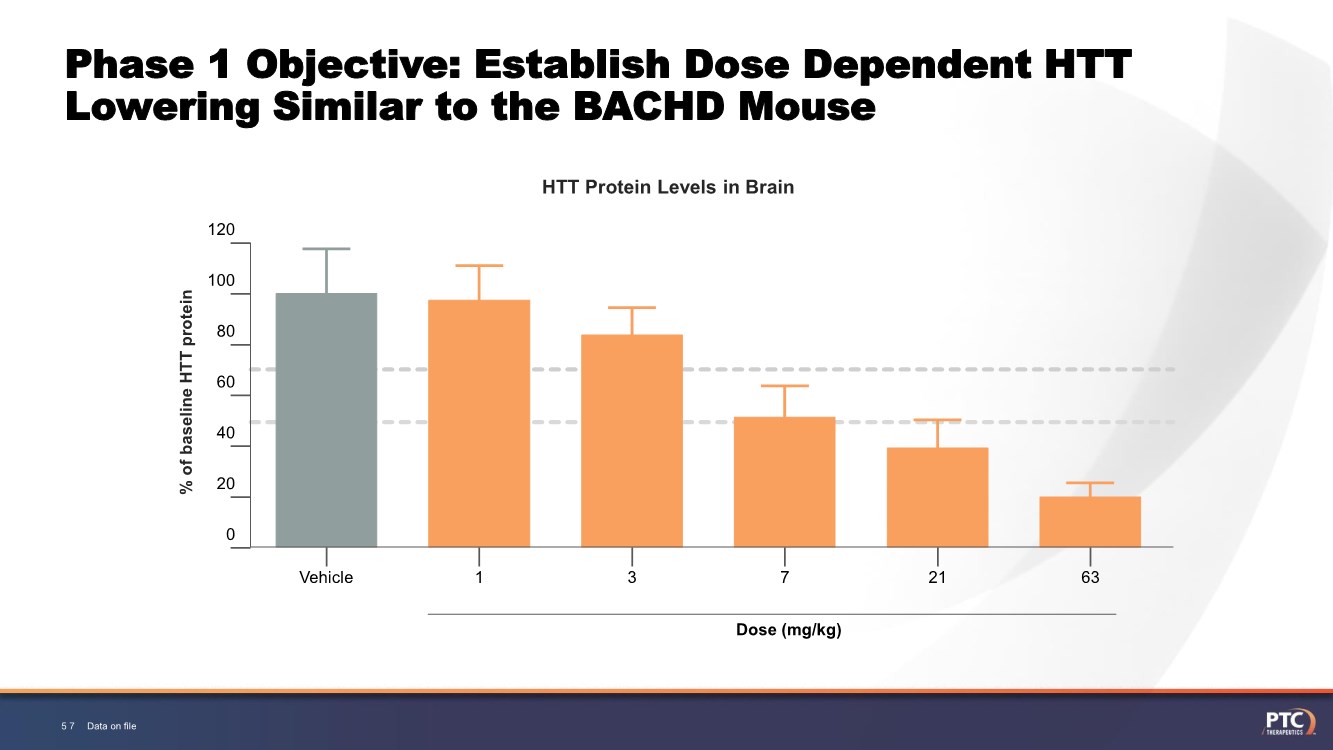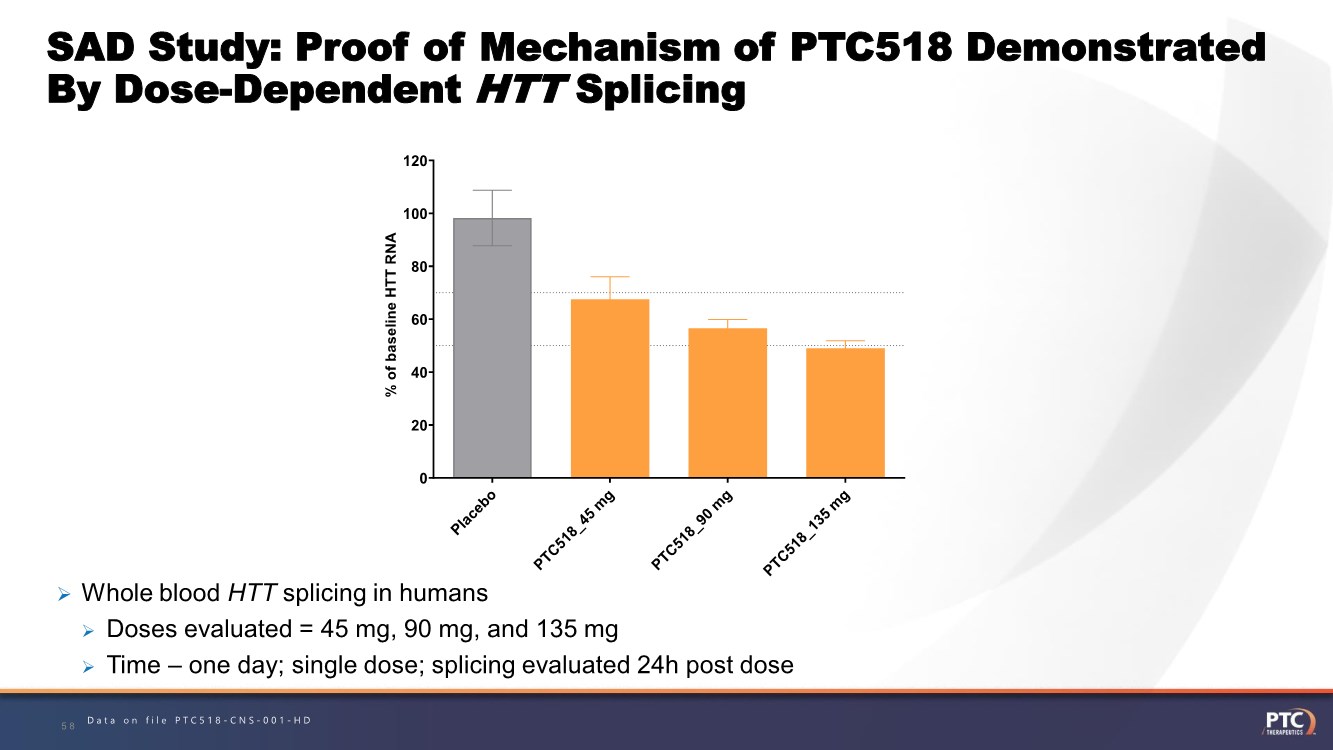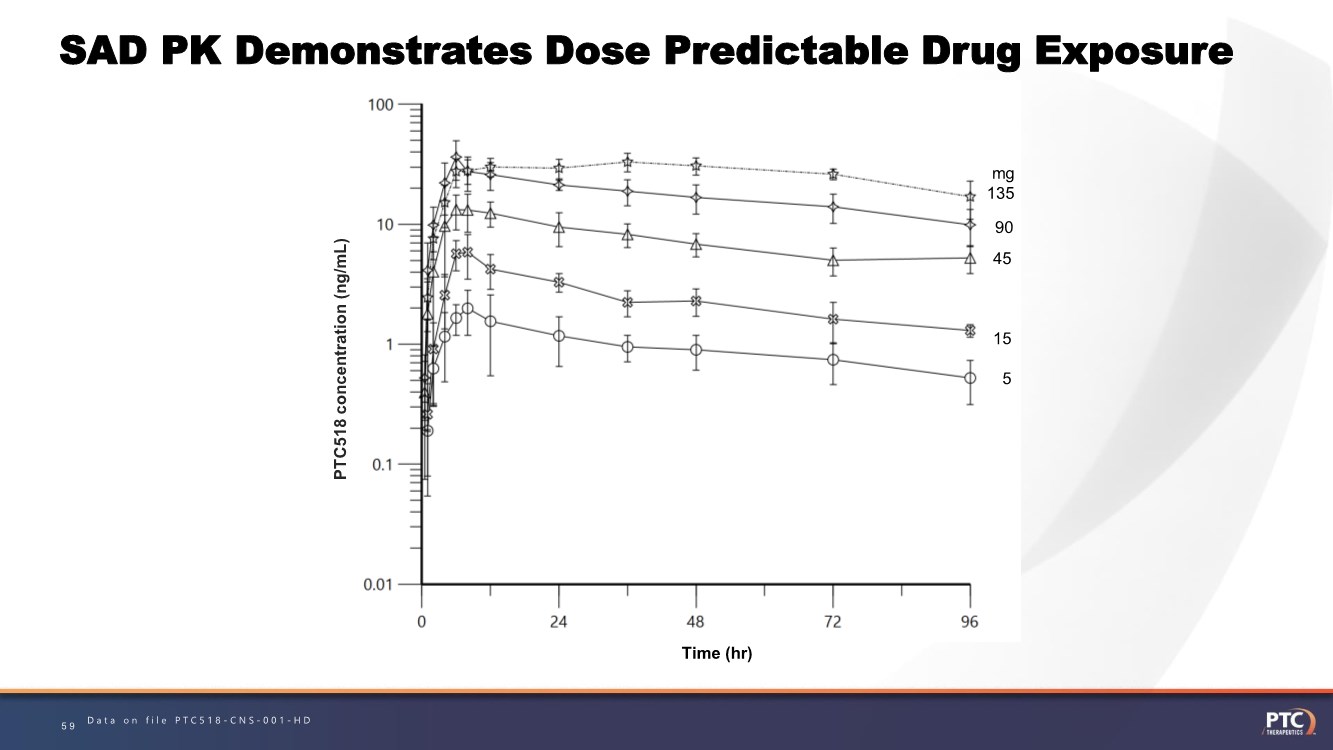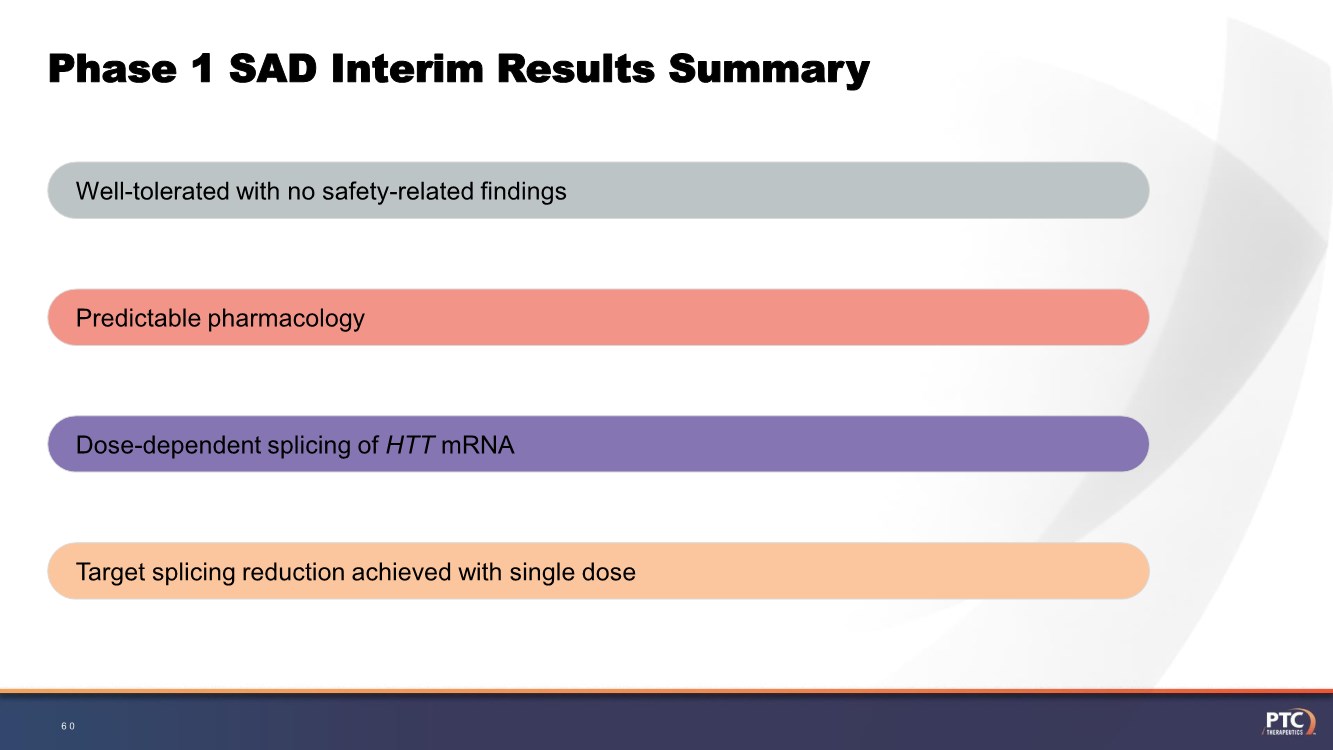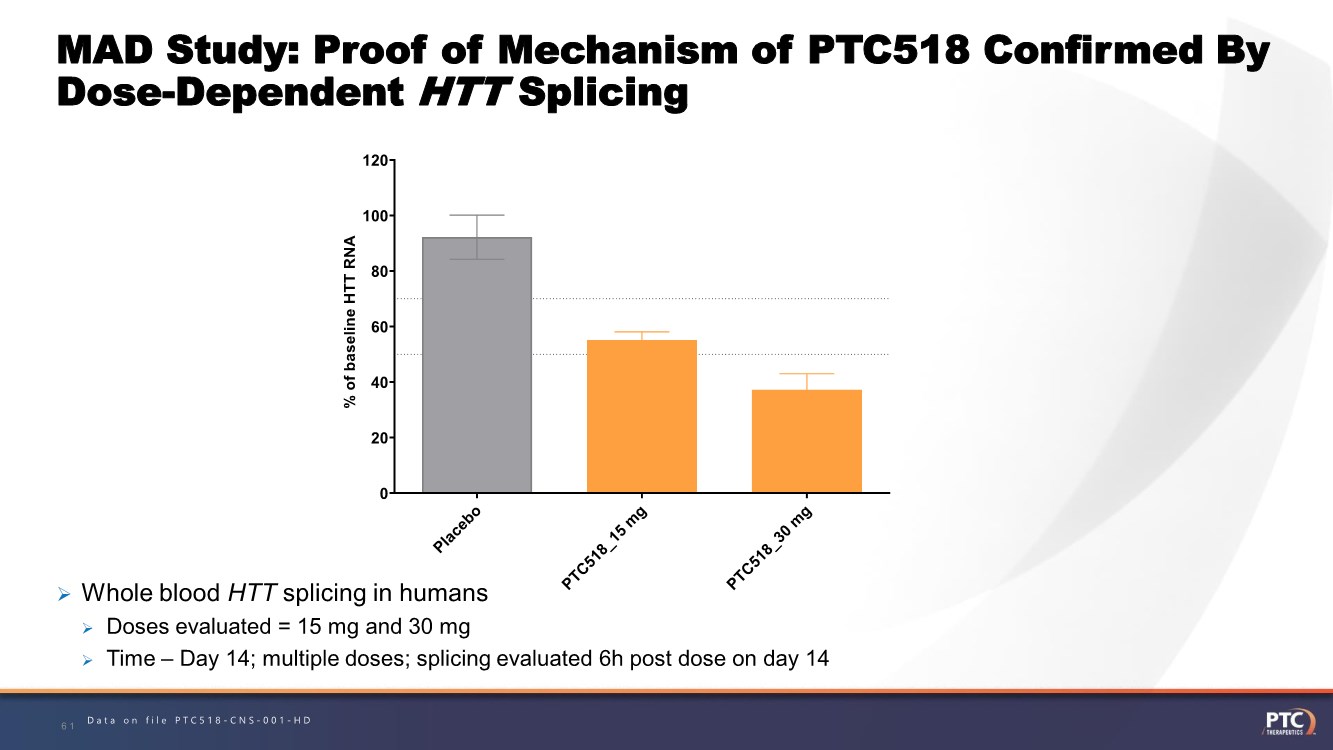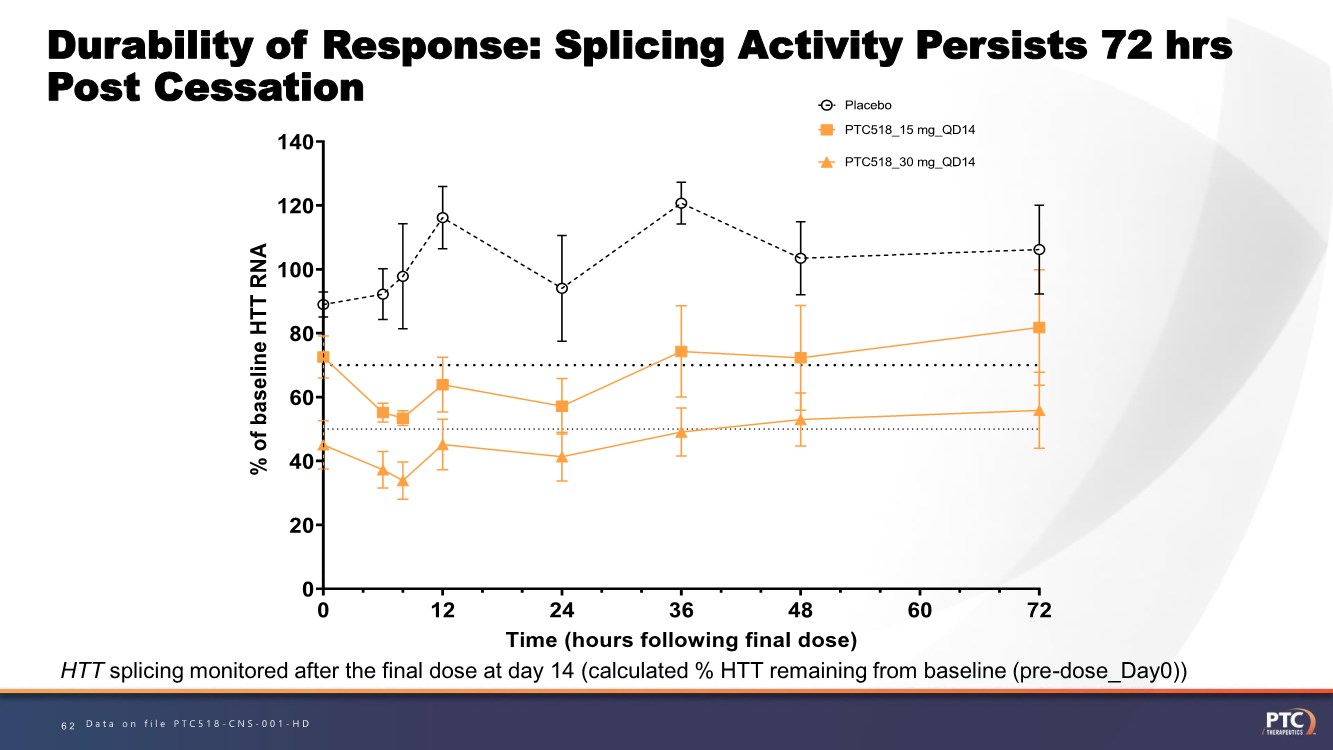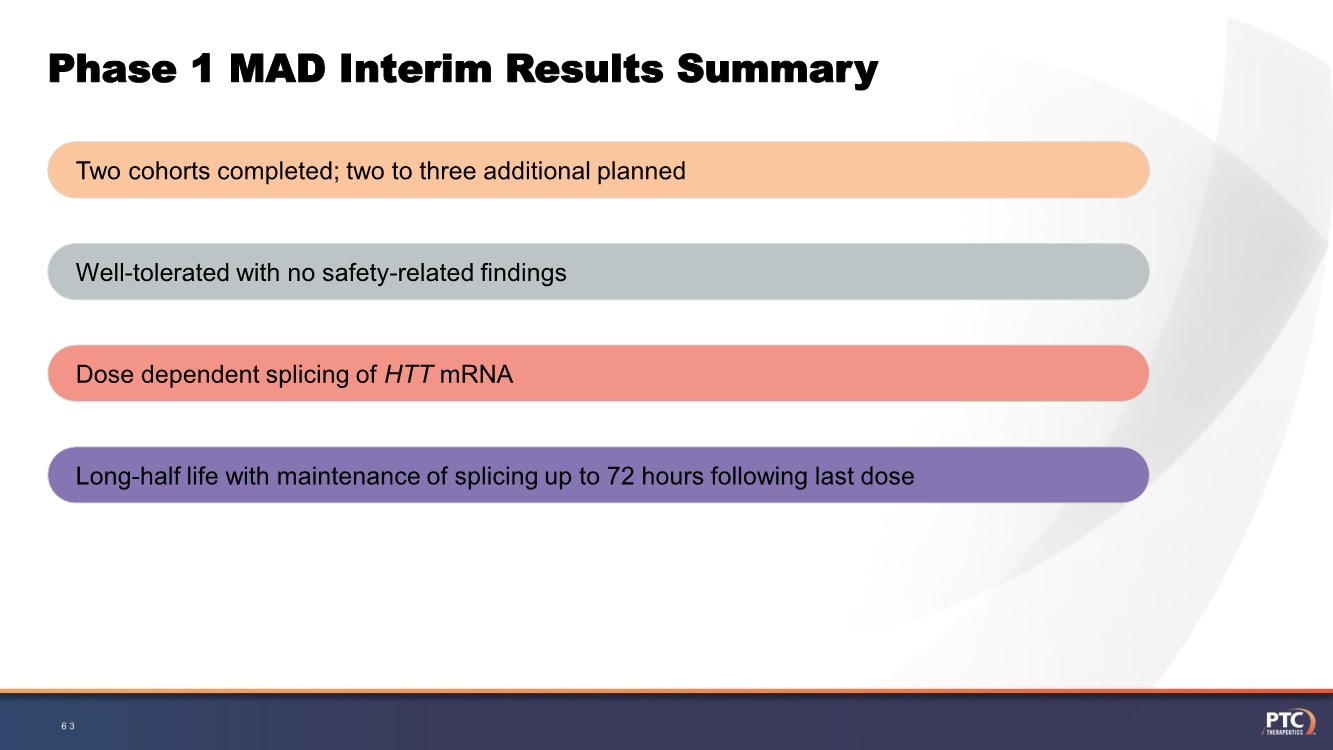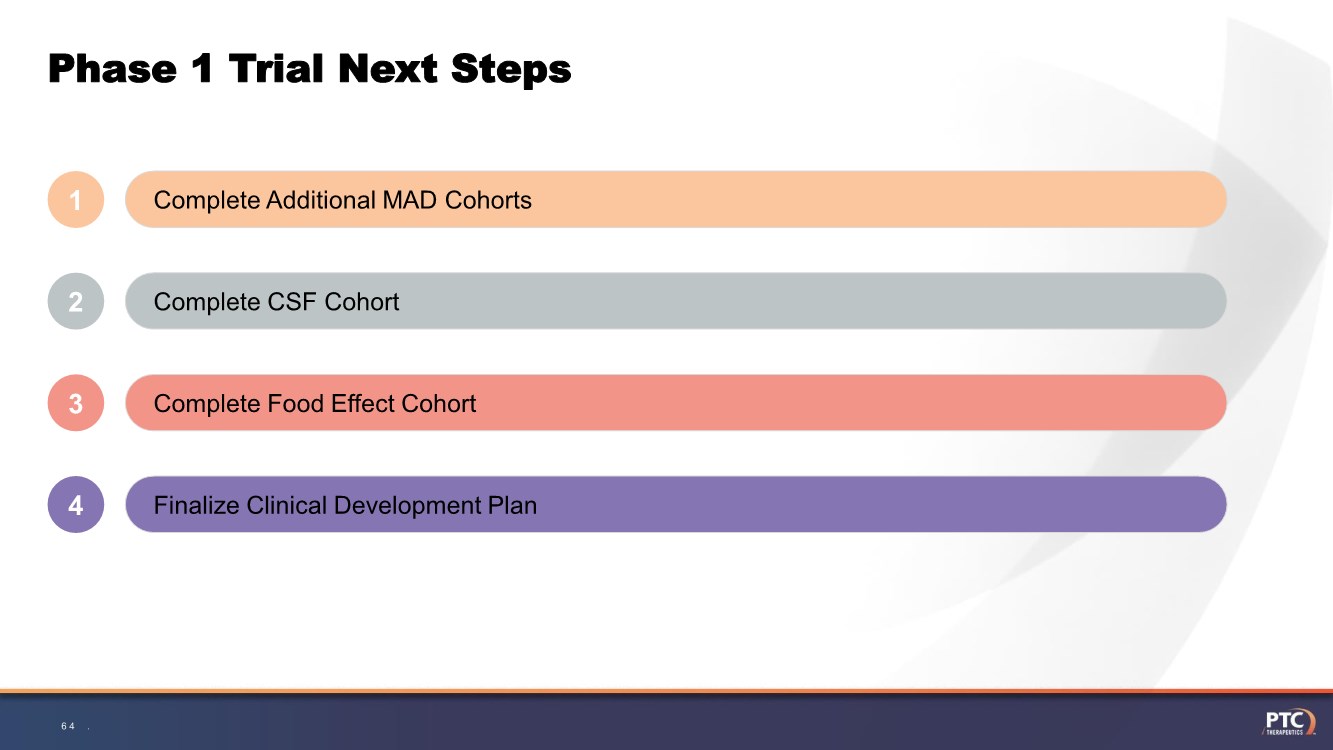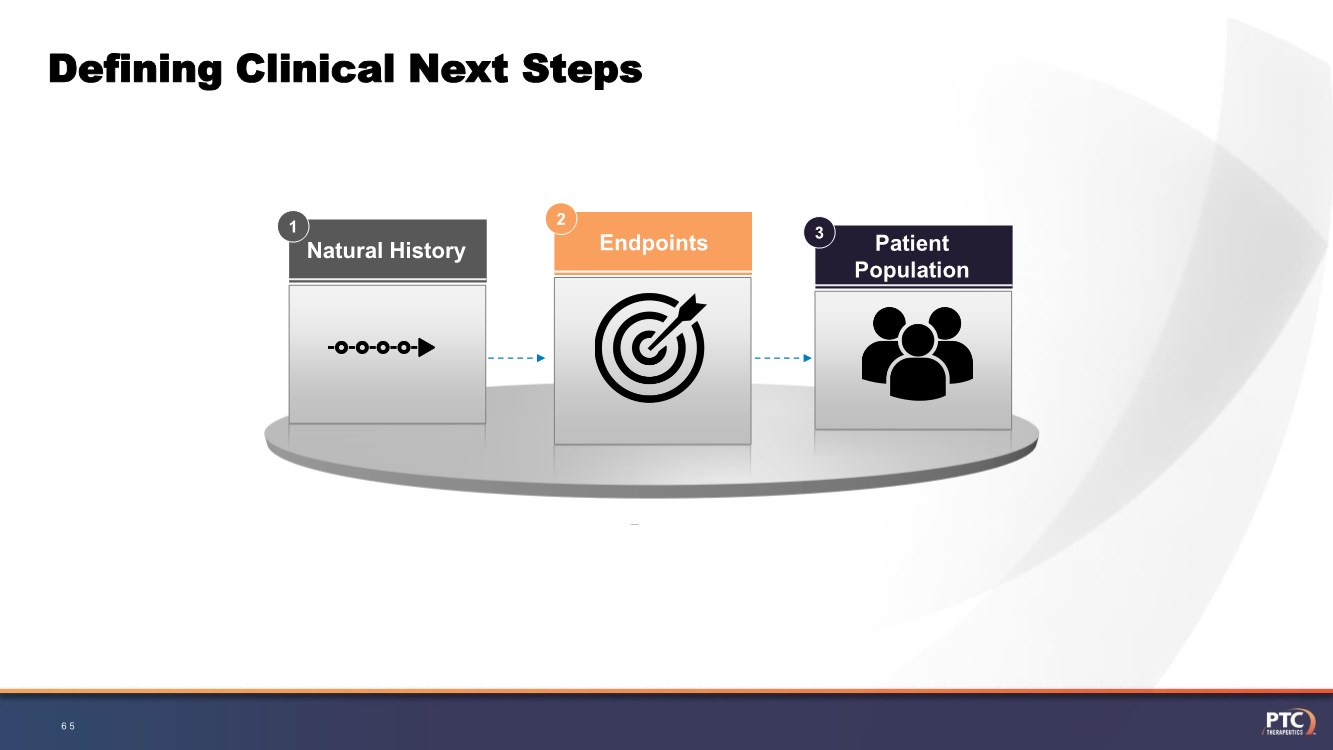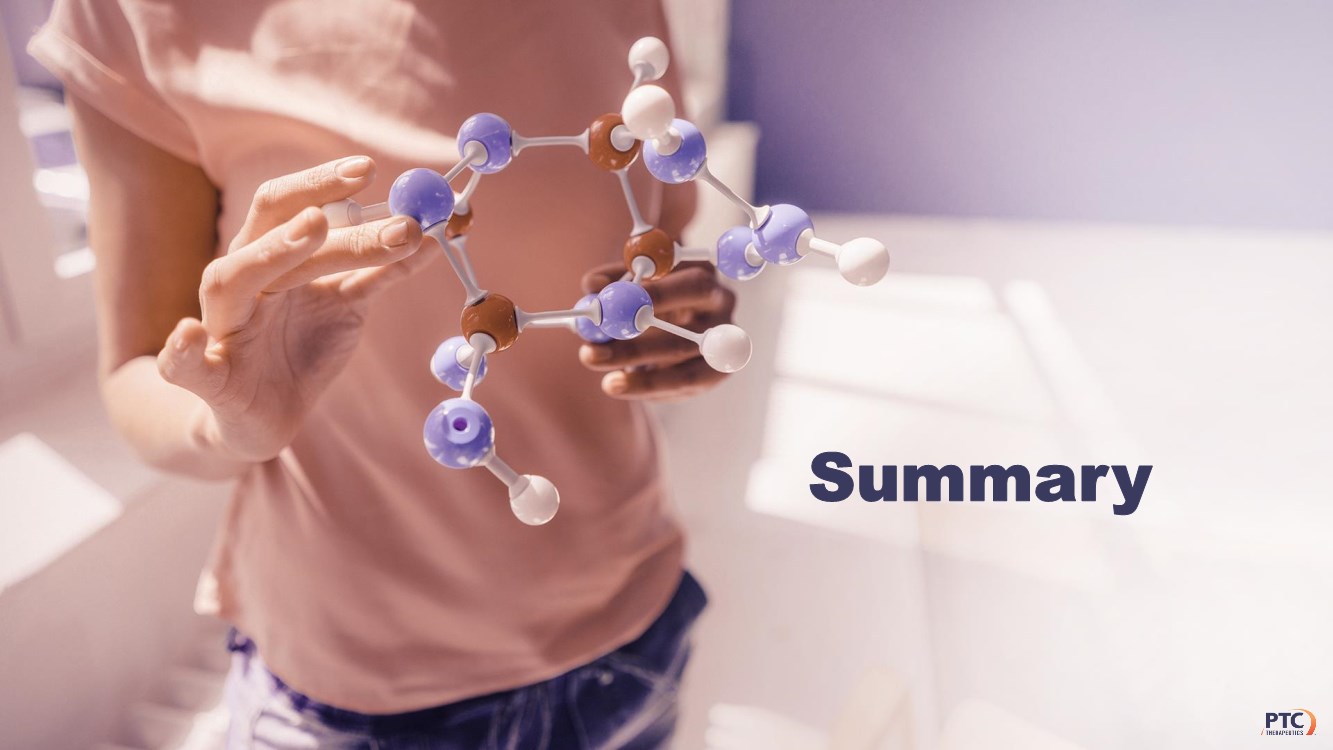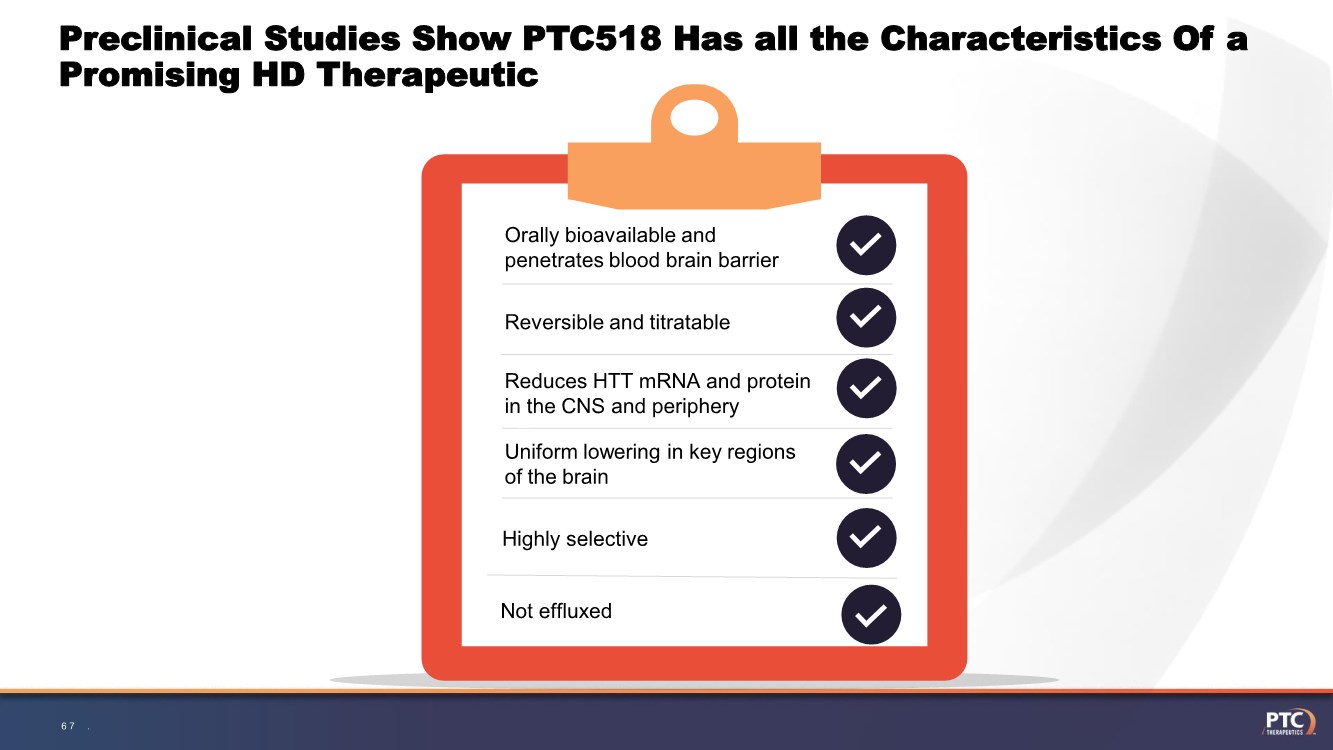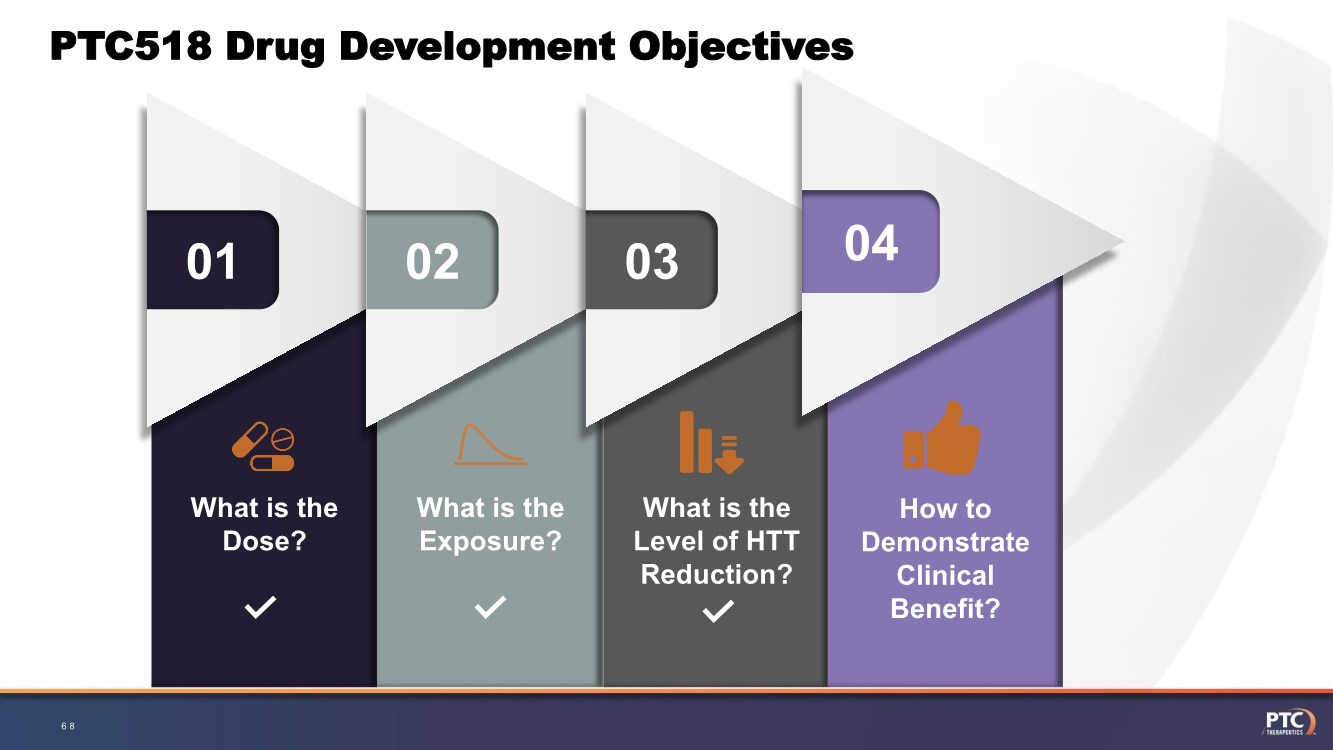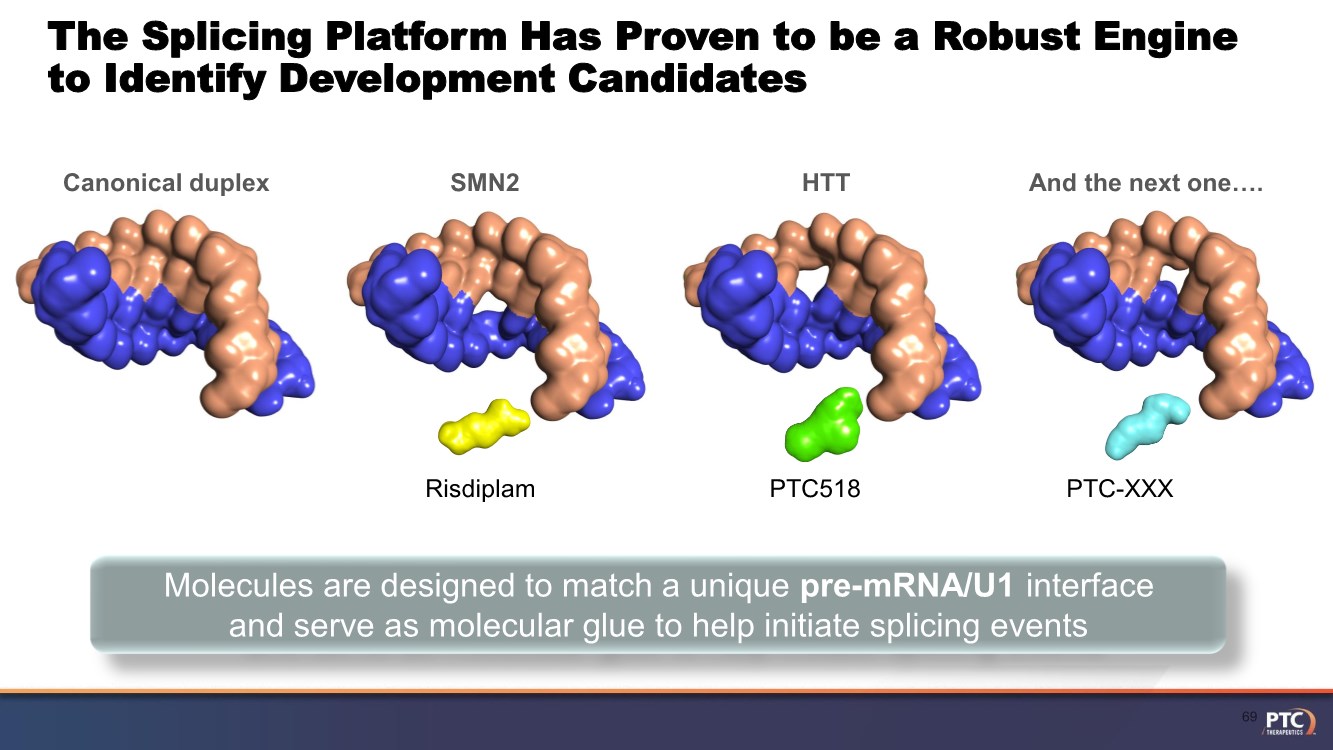Form 8-K PTC THERAPEUTICS, INC. For: Apr 15
Exhibit 99.1
| PTC518 Huntington’s Disease Deep Dive April 15th, 2021 |
| Forward Looking Statements: This presentation contains forward-looking statements within the meaning of The Private Securities Litigation Reform Act of 1995. All statements contained in this release, other than statements of historic fact, are forward -looking statements, including statements with respect to the future expectations, plans and prospects for PTC, PTC's strategy, including with respect to th e expected timing of clinical trials and studies, availability of data, regulatory submissions and responses and other matters, future operations, future financial position, future revenues, projected costs; and the objectives of management. Other forwa rd- looking statements may be identified by the words "guidance", "plan," "anticipate," "believe," "estimate," "expect," "intend, " "may," "target," "potential," "will," "would," "could," "should," "continue," and similar expressions. PTC's actual results, performance or achievements could differ materially from those expressed or implied by forward -looking statements it makes as a result of a variety of risks and uncertainties, including those related to: the outcome of pricing, coverage and reimbursement negotiations with third party payors for PTC's products or product candidates that PTC commercializes or may commercialize in the future; the enrollment, conduct, and results of ongoing studies under the SMA collaboration and events during, or as a result of, the studies that could delay or prevent further development under the program, including any regulatory submissions and commercialization with respect to Evrysdi; significant business effects, including the effects of industry, market, economic, political or regulatory conditions; changes in tax and other laws, regulations, rates and policies; the eligible patient base and commercial potential of PTC's products and product candidates; PTC's scientific approach and general development progress; and the factors discussed in the "Risk Factors" section of PTC's most recent Annual Report on Form 10-K, as well as any updates to these risk factors filed from time to time in PTC's other filings with the SEC. You are urged to carefully consider all such factors. As with any pharmaceutical under development, there are significant risks in the development, regulatory approval and commercialization of new products. There are no guarantees that any product will receive or maintain regulatory approval in any territory, or prove to be commercially successful. The forward-looking statements contained herein represent PTC's views only as of the date of this presentation and PTC does not undertake or plan to update or revise any such forward-looking statements to reflect actual results or changes in plans, prospects, assumptions, estimates or projections, or other circumstances occurring after the date of this presentation except as required by law. 2 |
| Diversified Platform Drives Strong Portfolio 3 Clinical Commercial Research Nonsense Mutation LatAm Commercial Deflazacort Gene Therapy Bio-e Metabolic Oncology US Dystrophin PTC-AADC PTC299 AML PTC596 DIPG PTC596 LMS Vatiquinone ME Vatiquinone FA PTC923 PKU PTC299 COVID-19 SCA-3 Undisclosed MAP-Tau PTC857 GBA-PD PTC518 HD Splicing Virology • AADC, aromatic L-amino acid decarboxylase deficiency; AML; acute myeloid leukemia; COVID-19, coronavirus disease 2019; DIPG, diffuse intrinsic pontine glioma; FA, Friedreich’s ataxia; GBA, glucocerebrosidase; HD, Huntington‘s disease; IRD, inherited retinal dystrophy; LMS, leiomyosarcoma; ME, Mitochondrial Epilepsy; PD, Parkinson’s disease; PKU, phenylketonuria; SCA-3, spinocerebellar ataxia type 3. SCIENTIFIC PLATFORMS and RESEARCH Potential registrational studies Angelman IRDs Cog Disorders FA |
| PTC518 Huntington’s Disease Deep Dive Agenda 4 Preclinical Development of PTC518 Anu Bhattacharyya, Exec. Director, Biology PTC518 Huntington Deep Dive Splicing Platform and Huntington’s Disease Stuart Peltz, CEO PTC518 Phase 1 Study Matthew Klein, CDO |
| PTC is the Leader in Splicing With 20 Years of Expertise and Proven Track Record 5 Spinal muscular atrophy Huntington’s disease Exploiting splicing Proprietary systems and specialty libraries Isoform plex HTSpliceseq Many additional targets Databases of Splicing Targets Familial dysautonomia |
| 6 Recognition of Pre-mRNA is Mediated by U-snRNP Complexes U1 and U2 5’ Splice Site 3’ Splice Site 5’ Splice Site 3’ Splice Site U1 recognizes the 5’ splice site at each exon U2 recognizes the branch site near the 3’ splice site |
| FL mRNA Functional SMN protein Targeting Alternative Splicing of SMN2 in SMA by Targeting the U1 Site SMN1 6 8 7 mRNA 6 8 7 6 8 7 SMN2 6 8 7 6 8 CT Truncated unstable SMN protein ESE ESS U1 GA U1 GA Risdiplam stabilizes U1 Functional SMN protein FL mRNA Δ7 mRNA Activation Inhibition 7 |
| The SMN2 5’-Splice Site Presents a Unique Structural Interface for Small Molecule Risdiplam Canonical Duplex SMN2 Exon 7 8 |
| Risdiplam SMN2 Improves the Ability of the 5’-Splice Site to Promote Splicing Risdiplam Canonical Duplex SMN2 Exon 7 9 |
| Risdiplam Increases SMN Protein in Multiple Tissues to Near or Above Heterozygous Levels Brain Peripheral Blood Mononuclear Cells • SMN protein levels in peripheral blood cells correlate to those in brain • Similar increases in SMN observed in spinal cord, muscle, heart, liver, skin 0 1 0 0 2 0 0 3 0 0 4 0 0 5 0 0 V ehicle H e te ro z y g o u s (n o d ise a se p h e n o ty p e ) * * * * * * * * * S M N p r o t e i n % i n c r e a s e S E M 2 6 10 D o s e (m g /k g ) 0 1 0 0 2 0 0 3 0 0 4 0 0 5 0 0 V ehicle H e te ro zyg o u s (n o d ise a se p h e n o ty p e ) * * * * * * * * S M N p r o t e i n % i n c r e a s e S E M 2 6 10 D o s e (m g /k g ) 10 Naryshkin et al. Science 2014 Oral dosing for 10 days in mild SMA mouse model |
| 8 6 4 2 0 SMN Protein (ng/mL) Baseline Week 4 Firefish Sunfish =<11yrs Sunfish >11yrs Jewelfish Healthy Volunteers Risdiplam Increases SMN Protein Levels in All SMA Types to the Level in Adult Healthy Subjects Healthy subjects: n=49, age 18-60 years. Patients with SMA: n=84, age 3.3 months to 52 years. FIREFISH part 1 (n=21), SUNFISH part 1 (n=51), JEWELFISH (n=12). Patients on all dose levels of risdiplam have been included SMA, spinal muscular atrophy; SMN, spinal motor neuron. Kletzl H, et al. 23rd International Annual Congress of World Muscle Society; October 2-6, 2018; Mendoza, Argentina. 11 |
| Evrysdi™ Roadmap to Success 12 Highly selective Orally bioavailable and penetrates blood brain barrier Broad tissue distribution in animal models 1:1 ratio between blood and brain Proof of splicing mechanism demonstrated in P1 HV Evrysdi™ clinical benefit established |
| PTC518 Huntington’s Disease Deep Dive Agenda 13 Preclinical Development of PTC518 Anu Bhattacharyya, Exec. Director, Biology PTC518 Huntington Deep Dive Splicing Platform and Huntington’s Disease Stuart Peltz, CEO PTC518 Phase 1 Study Matthew Klein, CDO |
| PTC518 Huntington’s Disease Key Focus Areas 14 Overview of Huntington’s Disease Different treatment modalities Why is the blood a good marker that correlates with the CNS? Can mHTT in CSF accurately verify target engagement in brain? Huntington’s Disease What evidence supports partial lowering of wild type HTT? What evidence supports partial lowering of mutant HTT? |
| PTC518 Huntington’s Disease Key Focus Areas 15 Overview of Huntington’s Disease Different treatment modalities Why is the blood a good marker that correlates with the CNS? Can mHTT in CSF accurately verify target engagement in brain? Huntington’s Disease What evidence supports partial lowering of wild type HTT? What evidence supports partial lowering of mutant HTT? |
| Huntington’s Disease is a Debilitating Neurodegenerative Disorder with No Available Disease Modifying Treatments Huntington’s Disease • Caused by a monogenic defect; autosomal dominant inheritance • Expansion of CAG trinucleotide repeat in the huntingtin (HTT) gene • Leads to movement, psychiatric and cognitive disorders Current Treatments • No approved disease modifying therapies ~135,000 Global prevalence |
| Molecular Basis of Huntington’s Disease is Well Understood Modified from T a b r i z i , S . C e l l . 2019. 17 Repeat Count Classification Disease Status <28 Normal Unaffected 28–35 Intermediate Unaffected 36–39 Reduced Penetrance +/- Affected 40-above Full Penetrance Affected |
| 18 Globus Pallidus Striatum Cortex Progressive Neuronal Degeneration Occurs Throughout the Brain HD Healthy Goh et al. Aus Psychiatry. 2018 |
| HTT is Ubiquitously Expressed and Involved in Many Cellular Processes • Predominantly an intra- cellular protein • Required during embryonic development • Ubiquitously expressed throughout development and in all adult tissues U h l é n M e t a l . , S c i e n c e ( 2 0 1 5 ) ; www.proteinatlas.org 19 |
| PTC518 Huntington’s Disease Key Focus Areas 20 Overview of Huntington’s Disease What evidence supports partial lowering of wild type HTT? What evidence supports partial lowering of mutant HTT? Different treatment modalities Why is the blood a good marker that correlates with the CNS? Can mHTT in CSF accurately verify target engagement in brain? Huntington’s Disease |
| 21 Toxic gain of function mutation Huntington’s disease Whole brain atrophy HTT protein aggregates Make less HTT Lowering mHTT Expression to Target Root Cause of Pathogenesis |
| Oral Treatment has Uniform Lowering Across the Key Regions of the Brain 22 Property Small molecules Delivery Oral CNS lowering Equal across the key areas of the brain Peripheral lowering Yes Reversible Yes |
| 23 Property ASOs Delivery Intrathecal CNS lowering Less reduction in the striatum compared to cortex Peripheral lowering No Reversible Yes Antisense Oligonucleotide Treatment has More Lowering in the Cortex Compared to the Striatum |
| 24 Property RNAi Delivery Striatum/Thalamus CNS lowering Less reduction in the cortex compared to striatum Peripheral lowering No Reversible No Gene Therapy Treatment has More Lowering in the Striatum Compared to the Cortex |
| PTC518 Drug Development Objectives 25 What is the Dose? 01 What is the Exposure? 02 What is the Level of HTT Reduction? 03 |
| PTC518 Huntington’s Disease Key Focus Areas 26 Overview of Huntington’s Disease What evidence supports partial lowering of wild type HTT? What evidence supports partial lowering of mutant HTT? Different treatment modalities Why is the blood a good marker that correlates with the CNS? Can mHTT in CSF accurately verify target engagement in brain? Huntington’s Disease |
| 27 Purves D, Augustine GJ, et al., editors. Sunderland (MA): Sinauer Associates; 2001. Distribution Through the Blood Effectively Targets the Whole Brain |
| PTC518 Huntington’s Disease Key Focus Areas 28 Overview of Huntington’s Disease Different treatment modalities Why is the blood a good marker that correlates with the CNS? Can mHTT in CSF accurately verify target engagement in brain? Huntington’s Disease What evidence supports partial lowering of wild type HTT? What evidence supports partial lowering of mutant HTT? |
| 29 In healthy people, the cerebrospinal fluid (CSF): Does • Cushion the brain • Provide immune surveillance • Remove metabolic waste Does not • Interact with most neurons directly • Contain very much protein (35 mg/dL, compared to 7000 mg/dL in serum) The Cerebrospinal Fluid Cushions the Brain Subarachnoid Space with Cerebrospinal Fluid (CSF) |
| Limitations of CSF HTT Measurement as a Pharmacodynamic Marker for HTT lowering 30 What We Know Unknowns The origin of CSF mHTT Specific contributions of brain regions to CSF mHTT levels Not enough data to understand a meaningful treatment related change in levels over assay variability Brain mHTT levels >100X CSF mHTT levels Very low levels of CSF mHTT – an ultra sensitive assay (low fM) required for measurement Assay inconsistency and variability Lack of strong correlation between brain and CSF lowering with different modalities |
| PTC518 Huntington’s Disease Key Focus Areas 31 Overview of Huntington’s Disease Different treatment modalities Why is the blood a good marker that correlates with the CNS? Can mHTT in CSF accurately verify target engagement in brain? Huntington’s Disease What evidence supports partial lowering of wild type HTT? What evidence supports partial lowering of mutant HTT? |
| Multiple Models Demonstrate Partial Reduction of Wild Type HTT Is Well Tolerated 32 Species Magnitude of wild type HTT change Phenotype Human Loss of one normal HTT allele ~50% No detectable abnormal phenotype Adult Nonhuman Primates ~50% No alterations in motor function; No abnormal histopathologic findings Adult Rodents ~50% No alterations in motor performance or activity Leavitt et. al. JAMA Neurology 2020 doi:10.1001/jamaneurol.2020.0299 |
| HTT Reduction Correlates with Clinical Benefit 33 Human data: ~50% reduction in HTT transcriptional activity results in mean delay of age of onset by 9.3 years Mouse data: 30-40% reduction in mHTT expression translates to beneficial effects Becanovic et. al. Nat Neurosci. 2015. doi:10.1038/nn.4014 Garriga-Canut et. al. PNAS 2012 doi.org/10.1073/pnas.1206506109 HD phenotype |
| PTC518 Huntington’s Disease Deep Dive Agenda 34 Preclinical Development of PTC518 Anu Bhattacharyya, Exec. Director, Biology PTC518 Huntington Deep Dive Splicing Platform and Huntington’s Disease Stuart Peltz, CEO PTC518 Phase 1 Study Matthew Klein, CDO |
| What are the Characteristics of a Promising HD Therapeutic? .. 35 Orally bioavailable and penetrates blood brain barrier Reversible and titratable Reduces HTT mRNA and protein in the CNS and periphery Uniform lowering in key regions of the brain Highly selective Not effluxed |
| Identification of a Novel Splicing Mechanism that Leads to Degradation of Mutant HTT mRNA 36 With PTC518 Pseudoexon is spliced in; Nonsense mutation leads to mRNA degradation No compound Pseudoexon is not spliced in; full length HTT protein is produced Exon 49 Exon 50 psi Exon 5’ss 3’ss Exon 49 Exon 50 Exon 49 Exon 50 psiExon Nonsense-mediated HTT mRNA decay STOP |
| Key Preclinical Proof Points CONFIDENTIAL. NOT FOR PROMOTIONAL USE. 37 Do the molecules lower HTT levels in cells? Do the molecules lower both HTT mRNA and protein levels? Cellular Activity Reduce cellular toxicity, mutagenicity, and key off target activity Monitor short and long-term safety in animals Toxicology Reduce metabolism Maximize oral bioavailability and exposure in vivo DMPK Assess protein expression in vivo Establish PK/PD correlation Pharmacology |
| Animal Models Were Selected to Best Show PK and PD 38 Model Purpose Pros Cons BACHD mouse PK-PD-distribution/ HTT lowering biomarker Human Genomic Locus Full-length HTT/PsiExon target Subtle & late onset phenotype/ Increased body weight WT Mouse PK-distribution Availability; commonly used; quick PK NO PsiExon target WT NHP PK-distribution Large brain; study efflux (CSF PK) NO PsiExon target |
| PTC518 is Orally Bioavailable and Crosses the Blood Brain Barrier After swallowing, it makes its way to the stomach Broken down in the stomach, small intestine, and liver Circulates through the bloodstream Crosses blood brain barrier to access neurons Distributed through the body 39 |
| What are the Characteristics of PTC518? 40 Orally bioavailable and penetrates blood brain barrier Reversible and titratable Reduces HTT mRNA and protein in the CNS and periphery Uniform lowering in key regions of the brain Highly selective Not effluxed |
| Dose Dependent HTT Lowering in the Brain of BACHD Mice 41 120 100 80 60 40 20 0 Vehicle 1 3 7 21 63 HTT Protein Levels in Brain % of baseline H TT protein Dose (mg/kg) |
| What are the Characteristics of PTC518? 42 Orally bioavailable and penetrates blood brain barrier Reversible and titratable Reduces HTT mRNA and protein in the CNS and periphery Uniform lowering in key regions of the brain Highly selective Not effluxed |
| PTC518 is Highly Potent in Promoting Splicing of HTT Pre- mRNA and Lowering HTT Protein Levels in Human Cells 43 HTT protein lowering HTT pre-mRNA splicing RNA 0.001 0.01 0.1 1 0 20 40 60 80 100 Cpd, (M) % o f b a s e l i n e H T T R N A Protein 0.001 0.01 0.1 1 0 20 40 60 80 100 Cpd, (M) % o f b a s e l i n e H T T p r o t e i n Data on file, human cells expressing endogenous HTT. |
| 44 PTC518 Promotes Splicing of HTT Pre-mRNA in BACHD Mouse Whole Blood 0 6 12 18 24 10 20 30 40 PK Profile (Plasma_PTC518)) Time (hours) P l a s m a f r e e c o n c .. ( n g / m L ) HTT IC50 0 1 2 4 8 16 24 0 20 40 60 80 100 120 HTT RNA Levels in Blood Time (hrs) % o f b a s e l i n e H T T R N A Data on file |
| 45 PTC518 Showed a Strong Correlation Between HTT mRNA Splicing and Protein Lowering in Blood of BACHD Mice ➢ HTT protein lowering in BACHD white blood cells ➢ Time – 21 days; multiple doses; PD evaluated 2h post last dose Vehicle PTC518 0 20 40 60 80 100 120 HTT Protein Levels in Blood % o f b a s e l i n e H T T p r o t e i n Data on file |
| Vehicle PTC518 0 20 40 60 80 100 120 HTT Protein Levels in Brain % o f b a s e l i n e H T T p r o t e i n PTC518 Uniformly Lowers HTT Protein Levels in BACHD Mouse Brain and White Blood Cells 46 Data on file Vehicle PTC518 0 20 40 60 80 100 120 HTT Protein Levels in Blood % o f b a s e l i n e H T T p r o t e i n |
| What are the Characteristics of PTC518? 47 Orally bioavailable and penetrates blood brain barrier Reversible and titratable Reduces HTT mRNA and protein in the CNS and periphery Uniform lowering in key regions of the brain Highly selective Not effluxed |
| HD Splicing Small Molecules Demonstrate Robust HTT Reduction in BACHD Mouse Brain 48 Data on file from multiple studies Brain and blood HTT lowering Measurements demonstrate uniform HTT lowering across brain regions with ~1:1 brain and blood lowering effect 120 100 80 60 40 20 0 Vehicle 7 mg/kg 120 100 80 60 40 20 0 Vehicle 7 mg/kg 120 100 80 60 40 20 0 Vehicle 7 mg/kg Striatum Cortex Cerebellum % of baseline H TT protein % of baseline H TT protein % of baseline H TT protein Treated Vehicle Brain WBC 0 20 40 60 80 100 120 % o f b a s e l i n e H T T p r o t e i n |
| PTC518 Crosses the Blood Brain Barrier in Non-Human Primates 49 Data on file 0 5 10 15 20 25 0 5 10 15 20 25 Monkey plasma CSF correlation Calculated plasma free (ng/mL) C S F ( n g / g ) R squared 0.779 P value <0.0001 |
| What are the Characteristics of PTC518? 50 Orally bioavailable and penetrates blood brain barrier Reversible and titratable Reduces HTT mRNA and protein in the CNS and periphery Uniform lowering in key regions of the brain Highly selective Not effluxed |
| What are the Characteristics of PTC518? .. 51 Orally bioavailable and penetrates blood brain barrier Reversible and titratable Reduces HTT mRNA and protein in the CNS and periphery Uniform lowering in key regions of the brain Highly selective Not effluxed |
| Why is it Important to Reduce Efflux? 52 • Reducing efflux has several advantages: − Balancing the extent of peripheral vs brain lowering is critical − Increases the therapeutic window versus non target-related splicing in the periphery − Stronger correlation between blood (peripheral) and brain lowering |
| PTC518 is Not Effluxed Resulting In ~1:1 Brain and Blood Lowering Effect In BACHD Mice 53 Data on file PTC518 Effluxed Molecule Peripheral ≈ Brain Peripheral >> Brain Vehicle Brain WBC 0 20 40 60 80 100 120 Effluxed molecule % o f b a s e l i n e H T T p r o t e i n Vehicle Brain WBC 0 20 40 60 80 100 120 PTC518 % o f b a s e l i n e H T T p r o t e i n Vehicle Brain WBC 0 20 40 60 80 100 120 Effluxed molecule (simulation) % o f b a s e l i n e H T T p r o t e i n |
| What are the Characteristics of PTC518? 54 Orally bioavailable and penetrates blood brain barrier Reversible and titratable Reduces HTT mRNA and protein in the CNS and periphery Uniform lowering in key regions of the brain Highly selective Not effluxed |
| PTC518 Huntington’s Disease Deep Dive Agenda 55 Preclinical Development of PTC518 Anu Bhattacharyya, Exec. Director, Biology PTC518 Huntington Deep Dive Splicing Platform and Huntington’s Disease Stuart Peltz, CEO PTC518 Phase 1 Study Matthew Klein, CDO |
| The Phase 1 Trial is a 4-Part Study 56 Phase 1 trial in healthy volunteers is ongoing Multiple ascending dose • Up to 5 cohorts of 8 healthy volunteers (6 active and 2 placebo) • Evaluate safety & tolerability; HTT mRNA splicing & protein lowering Food effect • Crossover design • Evaluate the effects of food on PTC518 pharmacokinetics CSF sampling • Evaluate pharmacokinetics of PTC518 in the CSF • Compare drug levels in CSF with plasma compartment Single ascending dose • Five cohorts of 8 healthy volunteers (6 active and 2 placebo) • Evaluate safety & tolerability; HTT mRNA splicing |
| Phase 1 Objective: Establish Dose Dependent HTT Lowering Similar to the BACHD Mouse Data on file 57 120 100 80 60 40 20 0 Vehicle 1 3 7 21 63 HTT Protein Levels in Brain % of baseline H TT protein Dose (mg/kg) |
| 58 SAD Study: Proof of Mechanism of PTC518 Demonstrated By Dose-Dependent HTT Splicing Placebo PTC518_45 m g PTC518_90 m g PTC518_135 m g 0 20 40 60 80 100 120 % o f b a s e l i n e H T T R N A ➢ Whole blood HTT splicing in humans ➢ Doses evaluated = 45 mg, 90 mg, and 135 mg ➢ Time – one day; single dose; splicing evaluated 24h post dose Data on file PTC518 -CNS- 001- HD |
| SAD PK Demonstrates Dose Predictable Drug Exposure Data on file PTC518 -CNS- 001- HD 59 mg 135 90 45 15 5 PTC518 concentration (ng/mL) Time (hr) |
| Phase 1 SAD Interim Results Summary 60 Target splicing reduction achieved with single dose Well-tolerated with no safety-related findings Predictable pharmacology Dose-dependent splicing of HTT mRNA |
| 61 MAD Study: Proof of Mechanism of PTC518 Confirmed By Dose-Dependent HTT Splicing ➢ Whole blood HTT splicing in humans ➢ Doses evaluated = 15 mg and 30 mg ➢ Time – Day 14; multiple doses; splicing evaluated 6h post dose on day 14 Placebo PTC518_15 m g PTC518_30 m g 0 20 40 60 80 100 120 % o f b a s e l i n e H T T R N A Data on file PTC518 -CNS- 001- HD |
| Durability of Response: Splicing Activity Persists 72 hrs Post Cessation 62 0 12 24 36 48 60 72 0 20 40 60 80 100 120 140 Time (hours following final dose) % o f b a s e l i n e H T T R N A Placebo PTC518_15 mg_QD14 PTC518_30 mg_QD14 HTT splicing monitored after the final dose at day 14 (calculated % HTT remaining from baseline (pre-dose_Day0)) Data on file PTC518 -CNS- 001- HD |
| Phase 1 MAD Interim Results Summary 63 Two cohorts completed; two to three additional planned Well-tolerated with no safety-related findings Dose dependent splicing of HTT mRNA Long-half life with maintenance of splicing up to 72 hours following last dose |
| Phase 1 Trial Next Steps .. 64 1 Complete Additional MAD Cohorts 2 Complete CSF Cohort 3 Complete Food Effect Cohort 4 Finalize Clinical Development Plan |
| Defining Clinical Next Steps 65 Natural History 1 Endpoints 2 Patient Population 3 |
| Summary |
| Preclinical Studies Show PTC518 Has all the Characteristics Of a Promising HD Therapeutic .. 67 Orally bioavailable and penetrates blood brain barrier Reversible and titratable Reduces HTT mRNA and protein in the CNS and periphery Uniform lowering in key regions of the brain Highly selective Not effluxed |
| PTC518 Drug Development Objectives 68 What is the Dose? 01 What is the Exposure? 02 What is the Level of HTT Reduction? 03 How to Demonstrate Clinical Benefit? 04 |
| Risdiplam PTC518 PTC-XXX 69 Molecules are designed to match a unique pre-mRNA/U1 interface and serve as molecular glue to help initiate splicing events Canonical duplex SMN2 HTT And the next one…. The Splicing Platform Has Proven to be a Robust Engine to Identify Development Candidates |
| Questions? 70 |
Serious News for Serious Traders! Try StreetInsider.com Premium Free!
You May Also Be Interested In
- Grand Peak Closes Non-Brokered Private Placement
- Telescope Innovations Presents Results of Second Fiscal Quarter 2024
- UPDATE: LifeWallet Announces a Comprehensive Settlement with a Group of Affiliated Property & Casualty Insurers
Create E-mail Alert Related Categories
SEC FilingsSign up for StreetInsider Free!
Receive full access to all new and archived articles, unlimited portfolio tracking, e-mail alerts, custom newswires and RSS feeds - and more!



 Tweet
Tweet Share
Share